Yachting Monthly
- Digital edition


Sailing with solar power: A practical guide
- Duncan Kent
- November 13, 2020
The latest solar technology makes self-sufficient cruising much more achievable. Duncan Kent gives the lowdown on everything you need to get your boat sorted

SOLAR POWER ON BOARD
Solar power is fast becoming the most popular and economic method of keeping the batteries charged on a boat.
Particularly now that the efficiency of photovoltaic (PV) panels, charge controllers and batteries is improving every day.
Furthermore, the latest technology in regulators and charge controllers has brought about a noticeable increase in useable power output, so the problems of shading and non-alignment can be compensated for more easily.
Not only has PV equipment become more efficient and cost-effective, but many of the modern devices we want to use on a boat have become less power hungry.
This means it is now far easier to provide your entire yacht’s electrical needs, both 220Vac and 12/24Vdc, from natural energy resources – particularly solar power, even if you are planning on a fully electric boat .

Thinking carefully about how much power you need and how much your boat can accommodate is key to planning a solar array. Credit: Graham Snook
WHAT DO YOU NEED?
For instance, a boat with two new, good quality, deep-cycle house batteries of 100Ah each would supply 100Ah of energy to consume between charges, if you only use the recommended 50% of available charge between each charge cycle to protect the batteries.
From this you could run:
- a modern 12Vdc fridge (approx. 1.5Ah, or 36Ah over 24hrs),
- all LED lighting (say 20Ah per day),
- various small device chargers (20Ah)
- and a number of other items such as water pumps, TVs and stereos (25Ah/day)
- Totalling around 100Ah.
- For this you’d need 400W of solar capacity.
Of course, if you like to run a lot of AC devices off-grid such as hair dryers, microwaves, toasters and the like, then you’re going to need a DC/ AC inverter, which will take you to another level in power consumption terms.
But even then, with careful planning, solar could provide a large portion of the power you need before resorting to engine charging or a generator.
THE AVAILABLE SPACE
In practical terms, a modern 40ft monohull would have the space for around 1,200W of PV panels (cockpit arch, sprayhood top, deck), maybe 1,500W with the addition of a few portable panels for use at anchor.
The 1,200W of fixed position solar array could produce around 360Ah on a sunny summer’s day (zero shading) or more likely 250Ah on the average UK summer’s day.
So that’s enough for your 100Ah general DC consumption plus another 150Ah of AC consumption via the inverter.
Of course, to do this you’ll most likely need to increase your battery capacity to around 400-500Ah for maximum flexibility (you’ll need to store as much as possible during daylight hours), a typical figure for a 40-50ft offshore cruising yacht these days.

Get your solar charging right and you may never need to hook up to shore power
Typical daily inverter loads for a cruising yacht off grid might be:
- induction cooking plate (20min) 60Ah
- microwave (15min) 30Ah
- coffee maker (20mins) 25Ah
- hair dryer (5min) 15Ah
- laptop charger (2h) 10Ah
- or around 140Ah in total.
The trick is to monitor the batteries’ state of charge (SOC) at all times and vary your use of the inverter to suit.
For example, you might want to cook supper mid-afternoon, when solar is in abundance, and then reheat it in the evening when you want to eat it.
In some cases, when you’re cruising in warm climates such as the Med, you might end up with excess charge from your solar panels .
In this situation, many long-term cruisers devise a method of ‘dumping’ the extra energy by heating water for showers.
Do bear in mind if you’re planning to live aboard full time , then it’ll be a whole different story on cloudy days and during the winter, when inverter use might need to be knocked on the head entirely.
Continues below…

Eco friendly sailing: Best practice for green yachting
How easy is it to go eco friendly sailing? We look at the steps cruisers can take to minimise their…

How and where to go wild cruising in the UK
Planning to spend the night away from crowded waters can be truly rewarding but preparation is essential before you go…

Solar-powered boat crosses Atlantic
Then heads to UN climate conference
POWER DISCREPANCIES
There’s often confusion as to how much power you can harvest from a solar installation.
A PV panel is nearly always advertised stating its theoretical peak output power (Pw).
But in reality, on a yacht where there are limited areas in which to mount them, they will more likely produce a maximum of 60% of their peak output if mounted horizontally, increasing to 80% if tilted towards the sun and regularly adjusted.
The latter is rarely achievable on a boat, however, as even at anchor it can swing through an arc of 180° in wind or tidal shifts .

Flexible panels can be mounted on sprayhoods or awnings to add power when it’s needed at anchor or in harbour
INSTALLATION
Having trawled through hundreds of ‘deals’ to get the best price on the most efficient panels you can afford you now need to know how to install them to best fulfill your energy generation needs.
The output, even from the highest quality photo-voltaic array, will only be as good as the installation itself.
So following our guidelines should ensure you extract every last drop of energy from your investment.
PANEL MOUNTING
Sailing boats are not the ideal structure on which to mount wide, flat PV panels.
So before you go ahead and purchase what looks like the biggest and best, take a few minutes to decide on exactly where you can mount them, as this will affect what size and type of panels you should buy.
In many cases the first choice would be on an arch, davits or gantry aft, especially if you already have, or plan to fit one.

Dinghy davits, particularly on multihulls, can support a huge solar capacity
These allow a solid metal framework to be constructed that will be strong enough to take the heavier, more productive rigid PV panels.
You can also build in some form of adjuster to the framework that will allow the panels to be orientated towards the sun for the best performance.
With luck (or careful planning) a gantry will also keep them aft of the boom, thereby eliminating loss of output caused by boom shading.
The next most popular position for mounting the panels is on a cockpit sprayhood or bimini, although this will often mean using the flexible or semi-flexible panels, which are generally less efficient than the rigid ones for the same area.
ELEVATED MOUNTING
Alternatively, there are kits available for mounting panels onto lifelines, which can allow their elevation to be manually adjusted to a certain degree.

Pole-mounted panels can be used for maximum adjustability
Finally, panels can be fitted directly onto the deck by either gluing them down using mastic or attaching them onto a rigid support frame.
Once again you will probably need to use semi-flexible panels – especially if the deck surface is curved.
Rigid, glass-coated panels will obviously not be suitable for deck mounting in an area that is frequently walked over.
Don’t be tempted to drill through the panels, even along the edges, as this will invalidate the warranty and possibly damage the panel.

With solid panels, the ability to adjust the angle can add significantly to output
It might seem obvious, but the key to an efficient system is to avoid shading wherever possible.
It’s no good fitting expensive, high-efficiency PVs right under the boom as they’ll perform little better than the cheaper types.
Saying that, in good quality panels each cell will be isolated from the next by a series of diodes (one-way electrical valves), so that if one cell is shaded at least it won’t drag down the other cells within the same panel.
Older panels often didn’t have these, so the slightest partial shading caused the output of the entire panel to cease.
OVERHEATING
Another important factor that is often ignored when installing the panels is that of overheating.
If a PV panel gets too hot, which is quite likely if mounted directly onto a flat surface without an air gap behind, its output will drop quite noticeably.
To allow for some air circulation behind the panels it’s best to apply mastic adhesive in numerous large dabs.
This is best achieved by placing wooden spacer strips between the dabs until the mastic has completely cured, after which the spacers can be removed.
You might need some form of trim around one or more of the outside edges, though, if they are positioned where sheets and other lines might get caught under them.
Raising the panels up will also help water to drain off and thereby helping to avoid possible delamination from sitting in water for too long.
CHARGE CONTROL
A PV module cannot supply an electrical device directly due to the changeability of the sunlight, which in turns varies the current it can produce.
Therefore, it has to be connected to a battery, which stores and smooths its output.
Whatever the size of your solar array you will need to fit a regulator, or charge controller as they are now more commonly known, to the system in order to control the output and to help extract as much power from the panels as possible.
There are two types of PV charge controller.
The older designs, called Pulse Width Modulation (PWM) types, were fairly basic voltage regulators and simply output volts at just above battery level.
The latest controllers use Multi Power Point Tracking (MPPT) technology and can accept much higher input voltages (up to 240Vdc).
MPPT controllers can be up to 30% more efficient as they use the peak output of the panels to charge the batteries, even compensating for partial shading.
BEWARE FAKE GEAR
If you buy online do be careful to ensure you’re getting what you pay for.
There are a huge number of fake MPPTs out there, which are simply the much cheaper PWM dressed up with fake labels.
It’s hard to tell which is which, but the old adage of ‘if it looks too good to be true, it usually is’ makes good sense.
MPPT controllers are usually bigger and heavier than PWMs, but if in doubt call or email the supplier to discuss the pros and cons of their kit before buying.
If they’re not happy to chat and advise you then I would steer clear of their gear.
Some good MPPTs are made in China, but unless they have a UK supplier, I wouldn’t bother with them as you’ll have no follow-up advice.
To calculate what size controller you need simply divide the panel’s peak power in Watts (Wp) by the battery voltage, which will give you the maximum current (Amps) they could theoretically supply.
For example 240W/12V = 20A. Although it’s unlikely you’ll ever get near the peak output from any PV panel, it’s best to go for the maximum possible.

Induction cooking is now a reality on board, even without shore power
PV panels come with a short length of cable, usually around 1m long.
Some are supplied with MC4 connectors already attached but most only provide bare wires.
The latter can be easily extended using proper waterproof connections but thought must be given as to the current rating and voltage drop (usually max 3%) for the size of cable you intend to use.
If in doubt, bigger is better!
Panels can sometimes be ordered with the wiring on the back so that the cable can go straight below deck through a hole under the panel.

You may need to fit extra battery capacity if you want to run an inverter from solar charging
SERIES OR PARALLEL?
A commonly asked question is ‘should I wire my PV panels in series or in parallel?’
The simple answer is, if there’s any danger of frequent shading to one or more of the panels then install them in parallel.
If wired in series the shading of a single panel will drag down the output from all of the others in the same series.
PARALLEL IS PREFERRED
Most commonly, multiple panels are wired together in parallel to a single charge controller, with diodes protecting each panel from discharging the others should one become partially shaded.
With the advent of MPPT controllers, however, there can sometimes be a benefit to wiring two or more identical panels into a series bank, thereby presenting a higher voltage to the controller.
It’s worth noting that, like batteries, wiring PV panels in series increases the voltage only – the current capacity of the array remains the same as for a single panel.
‘Where’s the benefit of wiring them in series then?’ you might ask.
Well, the higher the voltage fed into the MPPT, the more consistent it will be with its output, which could, in some cases, prove more efficient than a parallel installation with PWM controllers.
It’s also likely to be necessary if you have a 24V domestic system.
SERIES WIRING
Series wiring is usually only done when the cable runs are long, as it helps negate the voltage drop caused by the resistance of the cable.
While a decent controller will have no problem handling the output from four or even five panels wired in series, it is often inappropriate for sailing yachts as shading just one of the panels will reduce the output of the entire series array.
If you need to do so in order to reduce cable runs then it’s best to split the panels between each side of the boat – a series bank on each side.
If you do this, then you would ideally fit a separate controller to each series PV bank and then connect their outputs together in parallel to the battery bank.
Note, however, that panels wired in series must all be the same types with an equal number of cells per panel.
Furthermore, the charge controller needs to be sized for the total of all panel voltages added together and the current rating of one individual panel.
Differently rated panels can be connected together in parallel but only if each panel has its own controller.
The outputs of the individual controllers can then be joined together to go to the battery bank.
BATTERY BANK QUESTION
Another frequently asked question is ‘Can I connect another charging source to the battery bank while the solar array is charging?’
The answer is yes.
Any decent PV controller will be protected against feedback from other charging sources.

Think carefully about where shade from mast, boom and rigging will fall. Credit: Graham Snook Photography
CABLE SIZE AND CONNECTORS
A frequent cause of reduced output from PV arrays is wiring that is too small.
The resistance of a wire conductor increases in direct proportion to its cross-sectional area, so go as big as is practicable for the least cable loss.
Each panel should be supplied with the correctly sized cables for its own maximum output.
But if you’re combining panels, either in parallel or in series, you will clearly need to rate the single feed cable to suit the maximum current available at theoretical peak solar output and to minimise voltage drop.
Likewise, the cable from the controller to the batteries should be sized to suit the controller’s maximum output current and protected with a fuse.
For outside it’s important to use exterior grade cable, which is double- insulated and UV-proof.
WEATHERPROOF CONNECTORS
And wherever possible use compatible weatherproof connectors (usually MC4) to those found on the panels rather than cutting off the plugs and hard-wiring them.
Field- assembly MC4 plugs are available, so you don’t have to drill large holes in the decks or bulkheads when feeding the cables through.
When joining more than one panel together try to use the approved multiway connectors; not only do they keep the wiring neat and tidy, but they also offer a greater contact area than budget terminal blocks.
If you have to use screw-type connectors make sure to fit proper ferrules to the wire first to avoid any stray wires in the multistrand shorting across the terminals.
When feeding a cable from above to below deck, try to go through an upright bulkhead where possible to minimise ‘pooling’ of water around the access hole.
Also, use a proper watertight deck seal that matches the cable you’re using.
If drilling through a cored deck you need to drill a larger hole first, fill it with epoxy resin and then drill the required size hole through the epoxy to ensure no water gets into the deck core.
Ideally, the charge controller should be mounted no further than 2m from the battery bank.
If you need to go further, you’ll require larger cabling to reduce the voltage drop.

A generous solar array will keep you self- sufficient indefinitely. Credit: Graham Snook Photography
CONTROLLER LOAD TERMINALS
There is often confusion over the ‘load’ output of a charge controller (often depicted by a light bulb) and what can safely be connected to these terminals.
Rarely explained in the manual, the load terminals should be pretty much ignored in a marine installation as the output on these terminals is usually very limited (10A max).
Some attach an LED light to them to indicate the controller is operating, but all your usual electrical loads should remain connected to the batteries with the battery terminals on the controller connected directly to that battery bank via a fuse.
It is possible, though, to control a high-current switching relay in certain conditions.

Parallel installation is more resilient to shading, but a series installation will increase peak charging outputs. A combination of the two offers some of the benefit of both
CIRCUIT MONITORING
Unlike most cheap PWMs, the majority of good quality MPPT charge controllers come with an alphanumeric LCD screen to let you know what is going on.
This can either be a remote display or simply one on the front of the box.
It’s obviously a lot better to have a proper numerical display than to rely on a few flashing LEDs to tell you when something’s not right.
So if your chosen controller doesn’t have one be sure to fit a battery monitor (the shunt type) into your solar circuit between the controller and the batteries.
It doesn’t have to be a very ‘smart’ monitor, just one that can display the voltage and current being supplied by the panels.
For smartphone addicts there are several wifi apps that will do the job remotely on your phone or tablet.
DEVICE PROTECTION
All good quality PV panels feature built-in diode protection between each cell to prevent a shaded cell from dragging down the productive ones.
In addition, there will be internal blocking diodes on the final output to protect the panel from polarity reversal and to ensure that the batteries can’t discharge back into the panel during the night.
The latter can be added externally, the former can’t, so check before you buy.
A fuse, rated just above the maximum current available, should be fitted between each panel and the charge controller.
Another fuse should then be installed between the charge controller’s output and the batteries.
In the case of multiple arrays, this second fuse will be rated higher than the individual panel fuses and should match the maximum current rating of the cable.
With this protection installed other charging devices can be connected in parallel at the battery, meaning the solar can be left connected even when you are hooked up to shore power and the battery charger is operating.
In some circumstances, however, this arrangement can affect the sensing of the battery by the charger, causing it to fall back into float mode.
If this becomes apparent it can be overcome by installing a manual/auto switch to disconnect the solar array when on shore power.

Check the flex of the solar panel is sufficient for your deck
EXCESS POWER DUMPING
A solar charge controller works by disconnecting the supply from the PV panels when the batteries are fully charged.
But for some full-time liveaboards in sunny climates that can be considered a waste, when the excess power could be put to good use – heating water, say.
This is commonly done using an inverter to supply AC power to the heating element.
Alternatively, you can now buy a 12Vdc element for your calorifier (hot water tank) and supply this directly from your battery bank.
Both of these methods would require a voltage sensitive relay (VSR) to disconnect the element should the battery voltage drop below a pre-set level.
Don’t expect boiling hot water, as there will probably only be enough spare power to take the chill off it before your battery bank reaches its lower threshold voltage.
A 600W/12V element will draw some 50A, from the batteries, whereas a 1kW AC element run through an inverter will need close to 100A.

A small, semi-flexible panel will be sufficient for keeping batteries trickle charged, but not for heavy use
RIGID, FLEXIBLE, OR SEMI FLEXIBLE?
Despite massive recent improvements in semi-flexible panels in recent years, the solid glass panels still offer a higher power density.
That said, they are heavier, more awkward to mount and can’t be walked on, so unless you have a dedicated gantry aft, you’re better off choosing the more rugged semi-flexibles.
Modules incorporating monocrystalline cells also have a better output than those with polycrystalline cells (that’s cells made from a single slice of silicon as opposed to layers of smaller pieces).
Output voltage also depends on the number of cells on the panel.
In the past this has commonly been 32, but now some 36 and even 40 cell panels are available.
That said, they’re larger, of course, so an array of interconnected smaller panels might be a better solution.
Module efficiency is now more often around the 20% mark, as opposed to 12-15% for older models and semi- flexible (up to 20° bend) are usually better than flexible (up to 180° bend).

A rigid panel is more efficient, but less robust
There are a huge number of panels on the market, but many use the same cells.
Sunpower Maxeon cells are exceptionally good, as are the Panasonic HIT range and LG, but they are pricey.
If the maker is offering a 25-year guarantee instead of a 3-5 year one, you can be pretty confident they’re good.
When it comes to charge controllers it’s definitely worth paying a little more for a decent MPPT.
A cheap PWM might be okay just to keep a small starter battery charged with a 30W panel, but the MPPT will give you much more when it comes to heavy service.
Victron are probably top of the range, while cheaper brands like MakeSkyBlue and EPever are also good value – but treat imports of unclear origin with care.
ABOUT THE AUTHOR

Duncan Kent has been evaluating and reviewing yachts and marine equipment for the past 30 years
Enjoyed reading this?
A subscription to Yachting Monthly magazine costs around 40% less than the cover price .
Print and digital editions are available through Magazines Direct – where you can also find the latest deals .
YM is packed with information to help you get the most from your time on the water.
- Take your seamanship to the next level with tips, advice and skills from our experts
- Impartial in-depth reviews of the latest yachts and equipment
- Cruising guides to help you reach those dream destinations
Follow us on Facebook , Twitter and Instagram.

6 Awesome Solar Boats for Eco Sailing in 2024 (Guide)
Liza pivoted from environmental consulting and doing impact assessments to writing about her two most counter-intuitive but passionate interests: sustainability and the importance of living an eco-conscious life; and marketing, martech, and AI. When she’s not writing, you can find her living a zero-waste-adjacent life in South Africa, falling down research rabbit holes on the internet, or out hiking with her dogs.
Introduction
Liza Shuttleworth pivoted from a career in environmental impact assessment and consulting to becoming a full-time writer, focusing on her most passionate (and diverse) interests: ecological conservation, sustainability, waste management and marketing, mar-tech, and AI.
Her professional portfolio reflects a diverse array of writing and consultancy roles spanning environmental science, marketing, and technology.
She has written for prestigious online and print publications on topics that include sustainability, climate change advocacy, waste management, and marine conservation, as well as marketing strategy, mar-tech, and the proliferation of AI tools for marketing.
Liza has an extensive professional background, having held management and consultancy positions within the environmental science, waste management, technology, and marketing sectors.
Her writing and editorial positions for both print and online publications have shaped content in ways that educate and inspire readers about sustainable living, climate change, and the power of innovative technology to overcome challenges in any setting.
Liza's academic background is rooted in a Bachelor of Social Science, focusing on Media and English. Beyond this, she has pursued tertiary qualifications in geography, psychology, and marketing, further enriching her knowledge base and contributing to her multi-faceted approach to writing and advocacy.
Solar boats are becoming a hugely popular choice for eco-friendly sailing. They’re quiet, can sail great distances without needing to stop for fuel, produce no carbon emissions, and do not rely on fossil fuels.
The popularity of solar-powered boats represents an evolution in marine transportation in favor of renewable energy and sustainability. Solar-powered boats provide a window into a future where clean, emission-free transport is not only possible but also preferred, due to developments in solar technology and design.
Solar boats are the ultimate of innovation and environmental responsibility, whether they are being used for peaceful journeys along beautiful canals or for bold ocean expeditions.
We reduce our dependency on scarce fossil fuels and lessen the ecological effect of traditional boating techniques by using the sun’s power to move us over the sea. Solar boats have the potential to completely transform the maritime sector and open the door to a more environmentally conscious and sustainable future for all, especially as the demand for eco-friendly alternatives keeps rising.
So, how do solar boats work? What are the benefits? And what are the best solar boats on the market?
In this guide, we explain how solar boats function, the advantages of using them, and six impressive solar boats you can purchase in 2024.
Let’s dive right in!
Table of Contents
How Do Solar Boats Work?
In recent years, solar panel and rechargeable battery technology have improved dramatically. Panels are lighter, stronger, and more efficient.
Batteries are more compact, more efficient, and weigh considerably less than they did in the past. Both batteries and panels now last longer and cost less than they used to.
These advances in technology and a growing interest in eco-friendly sailing have shifted the development of solar yachts from idealists’ dreams to the mainstream.
So, how exactly do solar boats work?
Solar boats use solar energy to power their motors, navigation systems, and onboard electronics, and appliances.
The solar system works much the same as a solar system on a house or RV , with some structural differences to meet the unique demands and challenges of a marine environment.
Solar panels mounted on the boat harvest solar power from the sun and send it to a charge controller , which controls the flow of electricity to a bank of rechargeable (usually lithium-ion) batteries.
From the batteries, power is sent to the electric motors, navigation systems and appliances via an inverter, which converts direct current (DC) to alternating current (AC). Most appliances like kettles, microwaves, and hair dryers use AC.

A solar system can be added to any boat, making it a hybrid or even just to supplement a little power using a renewable resource.
S olar is a great way to reduce your carbon emissions, reduce your fuel costs and increase the distance you can sail without stopping to refuel .
However, if you’re looking to buy a solar boat that is designed and built specifically for solar sailing, there are some really great options to consider.
What are the Benefits of Using a Solar Powered Boat?
When it comes to solar boats, there are some great benefits and they’re not limited to renewable energy and fewer carbon emissions:
- No reliance on fuel – diesel generators can be used as an emergency back up but they’re not needed for everyday sailing or electricity generation.
- Unlimited range: when batteries are constantly recharged by the sun, there is no need to stop to refuel and you can keep going indefinitely.
- No noise and no fumes: as there is no engine, there is no noise and no diesel fumes. This makes the experience of sailing a solar boat much more peaceful.
- No pollution: on a solar boat, there is no engine producing noise pollution, no carbon or greenhouse gas emissions , and no risk of fuel or oil spills.
- More space: the absence of engines frees up a lot of space. Electric motors and batteries can be housed anywhere on the boat and do not take up as much space as engines and machinery, which means room for more storage compartments to keep your gear or equipment.
- Lower running costs: beyond the initial investment and occasional maintenance, solar is completely free. This cuts out fuel costs and ongoing engine maintenance costs.
- Less maintenance: solar panels need to be cleaned regularly to be most effective but that is the only ongoing maintenance needed. Once a good solar system is installed, it generally needs very little maintenance.
- No limitations on electrical use: with solar, the supply is free and if you’re not pushing the motors to travel at speed you will often have more electricity than you need. This means you don’t need to watch your power consumption and you can run your air conditioning as much as you want!
- Options to sell power back to shore stations: if you regularly generate more power than you need from your solar, you can share it with others or sell it back to the grid at some shore stations.
The benefits you will enjoy from a solar boat vary, depending on your location and the specifications of the boat you choose. There are also some downsides, for example, solar boats are generally slower and the initial investment is quite high.
That said, solar boats are well worth the investment!
So, let’s look at some of the awesome solar boats available on the market in 2024:
6 Awesome Solar Boats
There are many great solar-powered boats to choose from and we have selected six of the best to feature here. We have chosen a range of sizes, styles, and price points so there should be something for everyone on this list!
1. Silent Yachts – Silent 55
The Silent 55 by Silent Yachts is one of their smaller solar yachts and can be handled by two people, with or without any additional crew.
It is spacious, and beautifully designed to be as economical as possible without losing any of the luxuries of their larger boats. With three to six cabins and all the amenities you can imagine, it offers everything you need to live on board permanently.
Check out this video by Kara and Nate to see their experience of the Silent 55 and meet the couple behind the iconic Silent Yachts company:
[embedyt] https://www.youtube.com/watch?v=iIte4FNI0U0[/embedyt]
Where to Buy: Silent Yachts
Price: From €1.97 Mio.
2. Serenity Yachts – Serenity 64
The Serenity 64 is a solar-powered hybrid yacht with a diesel engine. It can run on either, giving it a combination of unlimited range using solar or faster cruising using diesel.
It is a spacious and luxurious yacht, with plenty of living space and four cabins with en suite bathrooms. The Serenity is the smaller of the two solar-powered boats offered by Serenity. The Serenity 74 is bigger and more luxurious, with an interior designed by Neiman Marcus Fashion Director Ken Downing.
Take a look at this video by Serenity Yachts to see more of the Serenity 64:
[embedyt] https://www.youtube.com/watch?v=ltyu-KPesg0[/embedyt]
Where to Buy: Serenity Yachts
Price: From $3.3 million
3. Sunreef Yachts – Eco 80 Sail Catamaran
Sunreef Yachts Eco sail catamarans take eco-friendly sailing to new heights. Their luxury solar yachts use a special ‘solar skin’ that covers any composite structure on the yacht to provide solar power from every angle.
They also use hydro and wind power to supplement the solar and have a sail. The green power generated on their innovative solar boats is enough to propel the boat, run all the onboard appliances and charge the electric water toys.
Taking their commitment to the environment up a notch, they use recycled and reclaimed materials, non-toxic paints, and natural fibers.
Check out the video below by SUNREEF YACHTS OFFICIAL on a day aboard the Sunreef 80 Eco Catamaran:
[embedyt] https://www.youtube.com/watch?v=hXFg1R1qcgI[/embedyt]
Where to Buy: Sunreef Yachts Eco
Price: Price on Request (depends on the custom specifications)
4. Soel Yachts – Soel Senses 48
The Soel Senses 48 is a 48ft solar electric catamaran. It was designed to be solar-powered and is slender and lightweight to make it more economical.
There are two sleeping berths for two people each, and another four people can sleep in the salon. The interior and the exterior are both sleek and modern.
Everything on the Soel Senses 48 has been designed thoughtfully to make it as comfortable and functional as possible. It is faster than other solar yachts, due to its smaller size and innovative design.
Check out this video by Jim Waltz to see a little more of the Soel Senses 48:
[embedyt] https://www.youtube.com/watch?v=t5IOCWPwGXY[/embedyt]
Where to Buy: Soel Yachts
5. Azura Marine – Aquanima 40
The Aquanima by Azura Marine is powered entirely solar and features some innovative adaptations that make it even more economical and eco-friendly. For example, rainwater collection from the solar panels on the roof and the fact that excess solar can be sold back to shore stations.
The Aquanima is beautifully designed and the interior is clean and modern. It has two double guest cabins and two single crew cabins. It is one of the most cost-effective options if you’re looking for a purely solar-powered boat.
Take a look at this video by Azura Marine to see the Aquanima in action:
[embedyt] https://www.youtube.com/watch?v=X25IRdHoHqI[/embedyt]
Where to Buy: Azura Marine
Price: From €523,000
6. Silent Yachts – Silent 80 Tri-Deck Solar Catamaran
The Silent 80 Tri-Deck Solar Catamaran is a superyacht that is completely customizable. It offers huge amounts of space, with three decks that can be customized to suit the owner’s needs.
The top deck can be open or enclosed and can be used as additional living space or a luxury master suite, opening onto a private outdoor space. Both open and closed versions include four to six customizable cabins.
As a solar-powered yacht, it has more space where the engines would normally be and that storage space can be used to house water toys and additional recreational equipment.
Check out this video by Yachts For Sale to see more on the Silent 80 Tri-Deck Catamaran, how it is built and what sets it apart:
[embedyt] https://www.youtube.com/watch?v=KCZMzE5Q8lc[/embedyt]
Price: From €5.51 Mio.
Final Thoughts on Solar Boats
As solar and battery technology has improved, and boat owners have become more conscious of their environmental impact, solar boats have become both more viable and more desirable.
Modern solar boats, from small solar-powered yachts to solar superyachts, are equipped with state-of-the-art technology to make them economical, easy to maintain, and a pleasure to use.
They’re also becoming increasingly affordable, and we hope, will be a mainstream option available to every eco-conscious sailor soon!
Electrek: I Drove A Rare Solar-Electric Yacht to Test Clean-Sea Propulsion, Here’s How It Went
Environmental Protection: The Environmental Impacts of Boating
Custom Marine Products: A Cruiser’s Guide to Selecting and Sizing a Solar Charging System
Forbes: Solar-Powered Yachting: A Look Inside ‘The Tesla of Yachts’
Knysna Yacht Company: Top Things to Know About Yacht Solar Power
Robb Report: How Zero-Emission, Solar-Powered Yachts Entered Boating’s Mainstream
Robb Report: Solar-Powered Yachts Are Taking Over. Here’s Why That’s a Good Thing
The Land Between: Recreational Boating and the Environment – Tips and Tricks for Environmentally Conscious Boating
Yachting Monthly: Sailing with Solar Power: A Practical Guide
Frequently Asked Questions
How does a solar boat work.
Solar boats use renewable energy from the sun to run their motors, electrical systems, and onboard appliances. They do not use petrol/diesel generators or engines and meet all their power needs using solar panels and batteries. Read the full guide for more details on how a solar boat works.
What are solar boats used for?
Solar boats are used for any boating purpose but they’re most frequently used for recreational sailing, such as yachts and catamarans, as ferries and tour boats, or as houseboats. Solar boats are generally slower and less powerful than fuel-powered boats. In situations where speed is needed, solar is usually supplemented with wind-sail or fuel-driven motors. Read the full guide for more on solar boats.
What is a solar yacht?
A solar yacht is a yacht that uses solar energy to power its electric motors and all the electronic equipment on board. Solar yachts do not rely on diesel or petrol engines and run solely on solar power. They do sometimes have other power sources, like backup diesel generators or engines. Read the full guide for more on solar yachts.
Popular Related Posts
12 best carbon accounting platforms for sme & enterprises in 2024 [review].

9 Most Eco-Friendly Home Upgrades in 2024

Ecotourism: Strategies for Sustainable Travel in 2024 and Beyond
![solar sailboat engine STEM Skills and Their Role in Solving Global Sustainability Challenges [2024]](https://mindseteco.co/wp-content/uploads/2024/03/ME-Images-3-4-150x150.jpg)
STEM Skills and Their Role in Solving Global Sustainability Challenges [2024]

18 Eco-Friendly Wrapping and Packaging Tips this 2024
Stay Informed with Expert Insights on Sustainable Living, Green Tech, and Environmental Impact. Subscribe to Our Newsletter Today!
Pin It on Pinterest
- StumbleUpon
- Motorcycles
- Car of the Month
- Destinations
- Men’s Fashion
- Watch Collector
- Art & Collectibles
- Vacation Homes
- Celebrity Homes
- New Construction
- Home Design
- Electronics
- Fine Dining
- Baja Bay Club
- Costa Palmas
- Fairmont Doha
- Four Seasons Private Residences Dominican Republic at Tropicalia
- Reynolds Lake Oconee
- Scott Dunn Travel
- Wilson Audio
- 672 Wine Club
- Sports & Leisure
- Health & Wellness
- Best of the Best
- The Ultimate Gift Guide
Solar-Powered Yachts Are Taking Over. Here’s Why That’s a Good Thing.
Diesel-powered engines are getting some healthy competition., michael verdon, michael verdon's most recent stories.
- How a Little-Known Dublin Book Fest Transformed Into an A-Lister Summer Favorite
- The World’s Most Expensive Meal Will Cost You $495,000—and It Will Be Served in a Space Balloon
- This Sleek New Zero-Emissions Jet Will Fly on Liquid Hydrogen
- Share This Article

In 2005, Michael Köhler turned away from the diesel engines that had been powering his boats for 23 years and went instead with solar power, an idea that seemed laughable, given the technology’s limitations at the time. But after five years of testing and development, Köhler’s Solarwave 46 became the world’s first solar-powered yacht.
Since then, his Silent Yachts brand has become larger and ever-more luxurious, running bow-to-bow with traditional motoryachts. The new 80-foot tri-deck has a spacious salon and six staterooms, six-and-a-half-foot ceilings and unlimited cruising potential, since the lithium-ion batteries powering the 250 kw electric motors recharge on the go (and for free) courtesy of the yacht’s 1,227 square feet of solar panels. And the benefits extend beyond minimal emissions and engine vibration. “We have more living space than competitors,” Köhler says, “since electric motors require less space than diesel engines.”

Very different vessels are using electric propulsion to minimize noise and lower emissions, like Super Air’s Nautique GS22E. Super Air
The solar niche is small but growing, with new entrants like Serenity Yachts and the BYD Group. These power yachts have cruising speeds of 8 knots and top speeds of up to 20 knots, though they’ll burn through battery packs quickly at that rate. Therein lies the design dilemma of battery-powered boats: Do builders prioritize range or velocity?
Correct Craft ’s new GS22E wakesurf boat found a way to twist battery limitations to its advantage. “We’ve designed the most energy-dense battery system for where a combustion engine typically goes,” says Sean Marrero, president of Watershed Innovation, which developed the GS22E’s Ingenity electric propulsion system. Tailored for hour-long sessions, owners can wakesurf in the morning, then recharge the battery so it’s ready after work. “It doesn’t run like a Tesla,” says Marrero, “but rather it mirrors the wakesurf experience with its stern dug into the water—minus the noise and emissions.” Other builders are rumored to have electric towboats in the works.

Feadship ‘s 273-foot Savannah. Feadship
In the superyacht segment, Feadship director Henk de Vries would like to see every new yacht leaving his Dutch yard equipped with hybrid propulsion by 2025. De Vries is so serious about this mission that Feadship will absorb the extra cost over conventional propulsion, currently amounting to several million dollars, of those electric drives. So far, two boats have chosen hybrid power: the 273-foot Savannah , launched in 2015, and Feadship’s largest build, the 361-foot Anna, delivered two years ago. A third yacht launched that same year, the 287-foot Lonian , is also “heavily hybrid,” de Vries says.
“When we built Savannah , a hybrid with the [battery] equivalent of many Teslas in the engine room, we also invented the classification rules for these yachts,” says de Vries. “Even though the project was successful, the superyacht world was slow to adapt. I want to get to the point where one owner says to another, ‘Oh, your boat still burns fossil fuel?’ That will help create the mindset.”
Read More On:
More marine.

This New 150-Foot Superyacht Can Cruise Through Shallow Waters in Florida and the Bahamas With Ease

Open Space, Eco-Friendly Tech: What a Rising Class of Millennial Superyacht Owners Is Looking For

‘People Don’t Want to Be Inside’: How the Outdoors Became Yachtmakers’ Most Coveted Design Element

This New 220-Foot Custom Superyacht Is Topped With an Epic Jacuzzi

Culinary Masters 2024
MAY 17 - 19 Join us for extraordinary meals from the nation’s brightest culinary minds.
Give the Gift of Luxury
Latest Galleries in Marine

Palm Beach Vitruvius in Photos

The 10 Most-Exciting Yacht Debuts at the Palm Beach International Boat Show
More from our brands, kering shares fall 11.9%, but broader luxury fears don’t surface, dodgers fire ohtani interpreter after gambling, theft allegations, drake bell says josh peck ‘reached out’ about brian peck abuse allegations to ‘help me work through this,’ tells fans to ‘take it a little easy’ on his co-star, armory show director nicole berry to depart fair for role at the hammer museum, this folding treadmill is 20% off for amazon’s big spring sale.
You are using an outdated browser. Please upgrade your browser or activate Google Chrome Frame to improve your experience.
- Commercial & industrial PV
- Grids & integration
- Residential PV
- Utility scale PV
- Energy storage
- Balance of systems
- Modules & upstream manufacturing
- Opinion & analysis
- Opinion & analysis guidelines
- Press Releases
- Technology and R&D
- Sustainability
- 50 States of Solar
- pv magazine UP initiative
- pv magazine Hydrogen Hub
- Magazine features
- US module maker directory
- pv magazine Roundtables & Insights
- pv magazine Webinars
- Event calendar
- Past events
- Special Edition Las Vegas 2023
- OMCO Solar white paper
- Print archive
- pv magazine test
- pv magazine team
- Newsletter subscription
- Magazine subscription
- Community standards
This yacht sets sail with solar
The 60 square meters of solar panels produces 30-50 kWh of energy per day, enough to power all of the onboard electronic equipment for around seven hours.
- Commercial & Industrial PV
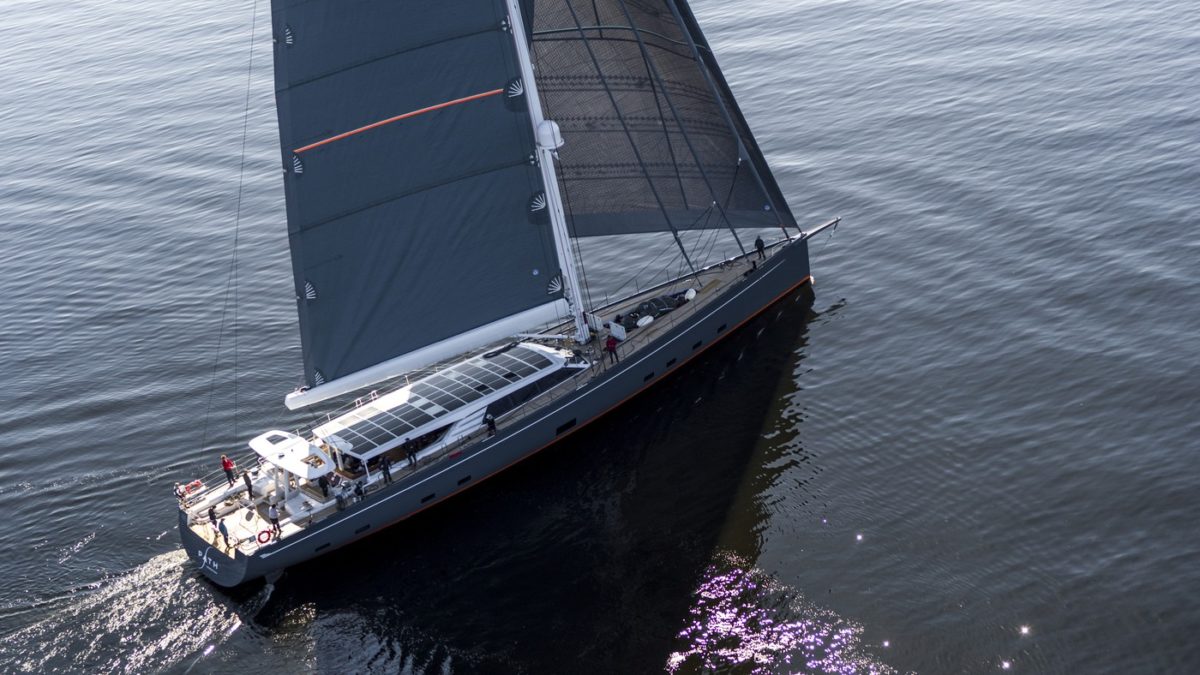
Solar-powered Baltic yacht.
Image: Solbian Solar
Baltic Yachts began delivery in July of its Baltic 146 Path, which includes an 8,714 watt solar rooftop and energy storage system designed by Solbian Solar using the company’s walkable solar modules.
Recently, some of the yacht’s technical work has been shared online. Built from 1,742 monocrystalline solar cells, many of the 86 solar panels were custom cut to fit the deck’s shape by the Solibian team in Italy. The units were based on the company’s Super Rugged (SR) Series .
The SR series has solar cell busbar technology developed by Merlin Solar. In one video, the Merlin team drives over the solar panel, throws bags of cement on it, and even shoots it with a bow and arrow in an effort to prove the product’s resilience. The company said its busbar technology makes this kind of abuse possible.
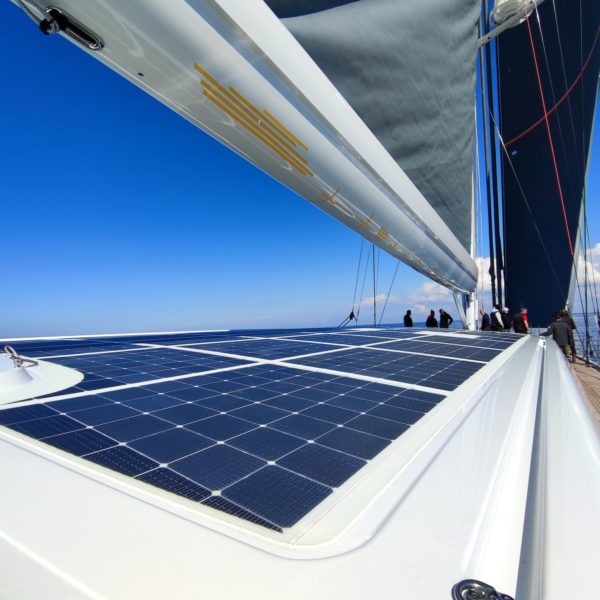
The 60 square meters of solar panels produces 30-50 kWh of energy per day. The company said that’s enough to power all of the onboard electronic equipment–including navigation, autopilot, lighting, and entertainment–for around seven hours.
Once the sun goes down, a Mastervolt MLI 44kWh LiFePO4 battery pack allows the diesel generator mostly to stay off, providing generally silent operation for 14-18 hours.
Baltic Yacht’s solar system is roughly half the size of the Silent 60’s 16.8 kWdc solar plus storage system. The Silent 60 is a solar-propelled yacht less than half the lengthBaltic yacht and price, which reaches 6-8 knots on solar power alone. The Path does not feature electric propulsion and therefore relies on diesel engines when the wind dies down.
Since the Path uses a sail for propulsion, the team installed 154 bypass diodes and 12 solar panel strings and trackers – Mastervolt SCM-60 MPPTS – in an effort to maximize power output and minimize the effect of the sail’s shadows on the panels. The entire solar system, including wiring, controllers and small parts, weighs less than 300kg, the company said
The 146 Path has an overall length of 146 feet. The yacht can accommodate eight in addition to the ship’s owner, as well as eight crew members. Path carries two tenders, an 8hp Torqeedo electric outboard-powered RIB, and a 6.5m twin-engined RibEye. There are also two ultra-lightweight Reverso Match sailing dinghies.
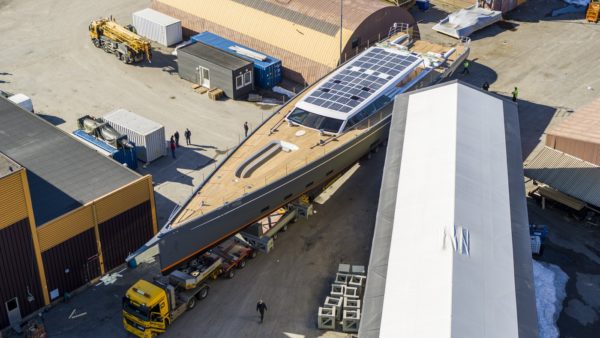
When the front tender is deployed, its storage container can be turned into a pool.
The ship’s main diesel engine is a 405kW (550hp), six-cylinder Scania. The specific model isn’t listed, however the “ DI13 092M IMO Tier III, EU Stage IIIA ” lines up with all of the stats and looks like the unit in a video of the engine being installed.
The owner’s suite includes a sleeping cabin, and an en suite lounge with a glass divider doubling as a movie, tv, and sailing information screen. An upper lounge features a 2.7m-long video wall.
This content is protected by copyright and may not be reused. If you want to cooperate with us and would like to reuse some of our content, please contact: editors@pv-magazine.com .
John Fitzgerald Weaver

More articles from John Fitzgerald Weaver
People on the Move: ACORE, Sunnova Energy, Lighthouse bp, and more
Sandia offers public access to csp archives, related content, elsewhere on pv magazine....
Since it is E propulsion all they have to do to change while sailing is use the motor in regen it’ll generate power back into the pack at much larger amounts. And a small RE fueled generator just in case. As a sailor who does solar, not a chance it’ll get that much from the solar from all the shading from the rigging. More likely 10-30kwh/day. On mine, I made the sails small with 2 masts so I can lower them to not shade the panels.
Any photos of your boat you can share?
Leave a Reply Cancel reply
Please be mindful of our community standards .
Your email address will not be published. Required fields are marked *
Save my name, email, and website in this browser for the next time I comment.
Notify me of follow-up comments by email.
Notify me of new posts by email.
By submitting this form you agree to pv magazine using your data for the purposes of publishing your comment.
Your personal data will only be disclosed or otherwise transmitted to third parties for the purposes of spam filtering or if this is necessary for technical maintenance of the website. Any other transfer to third parties will not take place unless this is justified on the basis of applicable data protection regulations or if pv magazine is legally obliged to do so.
You may revoke this consent at any time with effect for the future, in which case your personal data will be deleted immediately. Otherwise, your data will be deleted if pv magazine has processed your request or the purpose of data storage is fulfilled.
Further information on data privacy can be found in our Data Protection Policy .
pv magazine USA offers daily updates of the latest photovoltaics news. We also offer comprehensive global coverage of the most important solar markets worldwide. Select one or more editions for targeted, up to date information delivered straight to your inbox.
- Select Edition(s) * Hold Ctrl or Cmd to select multiple editions. Tap to select multiple editions. U.S. (English, daily) Global (English, daily) Germany (German, daily) Australia (English, daily) China (Chinese, weekly) India (English, daily) Latin America (Spanish, daily) Brazil (Portuguese, daily) Mexico (Spanish, daily) Spain (Spanish, daily) France (French, daily) Italy (Italian, daily)
- Read our Data Protection Policy .
Subscribe to our global magazine

Most popular
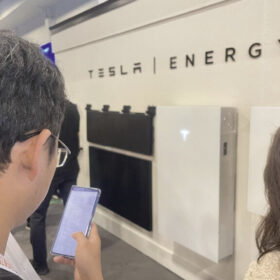
Keep up to date

Silent 60, The Solar Electric Catamaran With a Kite Sail System

The new SILENT 60 solar powered catamaran carries 42 solar panels for 17 kWp of solar energy to power two electric motors of up to 2x340kw. Backed up by a battery capacity of up to 286 kWh, the yacht can cruise efficiently with zero emissions solely on solar power for up to 100 nautical miles a day for weeks.
To further improve its green credentials and range, for longer crossings the first SILENT 60 is also fitted with a compact 9 or 13-sqm kite wing. The kite wing is optionally available on all SILENT models.
How the kite wing works
A dedicated storage locker under the foredeck houses the kite wing and all its components, including an electric winch and a short, collapsible mast. On the first unit the mast is connected by four shrouds to pad eyes on deck that distribute the forces through the hull structure, but on subsequent deliveries (8 units with the kite wing option have been ordered to date) the mast will be mounted on a baseplate inside the locker to leave the foredeck clutter-free.
After inflating the kite, it is released overboard to drift away on the surface of the water. Pulling on the lines launches it into the air and once it reaches the optimal flight height, it begins to trace a figure “8” in the sky and generates power to pull the yacht.
If you want to stop kiting, the automated app controls move the kite to a position right above the boat where it has the least pull on the line. From here it can be winched down electrically and collapsed over the foredeck ready for stowage.

“The main advantages of a kite over a conventional sail system are that it does not throw shade on the solar panels, does not need a tall mast, and generates up to 10 times more power per square metre than a traditional sail. In addition to that it saves about 1,5 tons of weight compared to conventional rigg and costs much less,” says Michael Köhler . “It makes even more sense for the SILENT boats that run on renewable solar energy because the power generated by a kite easily exceeds the energy consumption of the system, so you can charge the batteries while cruising under kite power. And besides that, it’s great fun!”
“We tested the performance on different headings and at wind angles of up to 40 degrees with the 9-sqm kite,” says SILENT-YACHTS’ Captain Mike Wandler . “Unlike a conventional sailing boat, the best results were directly downwind. Under kite power with no engines on or propellers turning, the boat speed was between 4 and 5 knots. We then switched on the electric motors drawing just 1kW each to reduce drag from the propellers and improve the flow of water over the rudders for better steering, this led to boat speeds from 6 to 7 knots over the same headings – a significant improvement on our original predictions.”
A big advantage of a kite compared to a conventional sail is, that the kite flies in much higher altitudes and therefore gets more steady and stronger winds up there. Therefore, it can already be used at low wind speeds of less than 10 knots, when it would not make any sense to hoist a sail on a sailing boat of comparable size.

As the kite rather pulls the boat than pushes it like a conventional sail, it requires good steering capabilities, which are compromised by the fact, that on a motorboat the rudder is typically pretty small and the propeller big. On a sailing boat it is the opposite. For this reason, it is difficult to steer a motorboat that is being pulled by a kite, but by turning on the motors, and by letting them run at a low speeds of 100 rpm this problem can be solved.
But only on a SILENT Yacht it is possible to run the electric motors at such a low rpm powered solely by solar energy and without consuming fossil energy. Any conventionally powered boat would need to run the diesel motors permanently when using the kite.
“At 5 Beaufort we can drive with the kite indefinitely at 6-7 knots, which is faster than a comparable sailing catamaran in such wind condition when crossing the ocean, for example,” adds Michael Kohler .
Different layouts availabls
The first SILENT 60 has four guest cabins on the lower deck, including a spacious master suite, but other layout solutions are available. There are numerous social areas on board, including an airy main salon, an aft cockpit, a cosy bow area and a flybridge. The yacht also has high headroom throughout (up to 2.32m in the main salon).
Thanks to a draft of under 1m the yacht can access shallow bays, a crucial consideration for cruising grounds in the Caribbean and South East Asia. Two swimming platforms in the stern can be extended on owner’s request to carry a pair of electric jet skis. The lifting hydraulic platform between the two platforms can carry a 4 m tender.

Efficient technology
The SILENT 60 is equipped with the company’s ventilation system, which provides cool and fresh air to all the interior guest spaces and can be individually adjusted to suit conditions. In addition, a reverse-cycle heat-pump system cools and heats the interior for all-season comfort. The insulated hull ensures that stable on-board temperatures can be achieved without excessive energy consumption.
A watermaker powered by solar-energy produces enough water to supply a full complement of guests. All on board appliances operate on the 220/110-volt system. The galley has good refrigerator and freezer space and an efficient induction cooker that precludes the need for carrying propane gas.
Group Beneteau: Record full-year earnings in 2023
The countdown has begun for the new ice 66 rs, lagoon 60, freedom of space and panoramic views, setting sail with swan 51: a milestone in performance cruisers, live your passion, subscribe to our mailing list.
Solar power
Electric boats.
- electric boat
I drove a rare solar-electric yacht to test clean-sea propulsion, here’s how it went
While we at Electrek often tend to focus on electric vehicles taking over roads, it’s important to remember that our inevitable abandonment of fossil fuels stems to all modes of transportation, whether it’s by land, air, or even the sea . I recently had the opportunity to set sail on Sunwater Marine’s Ramblin’ Rose , a 40-foot sailing yacht powered by solar panels and electric propulsion. It’s one of the only vessels of its kind on the West Coast.
Sunwater Marine is a San Diego-based nautical transportation company with a keen focus on spreading the benefits of renewable energy and electric propulsion to sea dwellers.
It was founded by president James Richmond in 2020, amid the global pandemic. Richmond had a little more free time to search for a boat for blue water cruising to which he could add solar.
James has been sailing for over 50 years, and has nearly 40 years of experience in the renewable and energy-efficiency industry.

He soon found a 2015 Leopard 40 Catamaran and initially planned to simply add solar panels for an electric range and an energy-efficient water maker.
However, James soon discovered viable options for electric propulsion, and began researching the possibility of converting his new yacht to be be solar-electric.
The result is the Ramblin’ Rose , a catamaran that can haul 12 passengers and sleep up to nine. It also happens to be one of the only solar-electric yachts in the West Coast.
I got the chance to take the solar-electric yacht out of beautiful Coronado and test the technology out myself.

The Ramblin’ Rose solar-electric yacht
As previously mentioned, Sunwater Marine’s Ramblin’ Rose is centered around a Leopard 40 catamaran, built by Robertson & Caine in South Africa. Richmond then put an additional $100k into a renewable energy conversion, equipping the yacht with solar panels, and electric motors.
While the original catamaran came with some traditional solar panels, Richmond’s experience in renewable energy told him that would not suffice for his solar-electric yacht.
He added lighter and more flexible solar technology from Sunflare , the first company to successfully mass-produce thin, durable CIGS (copper indium gallium selenide) solar panels.
The Sunflare panels on the Ramblin’ Rose operate individually with their own bypass diode, so if one is shaded (by the sail for example), the rest still work.
Richmond also separated the solar panels into three separate zones, so if one side of the boat is shaded, the other two are still harnessing the sun’s power back into the boat’s batteries.
He also showed me how durable these advanced solar panels were, as I was able to walk around on top of them without worrying about breaking any glass or ruining them.
The panels help charge the electric yacht’s battery packs while out sailing and indicate to the captain when they are doing so.
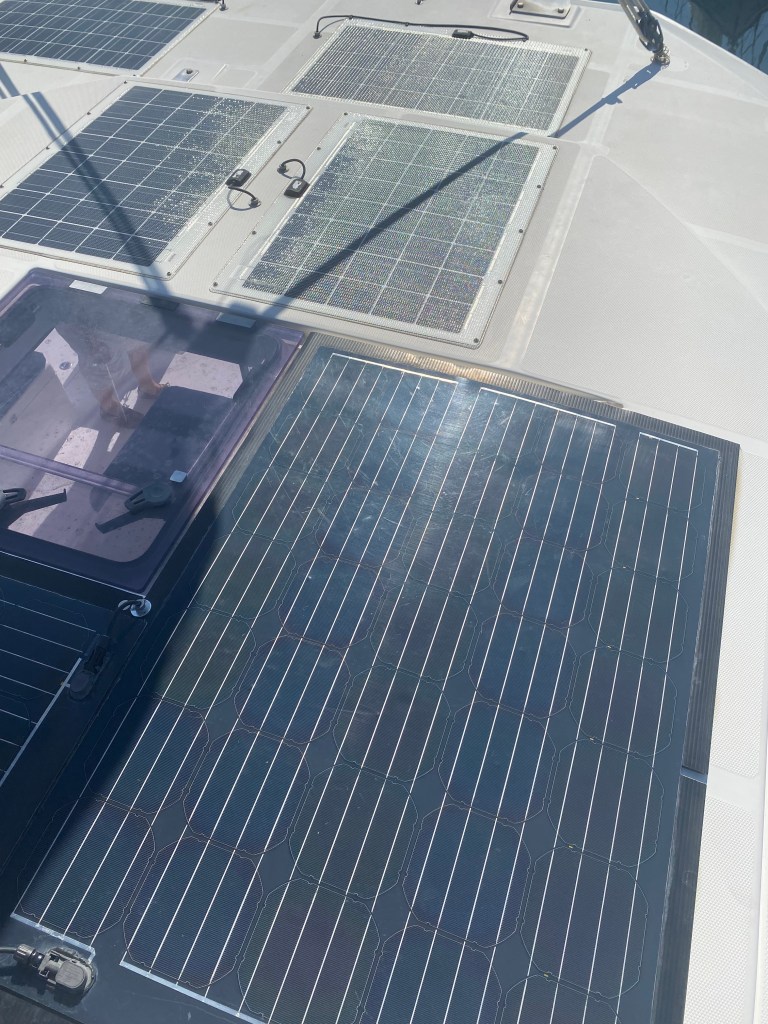
Electric propulsion and battery packs
To help power this vessel in and out of the marina and on the sea, Sunwater Marine’s president researched electric propulsion systems around the world, and decided that OCEANVOLT was the best option.
The solar-electric yacht now features two OCEANVOLT 15 kW ServoProp sail drives , utilizing unique propeller blades that can change pitch to optimize efficiency and even regenerate power.
The software controlled variable system adjusts the pitch of each of the propeller blades automatically, so that the power generation and output are always optimal. This is much more efficient than traditional fixed propellers.
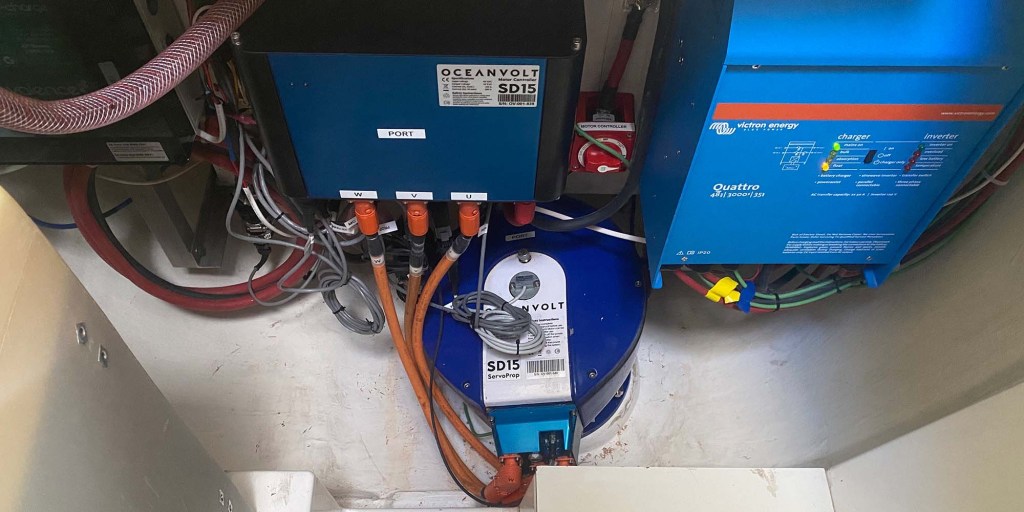
The electric propulsion is powered by a 48 volt system, meaning it’s safe to touch without electrical shock (an ideal situation for maritime fun).
Each electric motor on the yacht is powered by a bank of 12 Lithium Iron Phosphate (LFP) batteries on each side, 24 total. The batteries provide 21 kWh of power on each side of the vessel, 42 kWh in total.
Richmond explained that he positioned each battery pack eight inches off the bottom of the boat, too, so if any water were to come in, the batteries would still be OK. Furthermore, the captain showed me backup storage of eight additional batteries should anything go awry at sea.
The status of each and every battery is monitored 24/7 by a supervisory battery management system (BMS) that will shut the battery bank down, should any individual battery begin to malfunction. Fire is not something you want on a boat, despite being surrounded by water.
Additionally, the system was implemented to safely operate minimal electric functions under any conditions, so if the electric yacht were to tip over, there would still be power to send a distress signal.
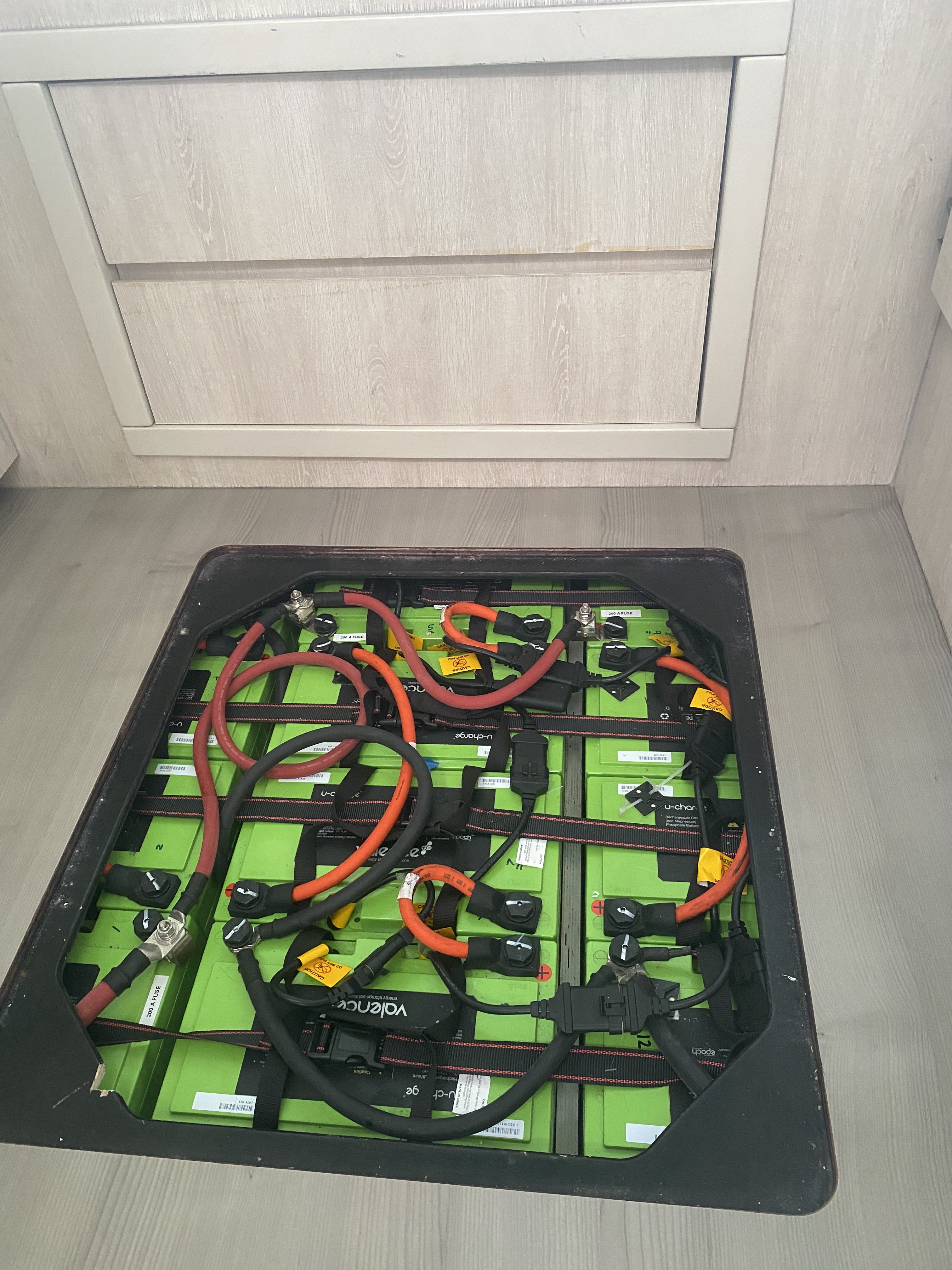
Thoughts on the future of electric propulsion
After manning the helm of the the Ramblin’ Rose , there is a lot to be excited about for the future of electric propulsion at sea , especially on a gorgeous yacht.
The ride itself was eerily smooth and quiet compared to diesel motors, with zero vibration throughout the boat. If you didn’t look back and see the wake of the electric motors, you might not even notice the yacht was being propelled.
There is a lot of potential in electric propulsion, especially as it pertains to propellers than can remotely change their angle like the OCEANVOLT ServoProps. This makes reversing the electric yacht in particular, much easier for captains compared to fixed props built to push forward.
The ability to set sail and regenerate power from the propellers is also a huge perk and pairs nicely with the advanced solar panels. Plus, you always have shore power as a backup when you’re in a pinch.
From what I’ve seen, the biggest hurdle looking ahead will be battery capacity, and providing enough stored energy to power the electric propulsion systems on the yacht.
The solar panels do help a lot, but it’s a relatively slow process. Smaller, lighter battery options will be crucial for longer distances at higher speeds at sea someday. In the meantime however, we still have sun and wind to pick up the slack.
Currently, the range and top speed are still limited by this lack of surplus energy below deck. We didn’t take the Ramblin’ Rose above 7.5 knots (~8.6 mph) because we didn’t want to burn through all our battery life (that was also in respect to the charter setting sail after us that day).
The solar-electric yacht still has diesel motors onboard for emergencies, but Sunwater Marine’s founder agreed with me that we’d like to see a day when those motors are not needed at all. Unfortunately, the technology is not quite there yet.
Luckily, people like Richmond and Sunwater Marine are using their knowledge and resources (and personal funds) to figure this stuff out for the masses, while spreading the word about electric propulsion. It has become a genuinely viable option at sea, even if it is only in support of other forms of propulsion like sailing for now.
If you’re ever visiting the San Diego area, I highly recommend reaching out to Sunwater Marine and chartering the Ramblin’ Rose , or one of the other solar-electric yachts Captain Richmond is working on.
FTC: We use income earning auto affiliate links. More.


Scooter Doll is a writer, designer and tech enthusiast born in Chicago and based on the West Coast. When he’s not offering the latest tech how tos or insights, he’s probably watching Chicago sports. Please send any tips or suggestions, or dog photos to him at [email protected]
How Do Solar-Powered Boats Work? 7 Innovative Vessels That Run on Solar
Solar boats can serve ordinary functions for more sustainable transportation.
David Kuchta, Ph.D. has 10 years of experience in gardening and has read widely in environmental history and the energy transition. An environmental activist since the 1970s, he is also a historian, author, gardener, and educator.
:max_bytes(150000):strip_icc():format(webp)/professional-headandshoulders-b7be2761c16e44438607bf932fc1993c.jpg)
- Wesleyan University, University of California, Berkeley
:max_bytes(150000):strip_icc():format(webp)/ScreenShot2021-04-07at1.57.45PM-bcef177316c94cdf998457c694cce6d5.png)
- University of Tennessee
Finnbarr Webster / Getty Images
- Renewable Energy
- Fossil Fuels
When Greta Thunberg crossed the Atlantic in 2019 to address the 2019 UN Climate Action Summit, she sailed aboard the Malizia II , a racing yacht powered by hydro, solar, and sail. The Malizia II raised the international profile of powering boats with renewable, carbon-free energy.
Installing solar panels on the Malizia II and other boats is a challenge. The panels and electronic equipment can be exposed to corrosive saltwater, strong winds, and extreme weather conditions. The panels must conform to the shape of the vessel, but cannot interfere with the work of the crew. Fortunately, these are challenges that many boat owners have overcome. In a growing industry, flexible solar panels capable of being installed on a boat can cost as low as $200 . Solar power isn't just for high-end racing yachts.
One of the virtues of a solar-powered boat is its infinite range when paired with lithium-ion batteries on board, which can store the energy produced by the solar panels. Like a sailboat, a solar-powered boat never needs to make refueling stops.
Spurred on by competitions like the Solar Splash (which calls itself “the World Championship of Collegiate Solar Boating”), the Solar Boat Regatta , the Dutch Solar Challenge , and Solar Sport One , engineers and innovators in sustainable transportation have turned solar-powered boats from a novelty item on the sea to vessels that can serve many functions.
The Malizia II
Mark Lloyd/Alea / Getty Images
The Malizia II is a 60-foot (18-meter) monohull boat weighing 8 tonnes. It was launched in Monaco in 2015. While it has participated in a number of races and regattas, it is best known for transporting Greta Thunberg to the United Nations Climate Action Summit in 2019. But it was built for racing—capable of speeds of up to 25 knots, it is one of the fastest boats of its class.
The Solliner
The Solliner is a line of small catamarans meant for day boating, from Green Dream Boats . At 21 feet (6.2 m), it can accommodate up to 10 people in a U-shaped seating area. They are fitted with four solar panels that allow for navigation without the need for an outside energy source. They can sail at up to 12 km/hr. Solliner boats have been seen around the world, such as the one pictured here in Poland. In the United States, they are sold by Infinity Solar Boats.
Samarjitbharat / Wikimedia Commons / CC BY-SA 4.0
The Aditya is India's largest solar boat and the world's first solar-powered ferry. Carrying approximately 1,700 passengers per day , it is 30 times cheaper to run than the diesel ferry it replaced. In 2020, it won the Gustave Trouve Award for Excellence in Electric Boats and Boating, an international award. The Indian state of Kerala, which commissioned the Aditya , plans on replacing the entirety of its diesel fleet with solar ferries. The Aditya is a 20-meter-long catamaran ferry boat made from glass-reinforced plastic with photovoltaic panels on its roof. It seats 75 passengers at a time.
The Interceptor
The Interceptor sounds like a racing boat, but it is a 24-meter (78 ft) solar-powered barge whose role is to intercept 50 tons of trash a day from Malaysia's rivers—most of it plastic that would otherwise reach the sea. The Malaysian Interceptor is one of a series of Interceptors created by The Ocean Cleanup , the largest effort to remove plastic waste from the oceans, 80% of which stems from 1,000 of the world's rivers. Other Interceptors are (or will be) stationed in Indonesia, the Dominican Republic, and Vietnam.
MS Tûranor PlanetSolar
Pascal Le Segretain / Getty Images
A 31-meter catamaran, the MS Tûranor PlanetSolar is the world's largest solar boat and the first to sail around the world. On its round-the-world voyage, it sailed at an average speed of 5 knots—not racing yacht speed, to be sure, but to be expected from a 6-meter-wide scientific research vessel weighing 89,000 kg (nearly 100 tons), 8.5 tons of which are lithium-ion batteries stored in the ship's two hulls. It was launched in 2010.
The 537 square meters of solar panels are sturdy enough to be walked on, and provide electricity stored in 6 blocks of lithium-ion batteries, allowing the Tûranor PlanetSolar to travel over 60,000 km (37,282 m) in 584 days without fuel stops.
The Ecowave
The Ecowave ( Ecowolna ) is Russia's first solar-powered catamaran. In 2018 it conducted a scientific expedition to explore the potential for solar-powered trams for the Neva, Oka, and Volga rivers. Launched from St. Petersburg, the Ecowave expedition covered more than 5,000 km (3,106 m) over 90 days, traveling the Black and Caspian Seas as well as major rivers of Russia. The catamaran is 11.6 metres long.
The solar panels cover an area of solar panels is 57 square meters (613 sq ft) and are capable of producing 9 kW of power. Lithium-ion batteries allow the vessel to sail for 20 hours without recharging.
While apparently no longer plying the waters of the Lot river in France, the Kevin was a solar-powered hotel boat that offered river cruises focused on sustainable river tourism. Calling his converted barge “ the first solar boat-hotel of the world ,” owner Dominique Renouf launched Kevin in 2011. The vessel was 97 feet (29.50 m) long, equipped with a solar water heater, and able to accommodate 14 overnight passengers in 6 cabins.
4FR / Getty Images
Solar-powered boats can be as humble as tour boats on Turkey's Lake Eğirdir or on Lake Altaussee in the Austrian Alps. Like ferries, tour boats are ideal candidates for solar power, as their regular routes allow for batteries to be sized with enough electricity to power voyages of days when the sun isn't shining.
Solar boats have barely entered the mainstream boating market, but the technology is within the financial reach of most boat owners, as the cost of solar panels has dropped precipitously over the past decade. Any boat with a large-enough surface exposed to the sun can attach solar panels to it, and with a little wiring and (optionally) battery storage, infinite sailing is an increasingly affordable possibility.
" Largest Solar-Powered Boat Completes Around the World Voyage ." Guinness Book of World Records , 2012.
- What Is Greener? Boat vs. Plane Emissions
- Best of Green Awards 2021: Eco Tech
- Best of Green Awards 2021: Sustainable Travel
- The 7 Best Solar-Powered Generators of 2024
- How Do Solar Panels Work?
- What Are Solar Trees? How Do They Work?
- What Are Solar Shingles? How Do They Work?
- Solar Ovens: What Are They? How Do They Work?
- How Do Solar Windows Work?
- Do Solar Panels Work on Cloudy Days? At Night?
- Do Solar Panels Work When It Snows?
- How Do Solar Lights Work? Types, Uses, and Environmental Impacts
- Solar Water Heaters: What You Should Know
- How Does Solar Battery Storage Work?
- What Is Passive Solar Heating? How It Works and Limitations
- What Is Solar Charge Controller? Do You Need One?
- Hiking Shoes
- Hiking Boots
- Hiking Sandals
- Trail Runners
- Base layers
- Hiking Shirts
- Fleece Jackets
- Softshell Jackets
- Rain jackets
- Down Jackets
- Hiking Pants
- Hiking Shorts
- Base Layers
- Rain Jackets
- Hiking Bras
- Baby Carriers
- Cookware Sets
- Water Filters
- Water Purifiers
- Sleeping Bags
- Sleeping Pads
- Hiking Poles
- GPS Devices
- Solar Chargers
- Dive Regulators
- Dive Computers
- Dive Watches
- Dive Wetsuits
- Dive Gloves
- Dive Lights
- Dive Knives
- Spearfishing Wetsuits
- Spearfishing Masks
- Spearfishing Fins
- Spearfishing Watches
- Freediving Wetsuits
- Freediving Masks
- Freediving Fins
- Freediving Watches
- Sit On Top Kayaks
- Inflatable Kayaks
- Fishing Kayaks
- Tandem Kayaks
- Touring Kayaks
- Kayak Paddles
- Kayak Seats
- Kayak Roof Racks
- Kayak Carts
- Stand Up Paddle Boards
- Touring SUPs
- Inflatable SUPs
- Fishing SUPs
- SUPs For Yoga
- SUPs For Surfing
- SUP Paddles
- Climbing Boots
- Belay Devices
- Climbing Shoes
- Women's Climbing Shoes
- Bouldering Shoes
- Approach Shoes
- Climbing Pants
- Bouldering Pants
- Mountain Bikes for Men
- Mountain Bikes for Women
- MTB Handlebars
- Bike Saddles
- Bike Computers
- Bike Lights
- MTB Jackets
- Bike Helmets
- Bike Packing Gear
- Fat Biking Gear
- Ski Bindings
- Ski Helmets
- Ski Goggles
- Ski Jackets
- Snowboarding Bindings
- Snowboarding Boots
- Snowboard Helmets
- Snowboard Goggles
- Snowboard Pants
- Snowboard Jackets
- Snowshoe Poles
- Avalanche Beacons
- Avalanche Probes
- Avalanche Shovels
- Ski Backpacks
- Surfboards For Beginners
- Surfboards For Kids
- Surfboard For Small Waves
- Soft Top Surfboards
- Foam Surfboards
- Body Boards
- Boogie Boards
- Kiteboarding Kites
- Kitesurfing Boards
- Kiteboarding Harnesses
- Surfing Wetsuits
- Men's Rash Guards
- Women's Rash Guards
- Board Leashes
- DLSR Travel Cameras
- Mirrorles Travel Cameras
- Point and Shoot Travel Cameras
- Fuji Travel Lenses
- Nikon Travel Lenses
- Tripods for Travel
- DLSR Landscape Cameras
- Mirrorles Landscape Cameras
- Point and Shoot Landscape Cameras
- Fuji Landscape Lenses
- Nikon Landcape Lenses
- Canon Landcape Lenses
- Tripods for Landscape Photo
- Wildlife Cameras
- Wildlife Lenses
- Wildlife Tripods
- Wildlife Monopods
- Birdlife Cameras
- Birdlife Lenses
- Surfboards For Small Waves
Best Solar Panels For Sailboats of 2024
Sailing uses the power of the wind to move, so why not use the power of the sun to charge your batteries? Solar panels offer the best way to charge boat batteries. This method can also save the engine from being used just for charging. Getting the best solar panels for sailboats means choosing the right size and power for your boat.
But, how much power will you need? Will your panels be able to keep up even on cloudy days? Do you plan to sail in cold water or deep in the tropics? Do you need the panels to sit on a curved surface? There’s a surprising amount of factors to consider when purchasing sailboat solar panels.
Whether you’re replacing old panels or buying for the first time, let us do the hard work of comparing the best solar panels for your boat.
For more of our top sailing gear recommendations, check out the Best Wind Generators for Sailboats .
QUICK ANSWER – THE BEST SOLAR PANELS FOR SAILBOATS
- Nature Power Monocrystalline
- Nature Power Rigid
- Renogy Starter Kit (4 panels)
- Newpowa Poly Solar Panel
- Acopower Polycrystalline
- Nature Power 90W Rigid
- Newpowa 150W
- Suaoki SunPower
- Eco-Worthy Semi-Flexible
SAILBOAT SOLAR PANEL REVIEWS
Nature power monocrystalline.
Check out the latest price on: Amazon | West Marine
BEST FOR: Efficient high-power use
WEIGHT: Unspecified
WATTS/AMPS: 120W/6.6A
SIZE: 45.1” x 33.6” x 3”
PROS: Foldable for easy storage and portability, pop-out legs that allow it to easily sit at an angle, sturdy design
CONS: On the upper end of the price spectrum, short warranty
NATURE POWER RIGID
BEST FOR: Energy-hungry boats
WATTS/AMPS: 165W/9.4A
SIZE: 57.8” x 26.3” x 1.4”
PROS: Powerful and efficient, scratch resistant and anti-reflective coating, well-built aluminum frame, easy-to-use connections
CONS: Powerful but expensive, only suitable for larger boats with a big flat space to set it up on
RENOGY STARTER KIT (PACK OF 4 PANELS)
Check out the latest price on: Amazon
BEST FOR: Large boats needing lots of power
WEIGHT: 18.0lbs
WATTS/AMPS: 400W/22A
SIZE: 4 x 47.0” x 21.3” x 2.0”
PROS: Includes x4 100W panels along with a charge controller and everything else needed to set up, ideal for sailors looking for a lot of power, easy mounting system, great price for a comprehensive kit
CONS: Rigid solar panels can only be on flat surfaces or mounted on rails, included charge controller might not be the charge controller for your needs
NEWPOWA POLY SOLAR PANEL
BEST FOR: Keeping small battery banks topped up
WEIGHT: 6.3lbs
WATTS/AMPS: 30W/1.7A
SIZE: 27.0” x 14.3” x 1.9”
PROS: Sturdy design, small and slim making it ideal for stern rail, wattage should be enough to trickle-charge medium battery banks, very affordable
CONS: Rigid design means placement is limited, heavy for a small panel
ACOPOWER POLYCRYSTALLINE
BEST FOR: Larger sailboat trickle-charging
WEIGHT: 6.9lbs
WATTS/AMPS: 35W/2A
SIZE: 29.9” x 16.1” x 1.7”
PROS: Looks neat with silver aluminum frame, should be able to easily keep batteries topped up and contribute to energy requirements when boat is in use, very affordable and slim, other wattages available
CONS: Weighty, aluminum frames can have sharp corners
NATURE POWER 90W RIGID
Check out the latest price on: West Marine
BEST FOR: Permanent mounting
WEIGHT: 15.2lbs
WATTS/AMPS: 90W/4.9A
SIZE: 33.7” x 26.5” x 1.0”
PROS: Sturdy frame can be mounted on gantry rails permanently, good power output and small enough to be mounted alongside an identical panel for double power, long warranty, reputable brand
CONS: Awkward to move about the deck so not ideal for portable panel, fairly heavy
NEWPOWA 150W
BEST FOR: Medium to large sailboats
WEIGHT: 24.4lbs
WATTS/AMPS: 150W/8.3A
SIZE: 58.4” x 26.6” x 1.2”
PROS: Great for permanent mounting, powerful and well-built,
CONS: Very heavy, only comes with 3ft of cable which may well be too short and require extension
SUAOKI SUNPOWER
BEST FOR: Smaller, lightweight sailboats
WEIGHT: 4.8lbs
WATTS/AMPS: 100W/5.6A
SIZE: 43.3” x 22.4” x 0.1”
PROS: 30-degree curve possible making this ideal for boat coach roofs, very thin makes for less dirt buildup and less wind resistance, good price for a powerful panel
CONS: Cable connections are on the top of the panel which may encourage corrosion and UV damage
ECO-WORTHY SEMI-FLEXIBLE
BEST FOR: Coach roofs and curved deck areas
WATTS/AMPS: 100W/5.5A
SIZE: 47.4” x 21.6” x 0.1”
PROS: Capable of a 30-degree curve making it suitable for coach roofs and curved decks, thin and durable construction
CONS: Connector on top allowing salt build-up and accidental damage
COMPARISON TABLE – THE BEST SOLAR PANELS FOR SAILBOATS
How to choose the best solar panels for sailboats, 1. required energy.
Buying solar panels for your sailboat involves more than going over a few models at random. You need to know how much power you’ll need daily. Also, you need to determine whether you will rely solely on solar power or use the engine as well.
SOLAR AND ENGINE
Will you use solar power most of or all the time? If yes, then you will need higher power, larger or more solar panels. If you plan to use the engine more, then you won’t need as much solar power.
Your sailing goals come into play in this decision. If you want to cruise the intercoastal waterways, chances are you’ll be using your engine a lot. If you plan on cruising the Caribbean, you can often rely on good winds for sailing.
Once you’ve worked out how you plan on powering your sailboat – solar and engine, or just solar – you’ll need to work out your daily amp draw . If you’ll be running a fridge, freezer, water maker, VHF and SAT NAV all day long, you’re definitely going to need a lot of power!
It can be difficult to determine how many amps your sailboat will need, especially if you still don’t have all the electronics you plan to bring on board. Some products will give you an idea of their power draw in their technical specifications. For others that don’t provide that information, you may have to settle for an estimate.
Once you have an idea of your daily amp draw, then you can work out the solar output required to keep up with that power draw. But there are other considerations too, namely, actual output vs maximum output.
ACTUAL OUTPUT VS MAXIMUM OUTPUT
While a 90W solar panel might sound like it’ll give out 90W, remember that this is its maximum output. That is, it refers to a clean panel in full sunshine. It won’t be giving anywhere near that output on cloudy days. In the case of a fixed panel, ask yourself if the sail will be casting a shadow over it on one tack.
Unless you plan on running the engine to top up the batteries on cloudy days, you will find yourself needing enough solar panel output for these times. Make sure to also consider the times when your panels aren’t giving out their optimum performance.
TEMPERATURE CHANGES
If you’re starting in Nova Scotia, your fridge won’t take much power to keep it at a cool temperature. But, what happens when you sail south to go diving in Mexico ? Suddenly, the water temperature is higher and the fridge would have to work twice as hard to stay cool. While good insulation is a bonus on a sailboat, it’s important to remember that atmospheric changes like temperature may mean an increase (or decrease) in your power requirement.
ARE WE TALKING AMPS OR WATTS?
While you need to know how many amps your sailboat will draw on a daily basis, solar panels are sold by watts. There’s no need for that to be confusing though, as we’ve also provided the amps in the chart. You can read more about watts and amps to get a better understanding.
2. HOW MANY SOLAR PANELS DO YOU NEED?
Many sailboats have more than one solar panel. This means you won’t need to move the panels to follow the sun or as the boat shifts at anchor. Having multiple solar panels also allows you to have smaller panels, which tend to get in the way less. Your required power output can be divided among them as well.
If you need 200W a day, then you could have three 90W solar panels on different parts of the boat and be covered power-wise, even on different tacks.
How much space do you have on deck? Where you place your solar panels is very boat and sailor dependent. Day-sailing in hot places? Solar panels on the bimini rack are an easy solution. Long-distance cruising? You’ll need solar panels that are efficient yet out of the way to improve windward performance.
If you spend a large amount of time on board, your energy consumption will be higher. You’ll need your solar panels to be as efficient as possible. Many cruisers have panels on top of gantries on the stern to keep them in sunshine all the time. This is terrible for sailing performance, so you have to think about where you want to compromise. Don’t forget to consider the other on-deck items, such as your paddle board , as well.
Solar panels generally come in two types: mono- and multicrystalline and amorphous thin film silicone. However, all solar panels listed in this article will be mono- or multicrystalline as they are the most effective.
MONO- AND MULTI-CRYSTALLINE
Efficient and sturdy, these panels will probably make up your core solar panel collection. For everything on board like lights, fridge, radio and navigation electrics, mono-and multicrystalline are your best bets. They aren’t forgiving on cloudy days though, and even a shadow over the corner of a panel will pull down the output by a lot.
AMORPHOUS THIN FILM SILICONE
Not as efficient as crystalline panels, amorphous panels are cheaper and flexible. They’re good for trickle-charging batteries while the boat is left unattended.
Solar panels are expensive, but their prices have been dropping over the years. If you only use your sailboat for summer weekends, chances are you won’t need pricey, hyper-efficient panels. You just need enough to keep up with your power consumption for two days a week and let the trickle-charge solar panel do the rest.
Take your solar panel budget and split it between the number of solar panels you think you’ll need. Keep in mind though that you’ll most likely need to buy a charge controller as well.
For more of our top sailing gear recommendations, check out these popular buyer's guides:
Sailboat Anchors
Sailboat Winches
Sailing Shoes
Solar Panels for Sailboats
Bilge Pumps
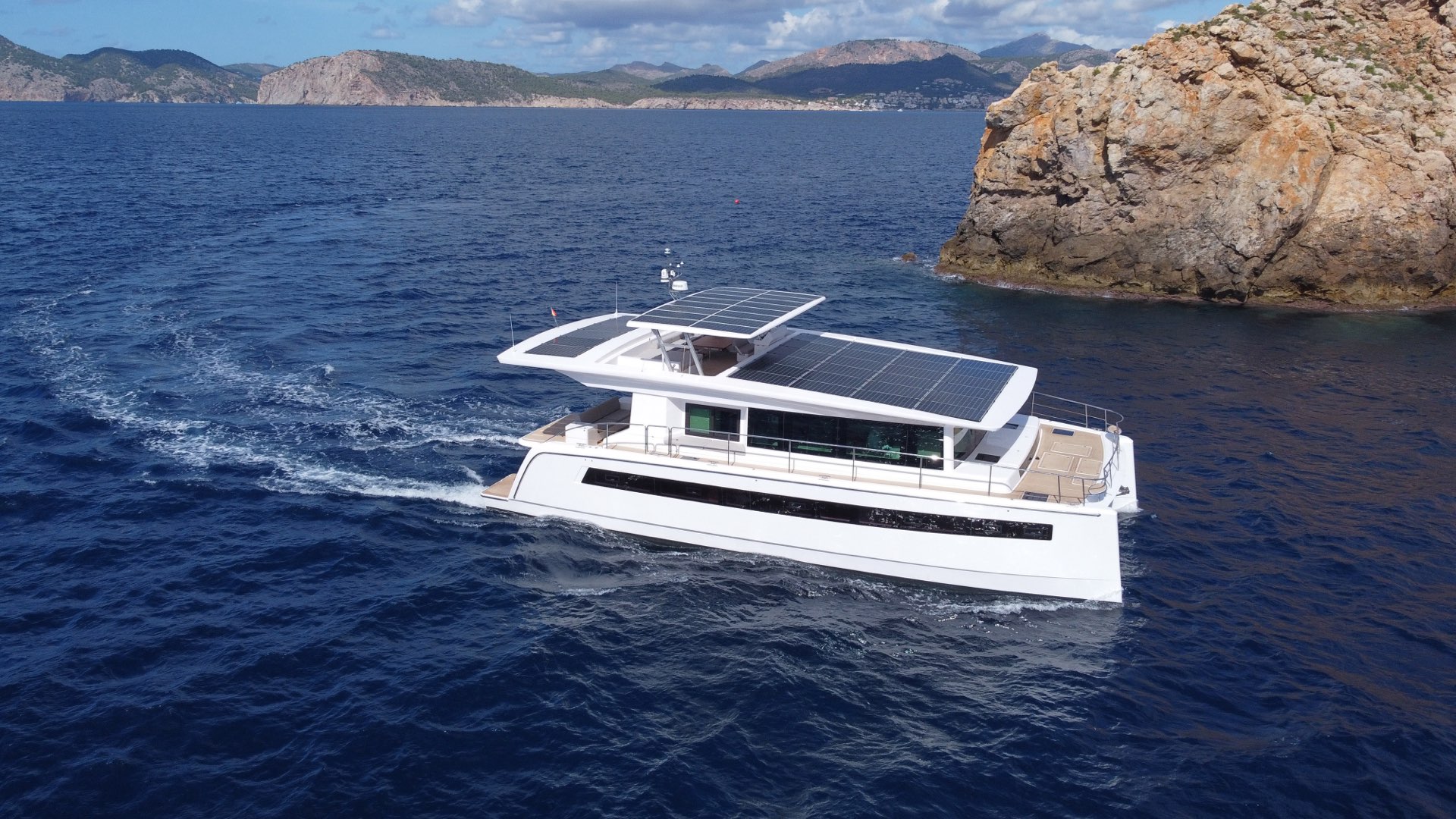
Silent Yachts
Creators of the world’s first series produced, solar-powered electric yachts.
Unlimited Range
Noiseless cruising, zero emission, minimal maintenance, pioneering solar powered yachting since 2009.
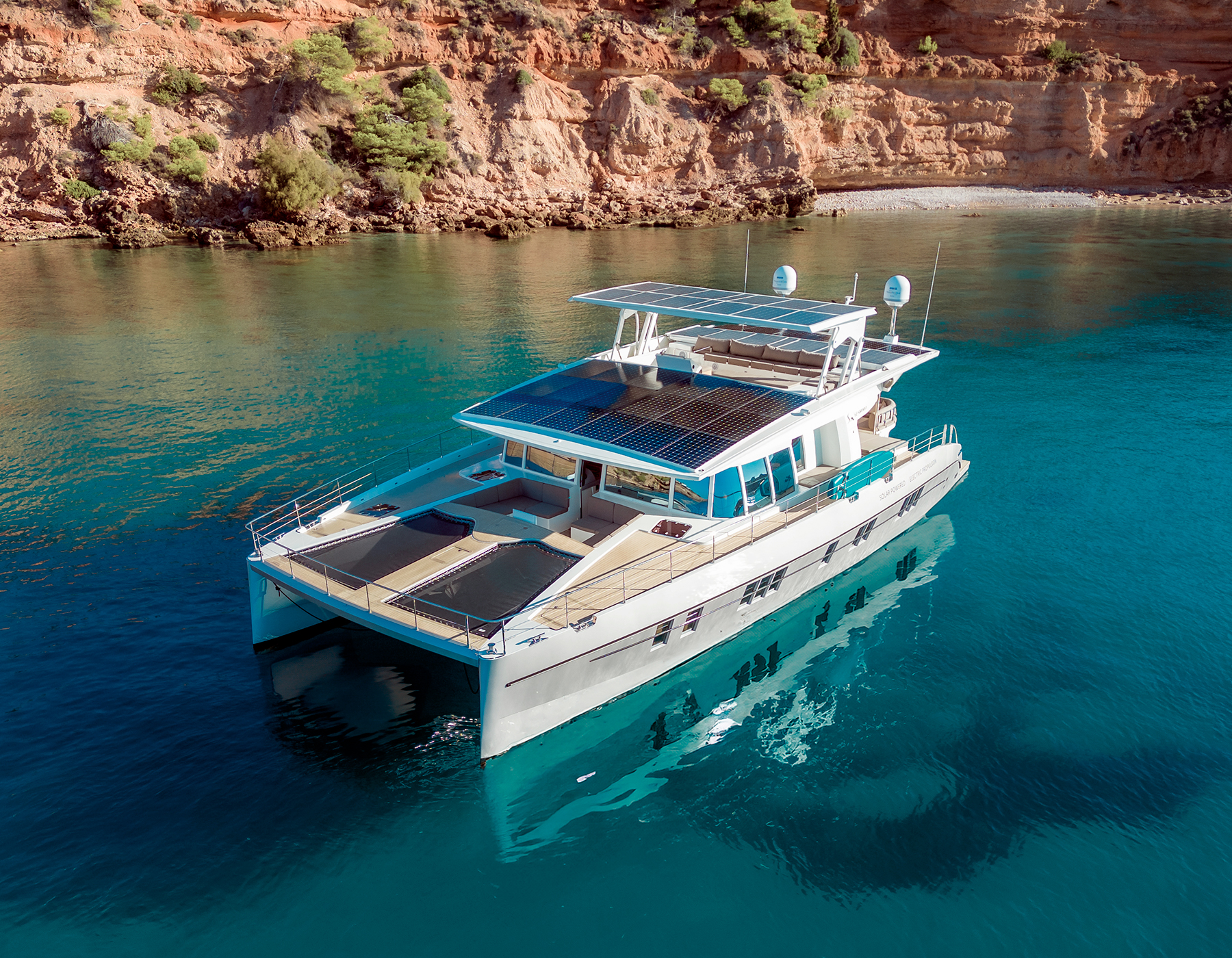
The Original Solar Yacht
As the original inventors of series produced solar-electric yachts, we pioneered this innovative approach. Our first model, the Silent 64, was launched to the market in 2016, several years before any other shipyard considered the possibility of going electric.
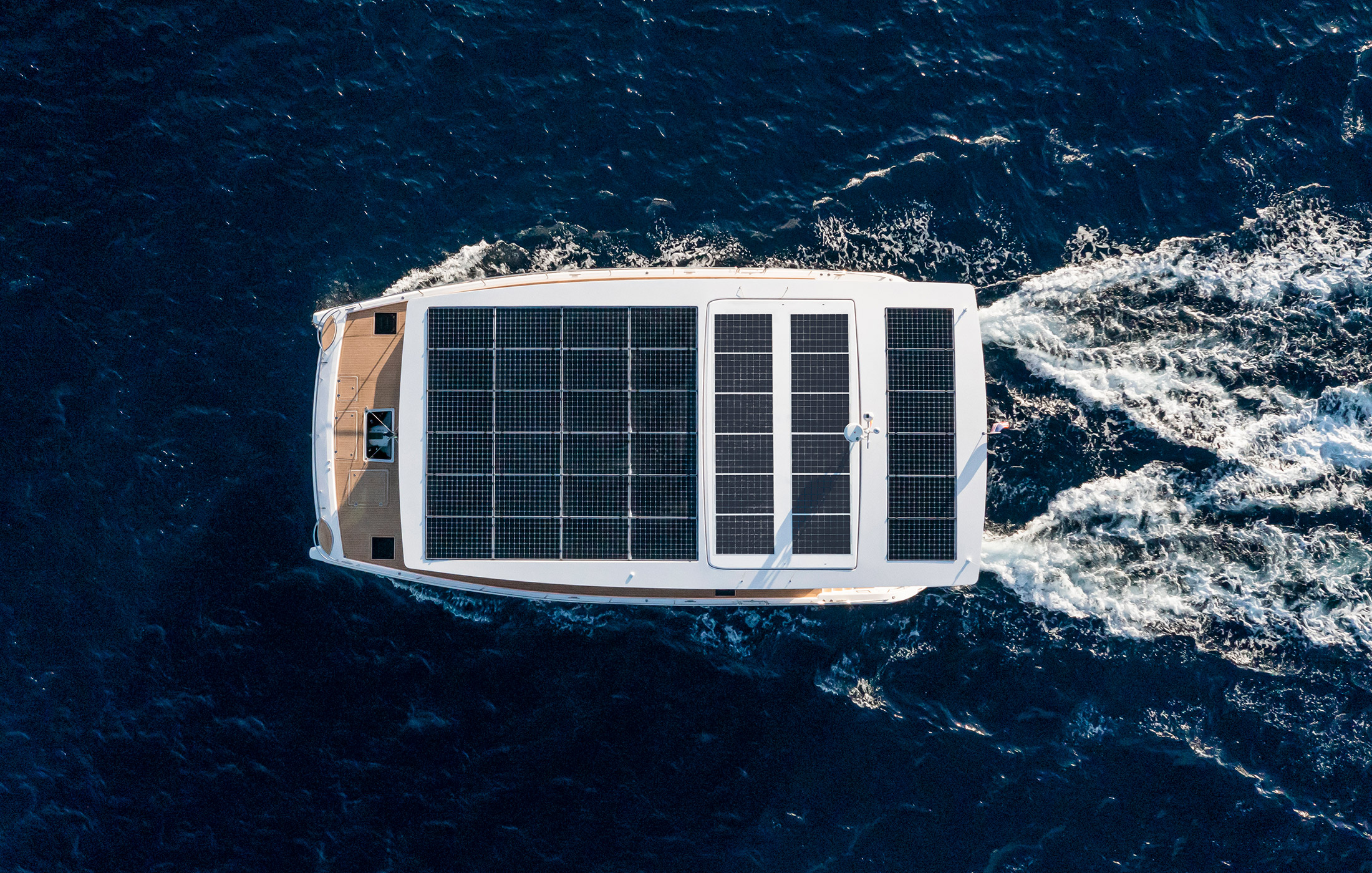
Leading Technology
Our founders began to research alternative energy sources to power yachts during the mid 1990s. Today, the technology of our in-house developed solar-electric drivetrain has been perfected and is multiple generations ahead in terms of reliability, performance and efficiency.
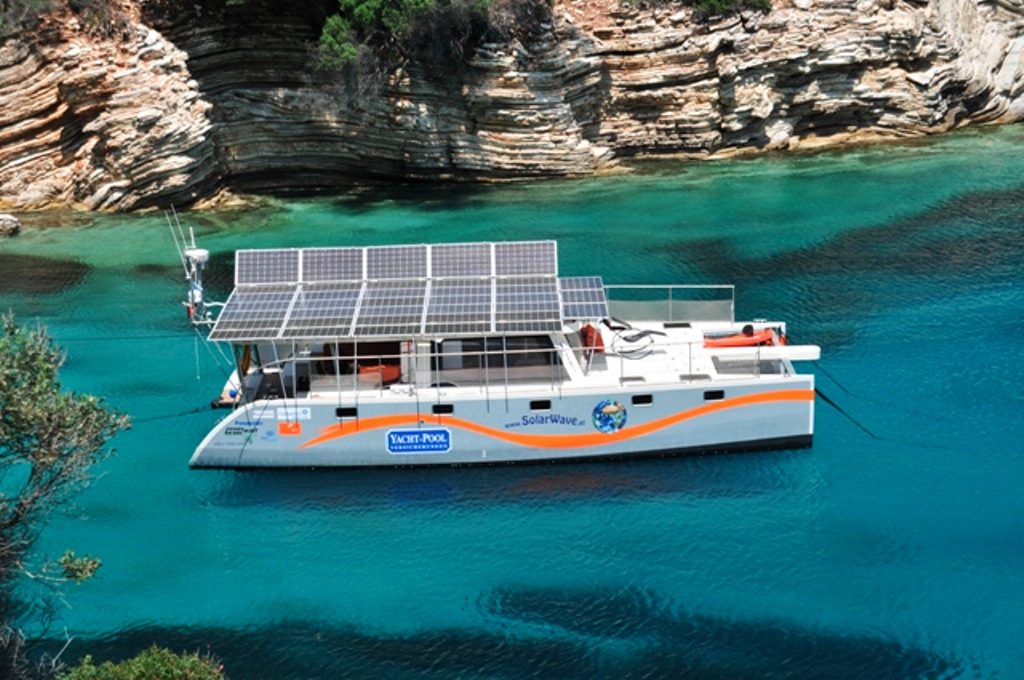
Historical Track-Record
In 2009, the Solarwave 46 was launched as our first prototype of a fully solar-electric, self-sufficient ocean-going catamaran. Since then, our electric yachts have cruised many 10.000s of nautical miles, performing flawlessly during a variety of weather conditions.
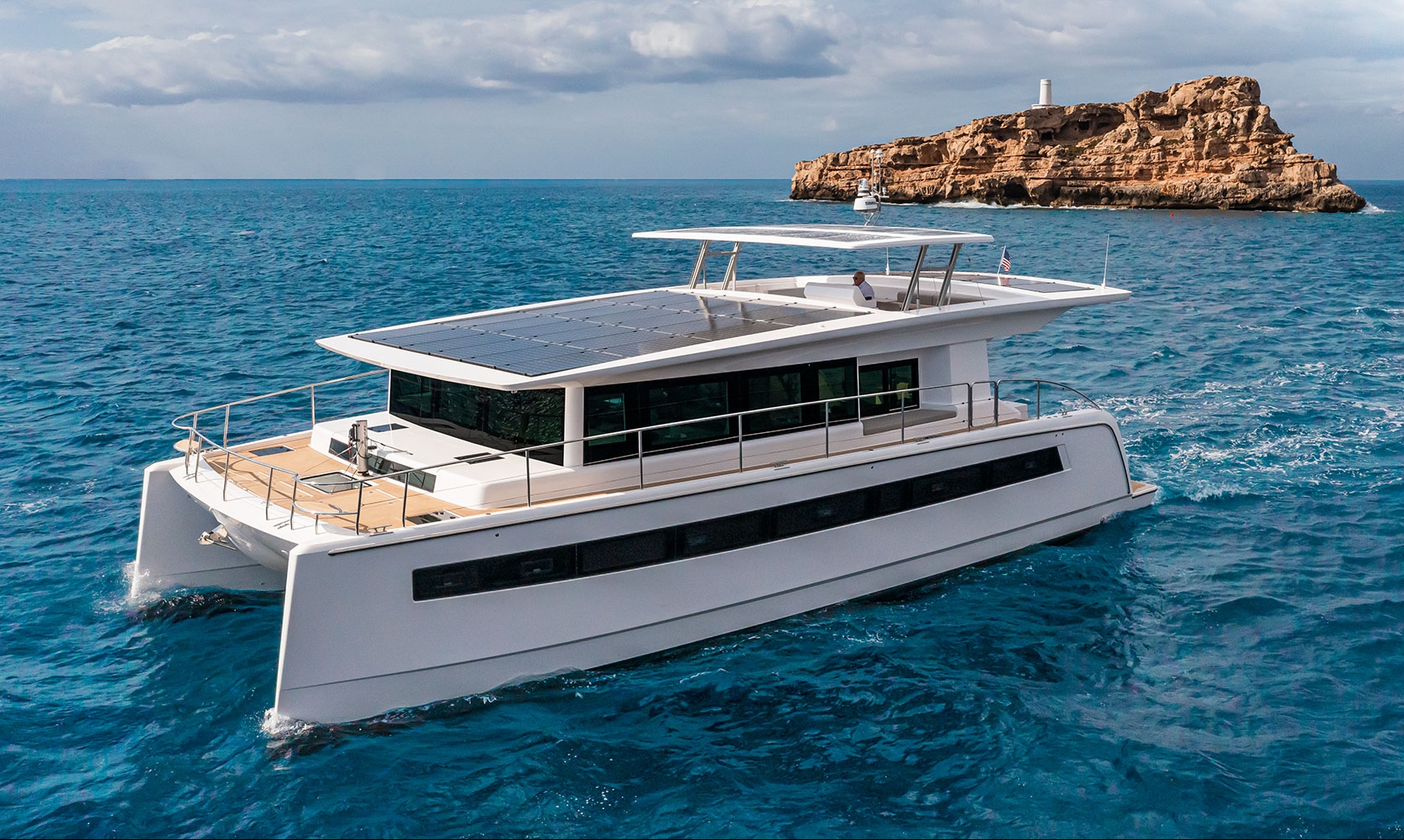
Enabling Self-Sufficiency
What differentiates a Silent is the unprecedented level of autonomy provided by our yachts. Being able to produce your own energy enables a fully self-sufficient lifestyle on board. Travel the oceans sustainably while making them your infinite playground.
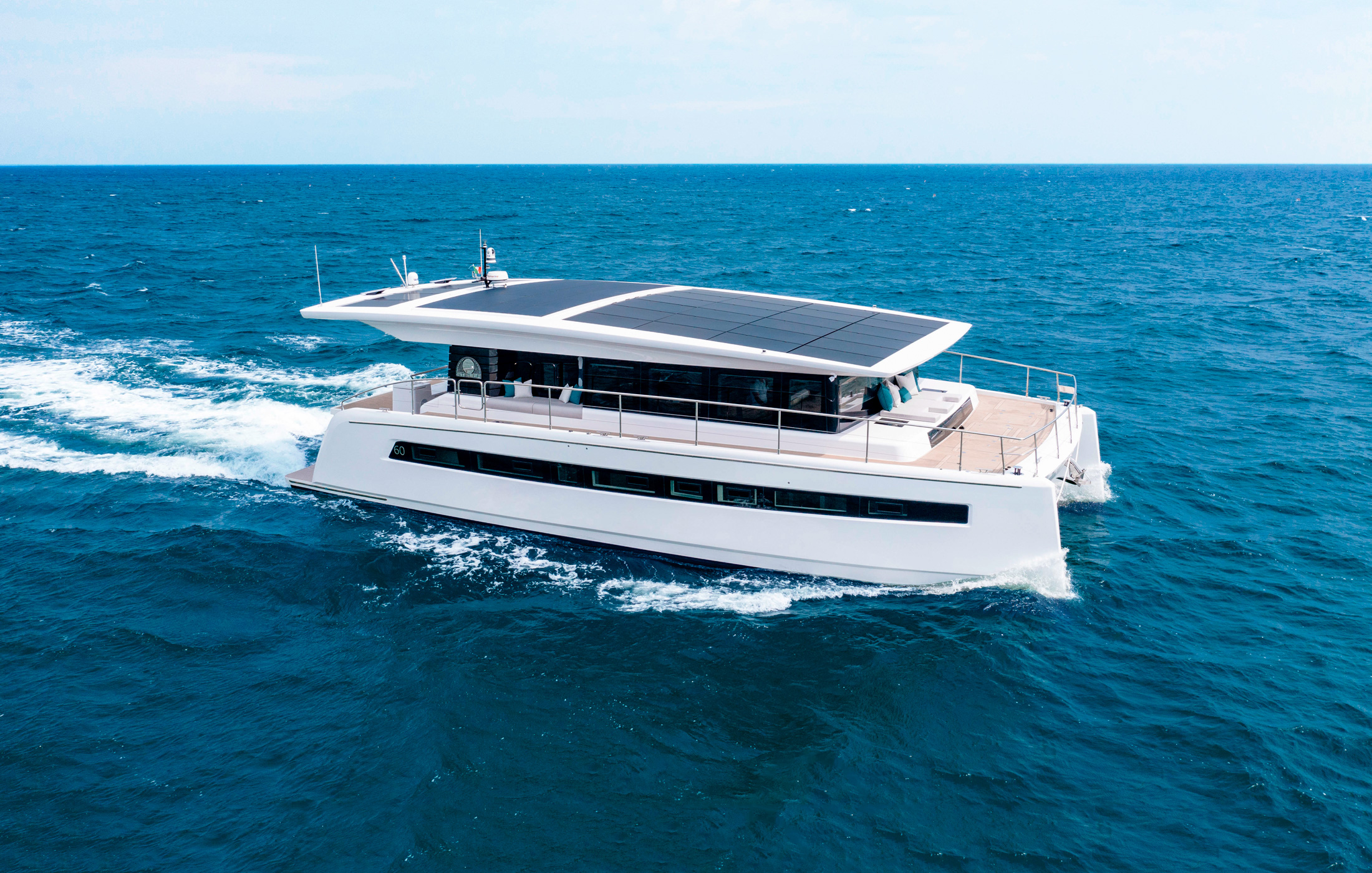
The award-winning entry to solar-electric yachts.
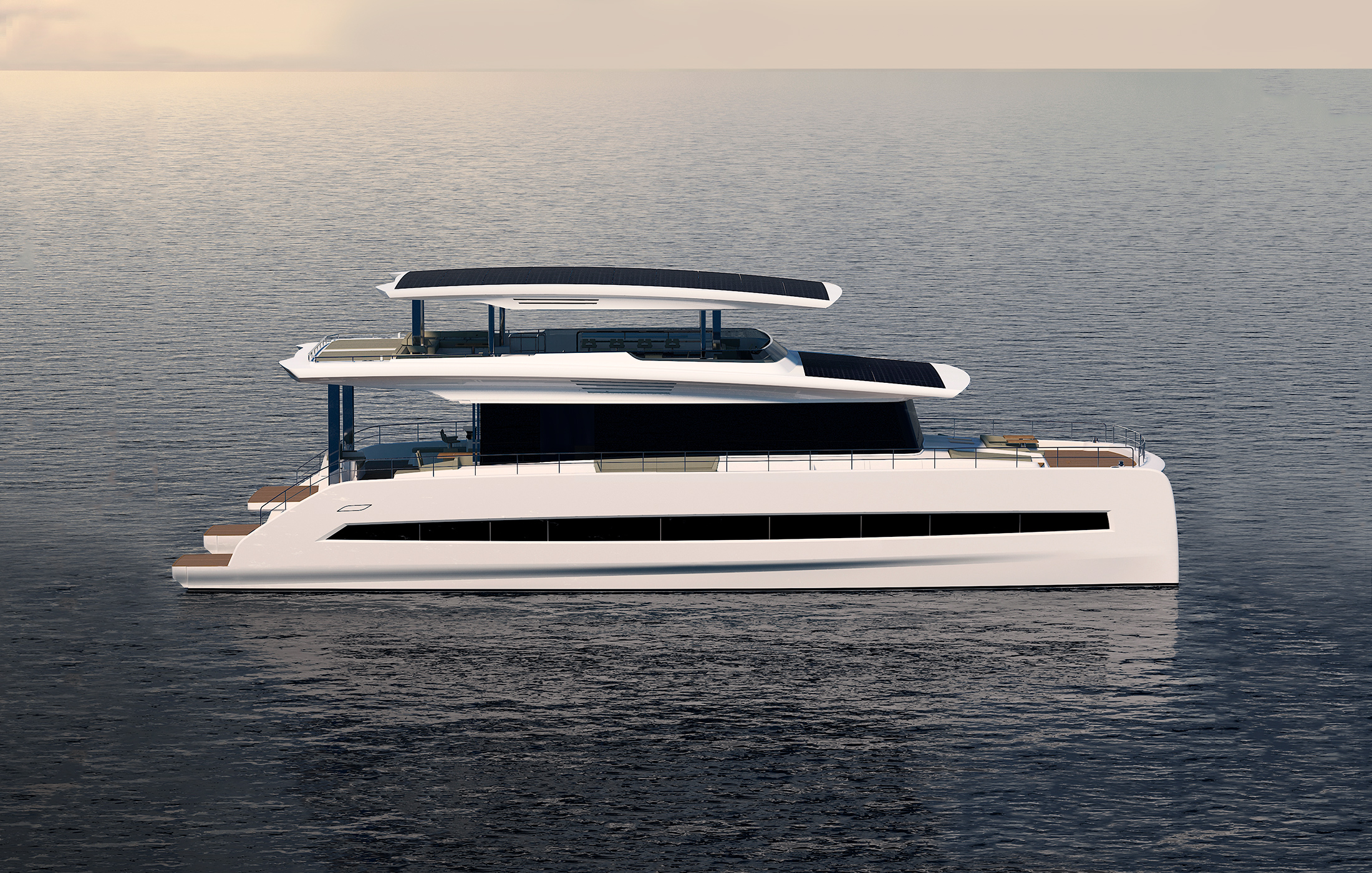
Timeless design meets state-of-the-art technology.
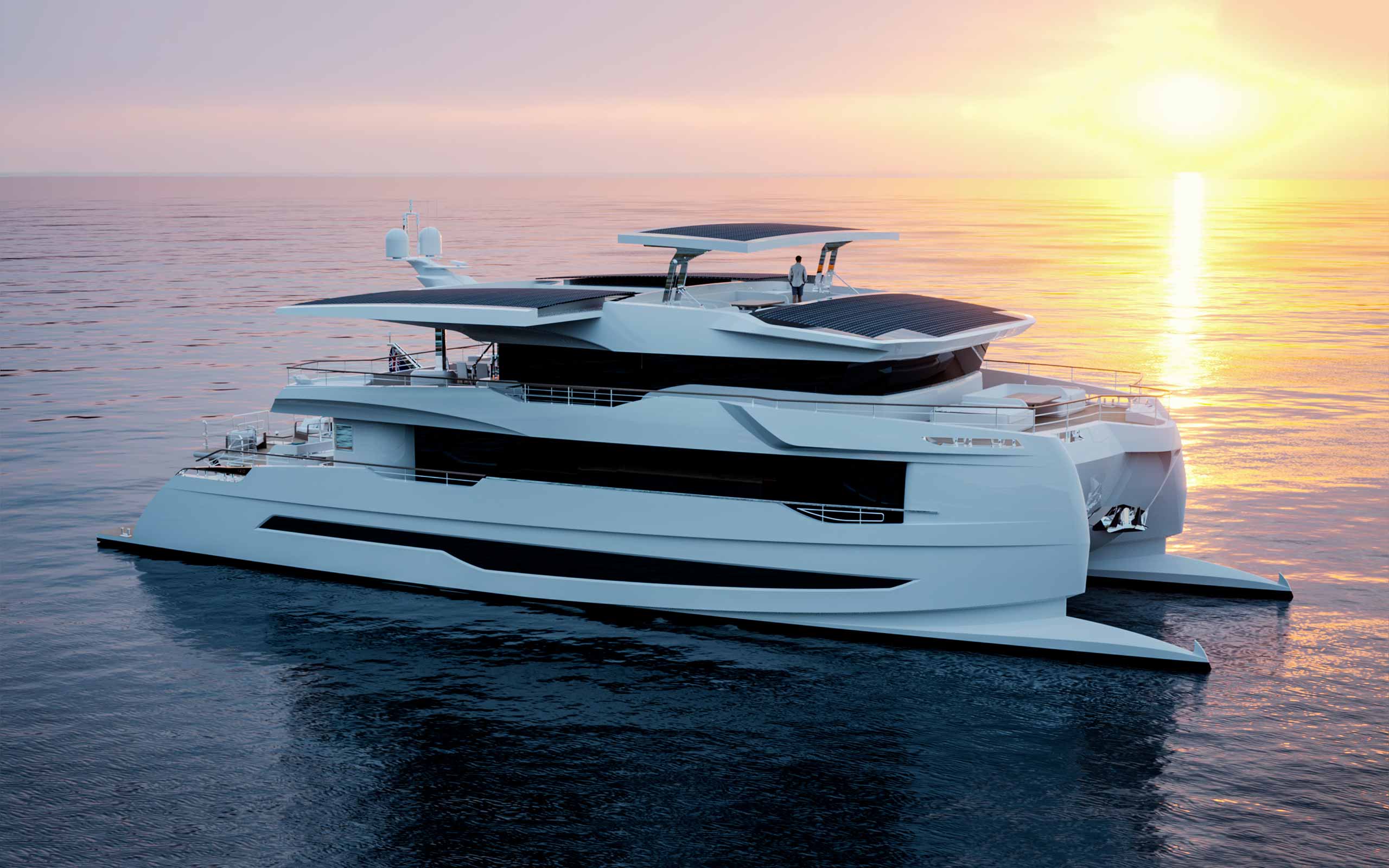
120 Explorer
The boldest expression of solar powered yachting yet.
What Makes Us Unique
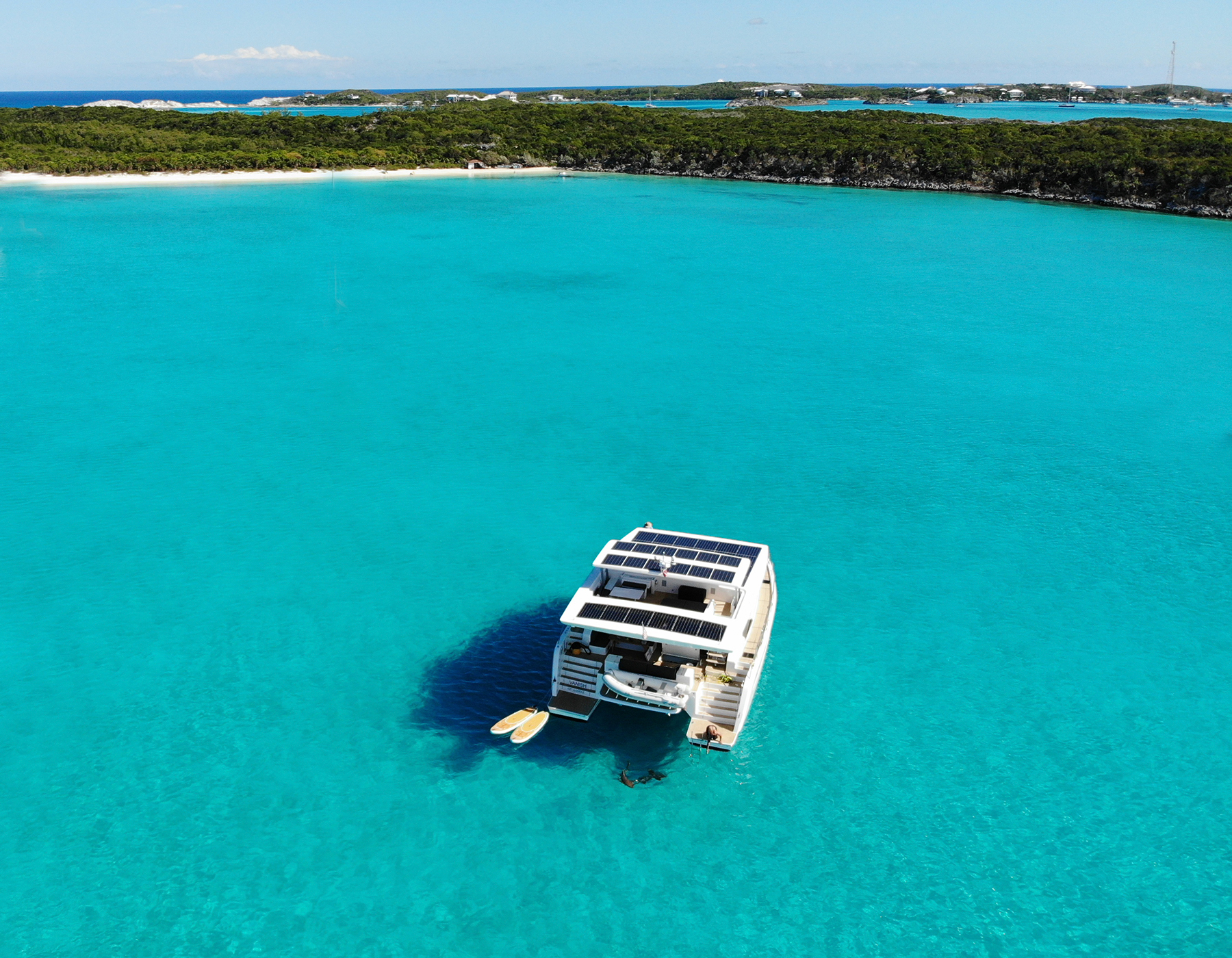
The tranquility on board of our yachts is unique. A lack of noise, fumes and vibrations create a deep connection with the sea. Luxury and sustainability finally merged into a holistic experience, working hand in hand with nature by minimizing the impact on the marine environment without compromising comfort.
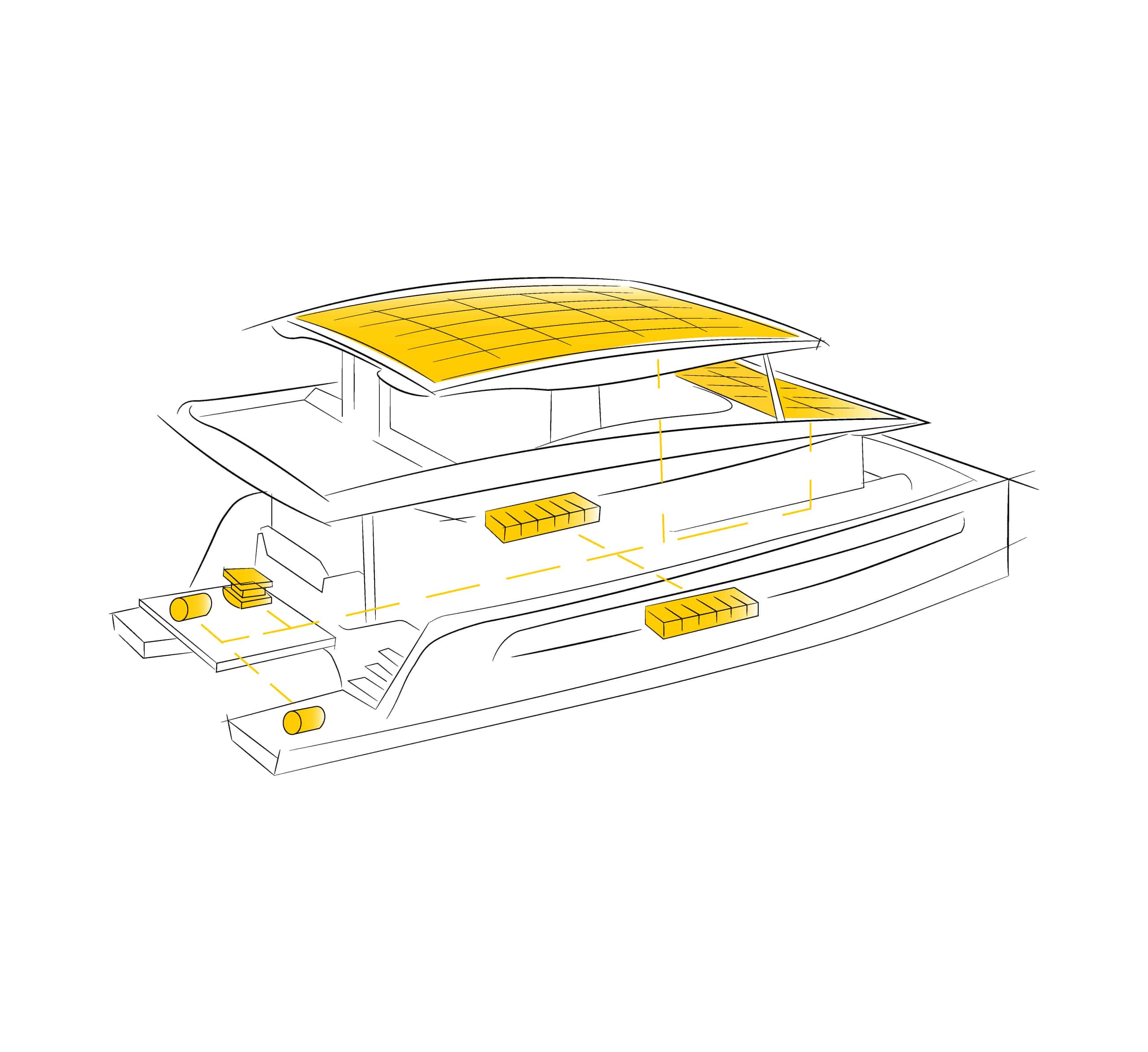
For optimal performance and efficiency, our solar-electric drivetrain integrates seamlessly with all onboard systems. Compared to fossil fuelled powertrains of motoryachts, electric powertrains have very few moving parts, resulting in minimal maintenance, maximum reliability and significantly lower running costs.
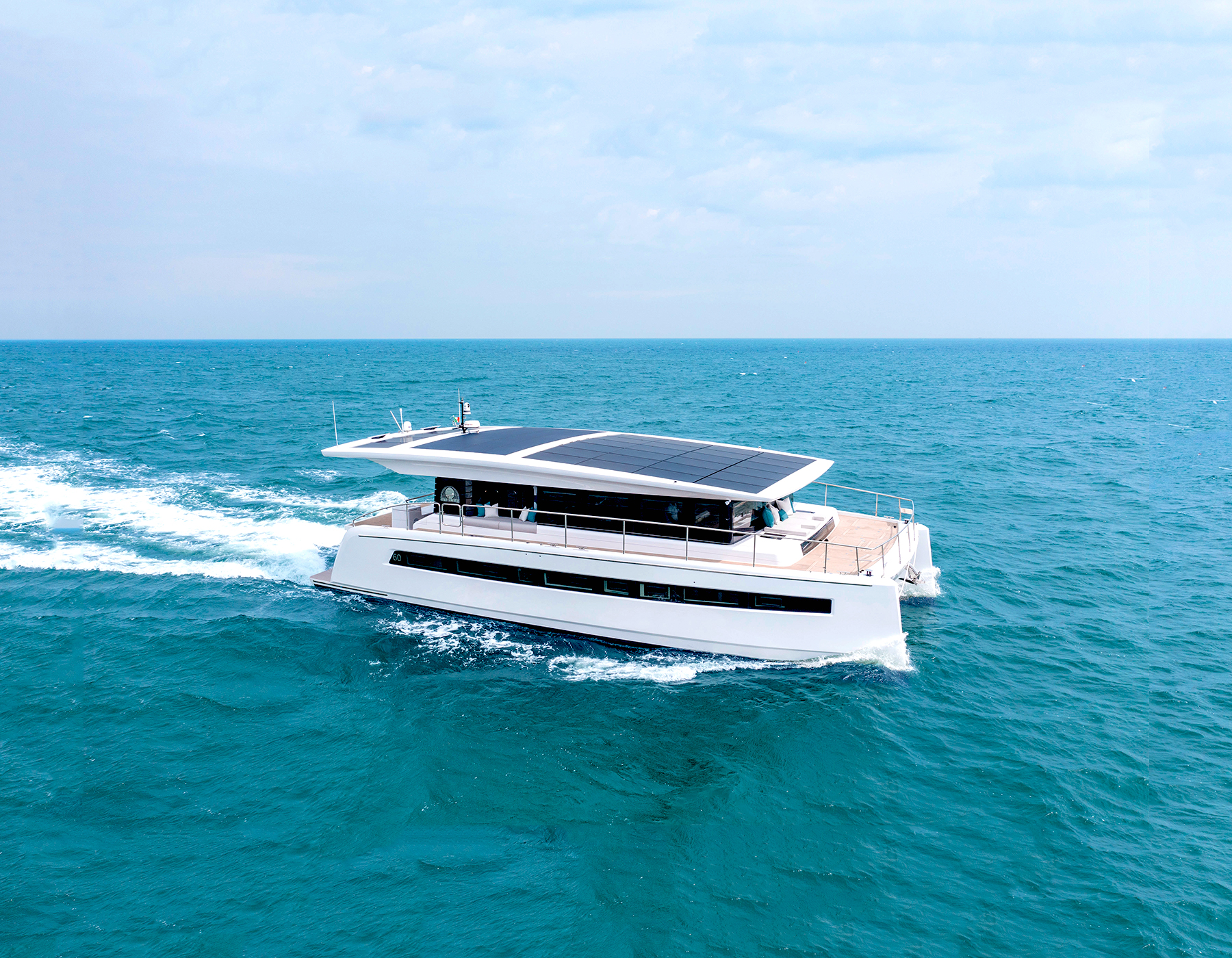
The ability to recharge your own batteries with the sun marks a new era of freedom. Depending on cruising speeds and weather conditions, a Silent has virtually unlimited range, enabling you to live a fully self-sufficient lifestyle on board. Unbound by the limitations of fossil fuels, you are free to explore the horizons.
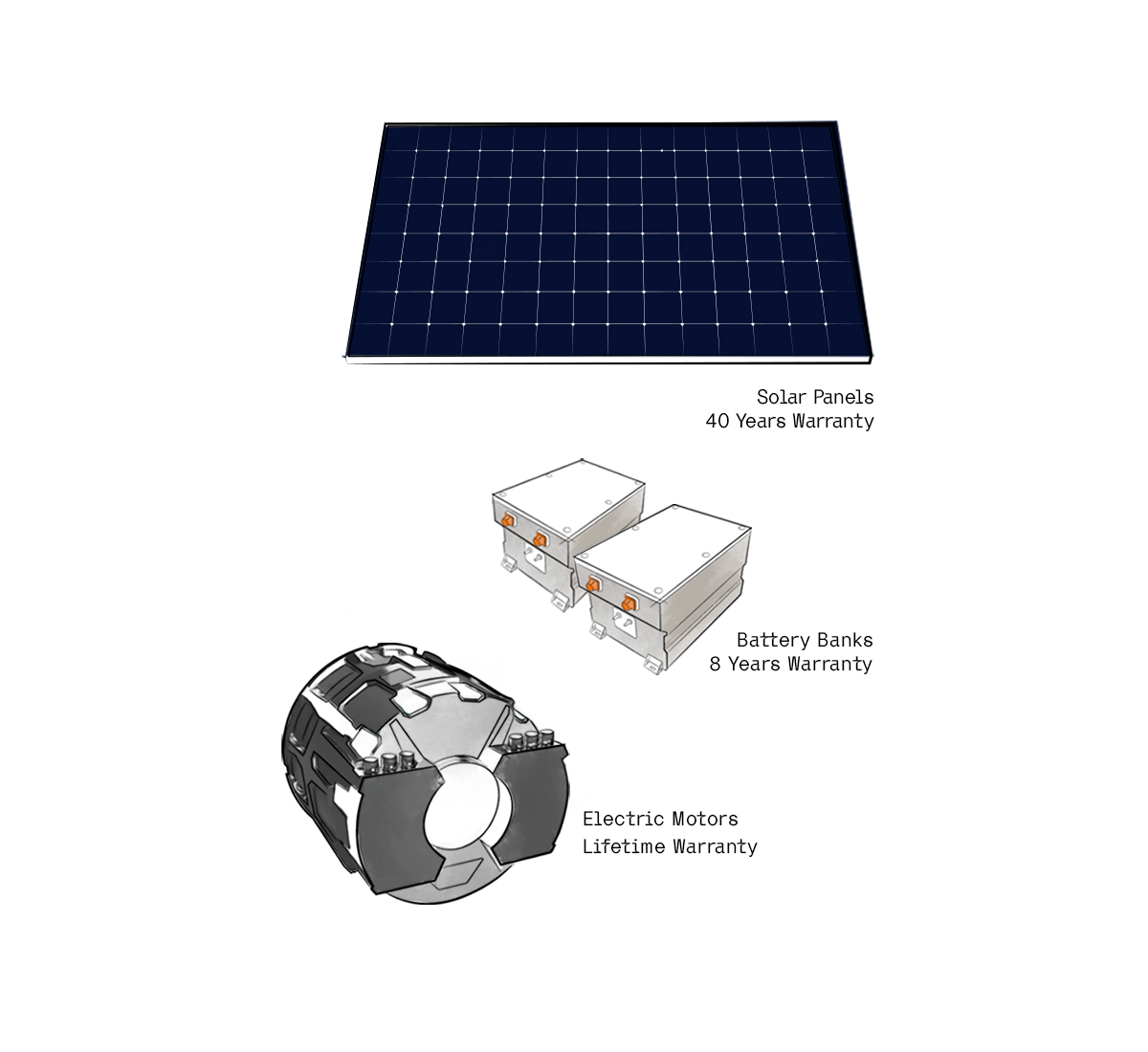
The technology powering our yachts today has been pioneered by our founders almost three decades ago. Continuous upgrading and steady optimization of the entire system are some of the key reasons our in-house developed solar-electric drivetrain offers a comprehensive portfolio of assurances and warranties.
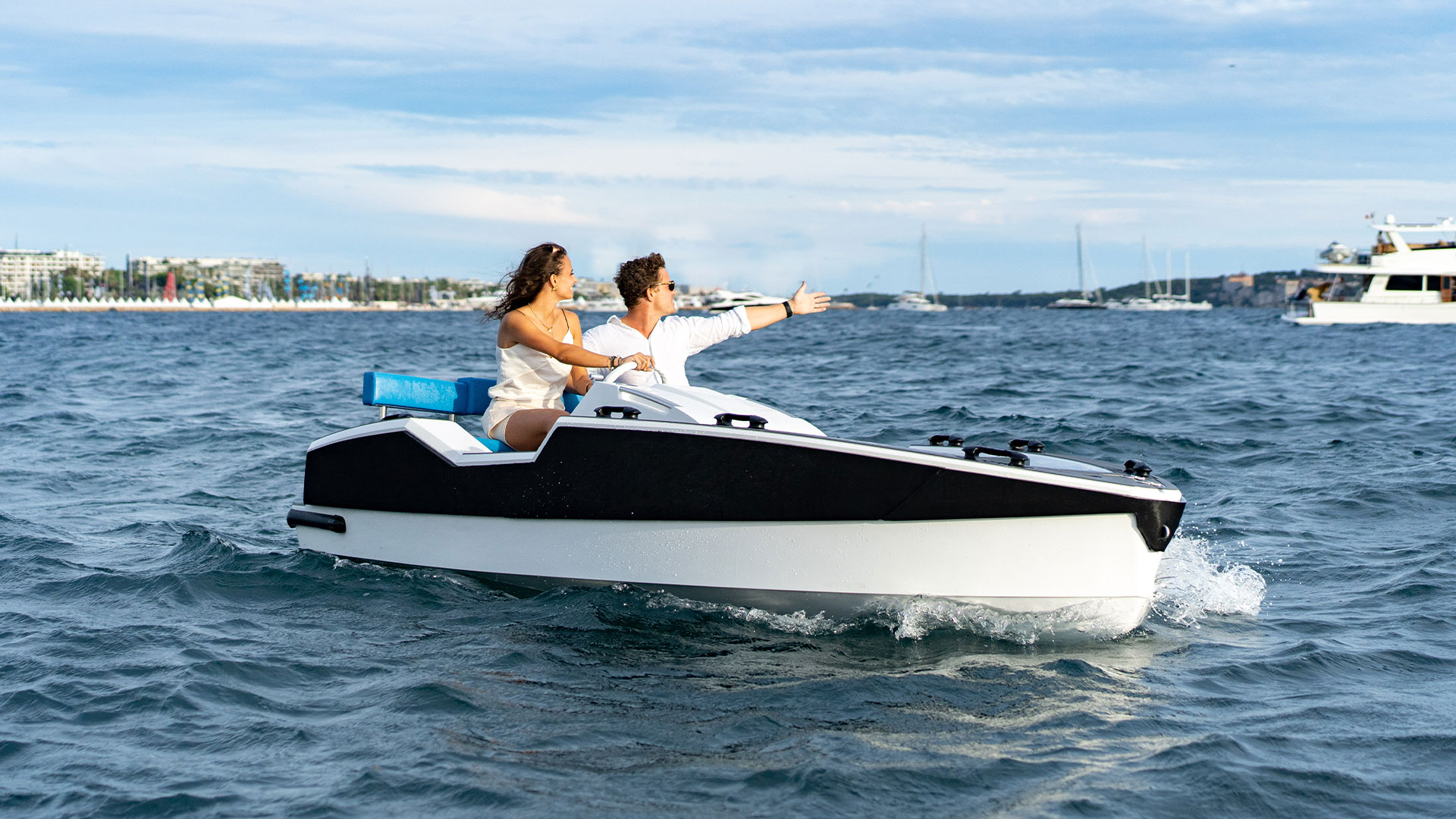
Powered by an advanced jet propulsion system, the fully electric Tender Series perfectly complements the experience on board of our catamarans. Following the same philosophy as our electric yachts, it was developed with a strong focus on being spacious, lightweight and efficient.
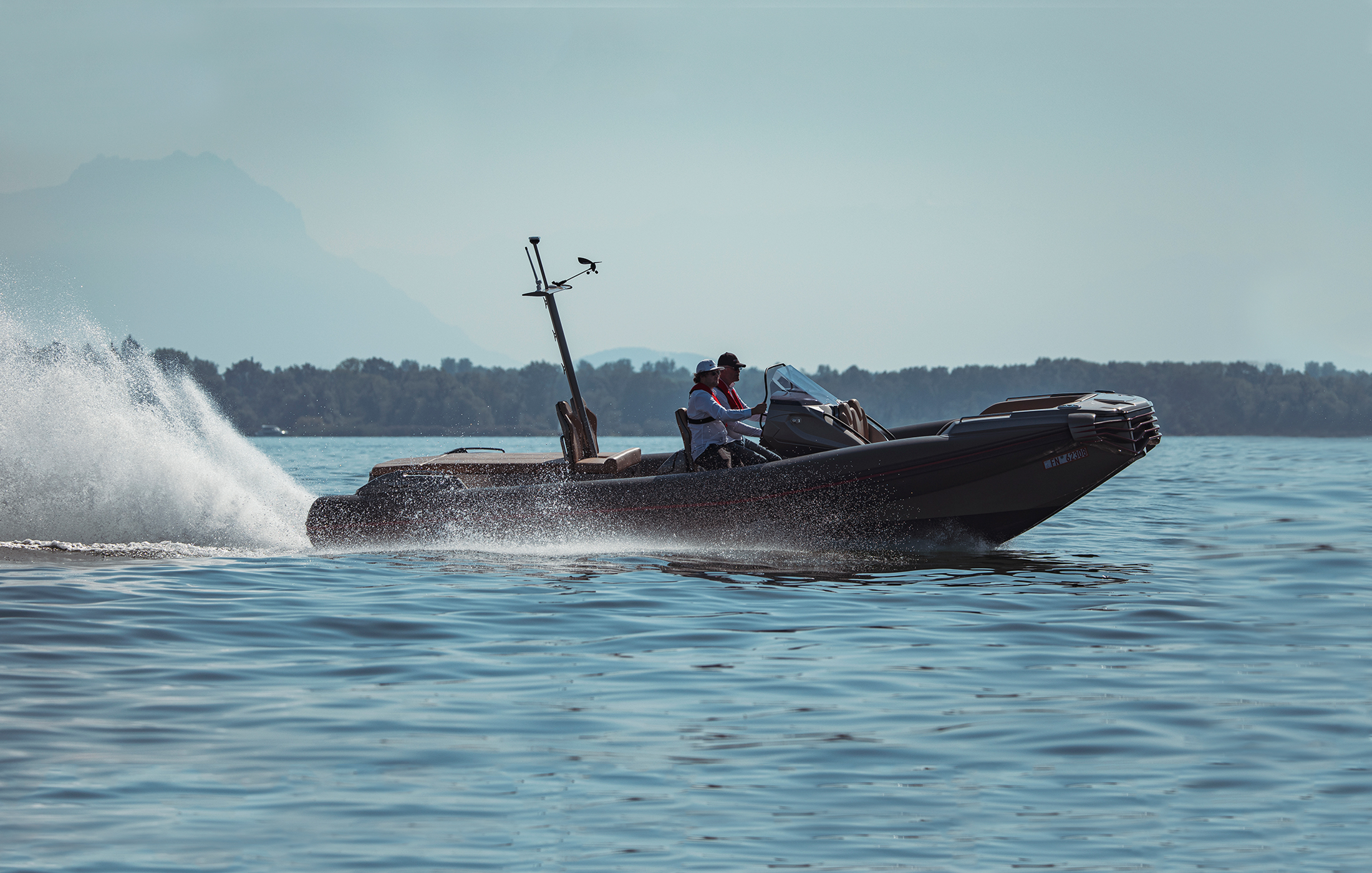
As a new breed of Silent, the Speed 28 combines futuristic design with blistering pace. Her high-performance drivetrain is supported by triple foils and embedded solar cells on the hardtop. Advanced hydrodynamics and latest AI management make for a stable ride which always remains comfortable.
Why Silent Yachts
A sensible approach to yachting which works in self-sufficient harmony with nature and creates a completely new experience on board.
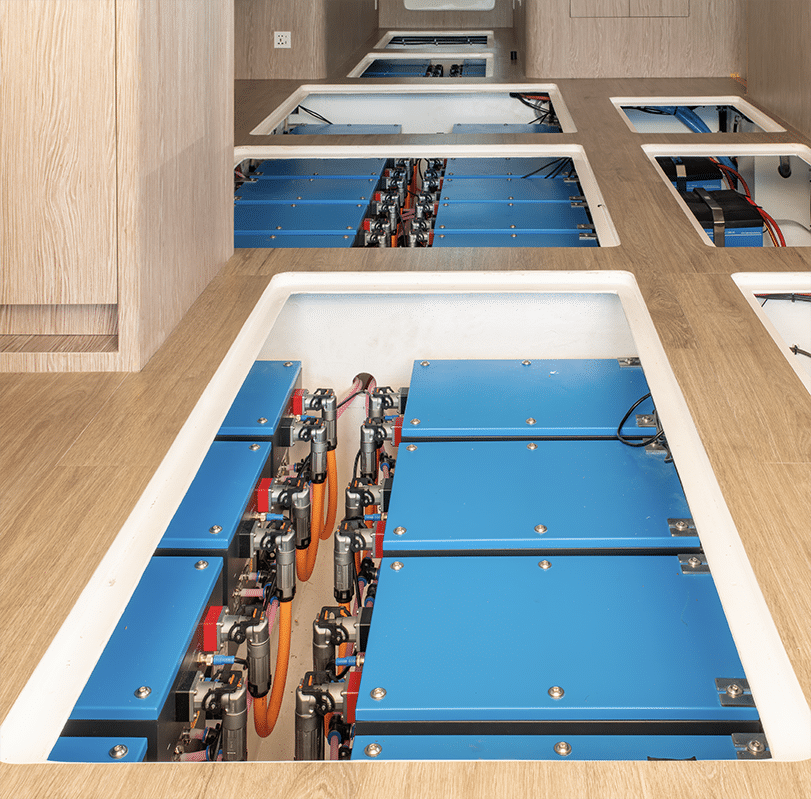
New Silent Drivetrain

Tech shorts 2023
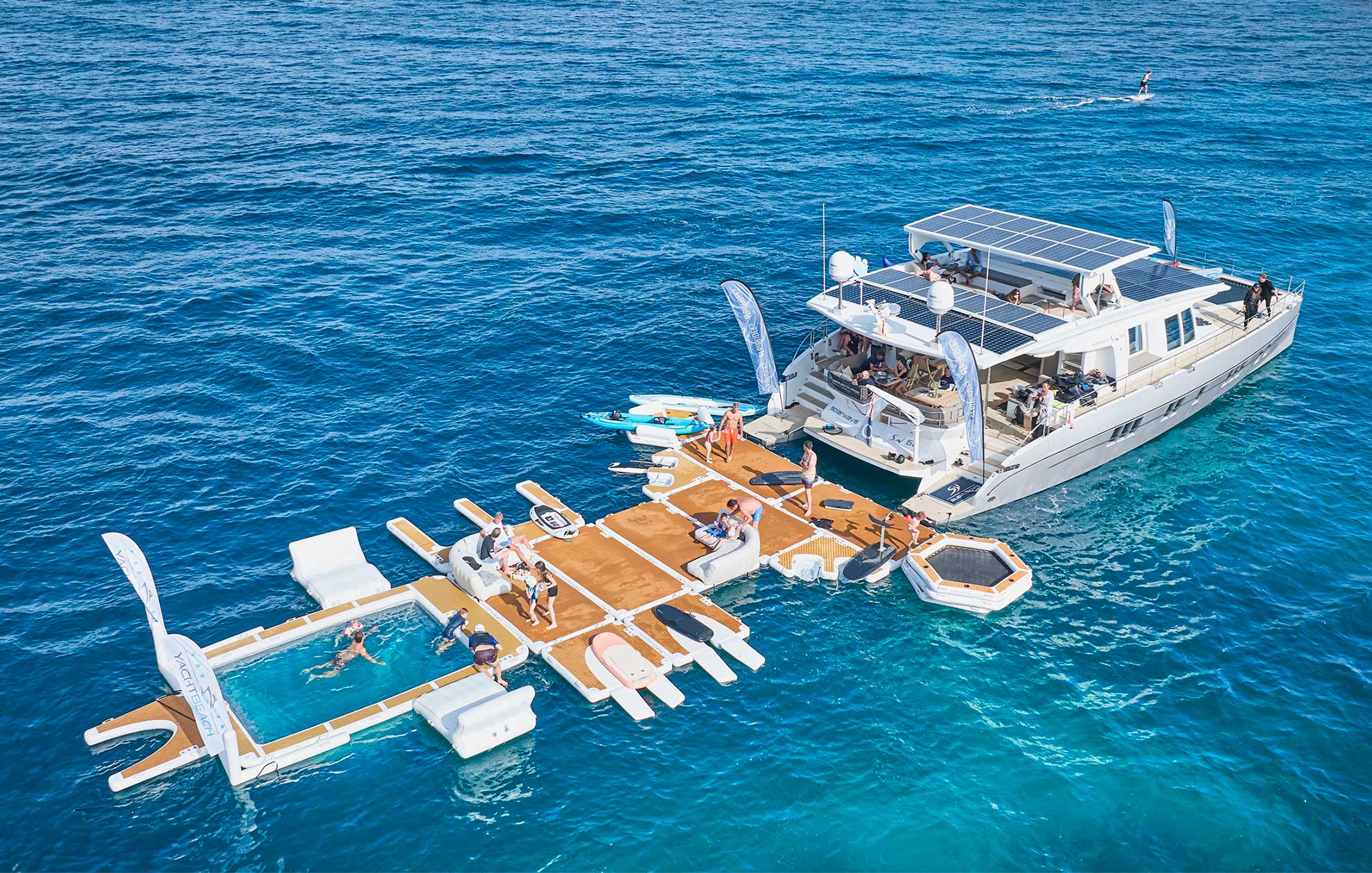
Electric power event on the water
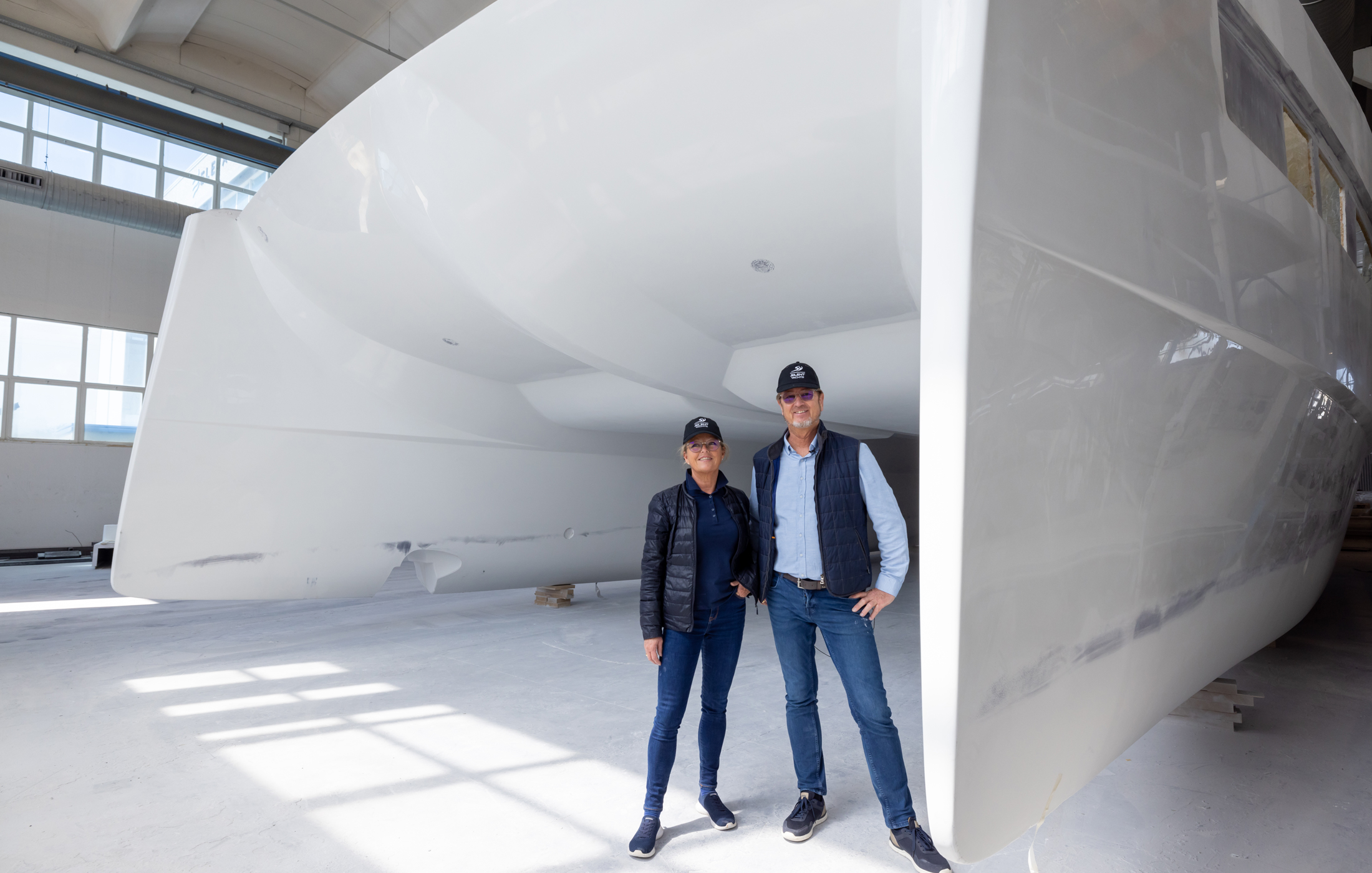
Shipyard tour Italy by Michael & Heike
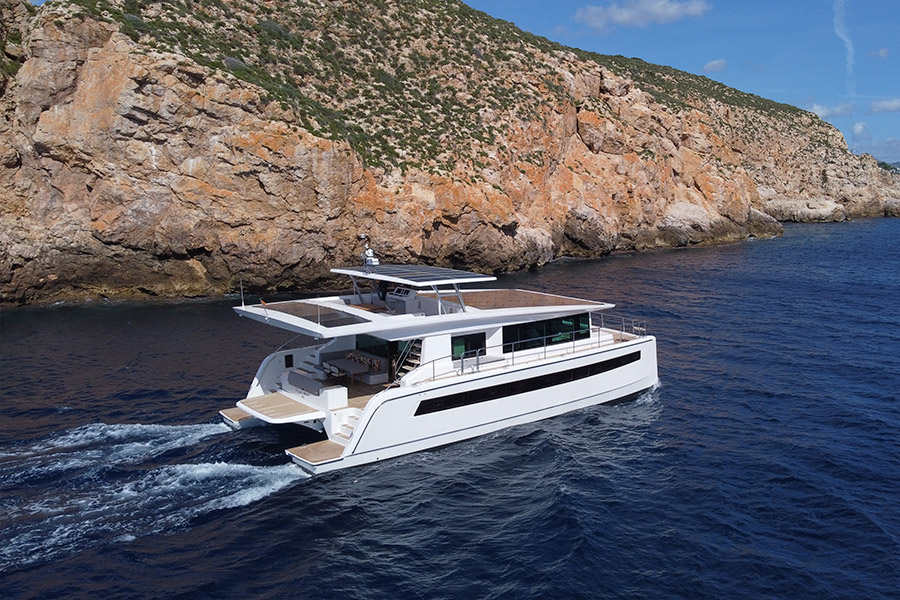
What is the range of a solar electric yacht?

Where are Silent yachts built?
“The Tesla of the seas! An amazing founding couple, a highly innovative product as well as a really cool story behind it. Furthermore, a lot of love and attention has been invested into every single detail – truly impressive!” Frank Thelen / TV Personality, Founder, Angel Investor & Disruption Expert
While the present has brought us the dawn of smart cars, I strongly believe the future will bring us solar powered smart boats – and I definitely want to be at the frontline of that journey. Michael Jost / Former Head of Group Strategy of Volkswagen Group
The idea of sailing while charging your own battery is super powerful to me – solar powered sailing is the perfect love story! Jochen Rudat / Former Tesla Central Europa Director, Advisory Board Silent Group
Elon Musk single handedly forced an entire industry to go electric, as a matter of fact if they don’t all go electric now they will soon die. I would like to see the same thing happening for boating. You are not just selling boats – you are the actual leading edge of a crucial and much overdue revolution to sustainable transport!” Klaus Obermeyer / Emmy Award Winner
I am completely excited about solar catamarans. I knew before they are great but now I truly believe this is the future. After so many boats I’ve seen in over 18 years with Boote Exclusiv, this yacht truly blew my mind. Such a silent and peaceful cruising experience – just the way it should be. Martin Hager / Editor in Chief for Boote Exclusiv - Yachts
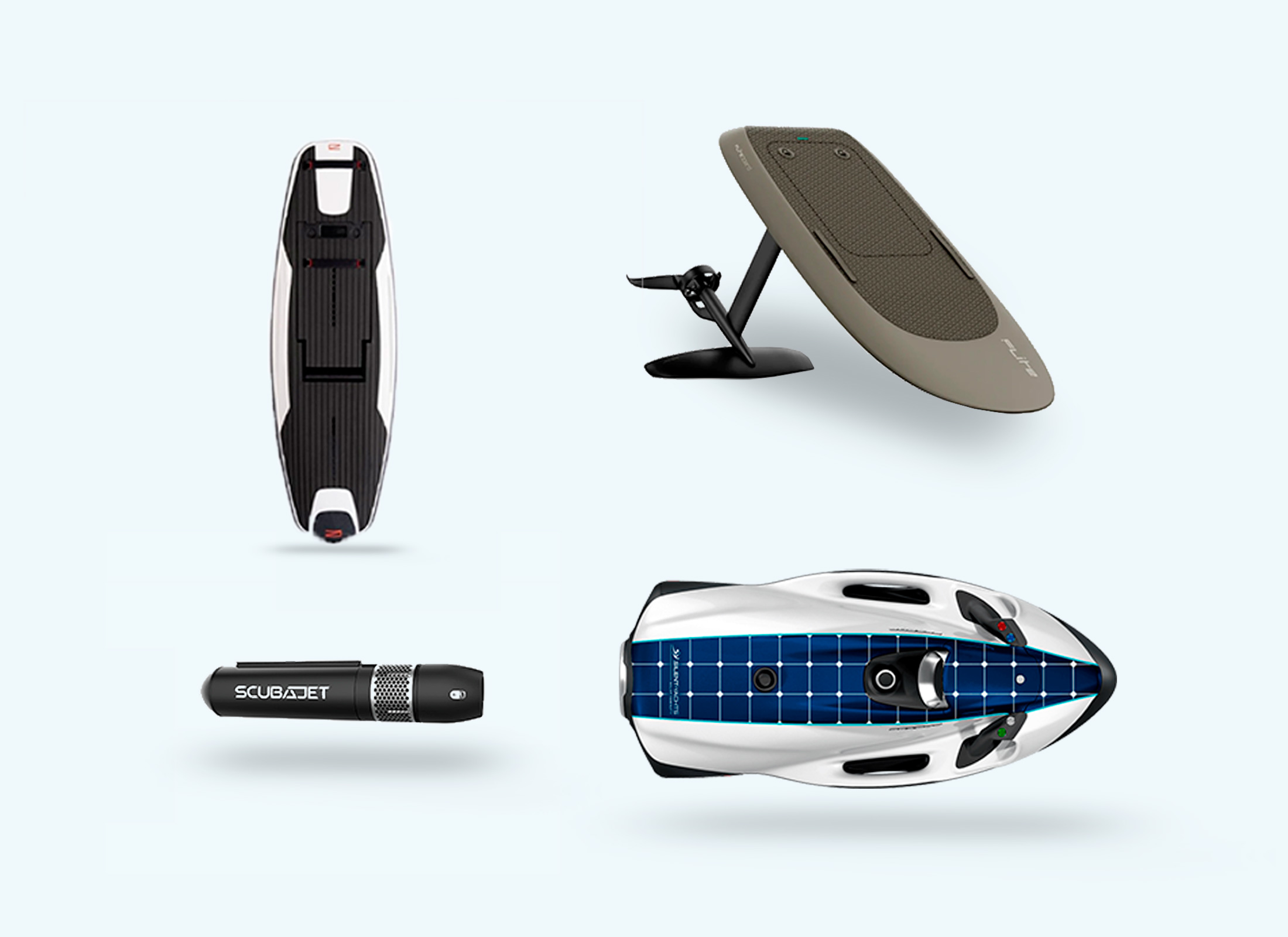
Recommended water toys, accessories and products to enhance every Silent voyage:


The Best Solar Powered Catamarans (2023 UPDATE)
As an Amazon Associate, we earn from qualifying purchases. We may also earn commissions if you purchase products from other retailers after clicking on a link from our site.
Catamarans are incredible boats, and making one solar-powered really makes my little engineering brain go wild. In this article, I discuss some of the coolest solar-powered catamarans out there!
Here are three of the best solar-powered catamarans:
- Sunreef’s 80 Sunreef Power Eco Yacht
- Silent Yachts’ Silent 80
- Soel’s Senses 48
There are soo many variables that it’s tough to say one is better than the others. No matter which you board, you’re going to have a luxury experience. The benefit of these solar cats is that the experience can be had while maintaining a sustainable lifestyle and contributing to the betterment of the environment.
The diesel engine is dead, Long live electric power. Sort of…
Table of Contents
Solar Catamarans: Luxury Yachts
Before we look at each of these, let’s take a few paragraphs to talk about catamarans in general. First of all, when many people think of cats, they think of a relatively small craft barrelling across the water, one of its hulls in the air with a swashbuckling daredevil hanging off the side of it high above the water.
That’s not the kind of catamaran we’re talking about here. We are, instead, looking at yachts or cruising catamarans. These share one commonality with the other type of cat, and that’s the twin hulls. But that’s it. Cruising cats are slower, more stately boats. Also, on one of those little, quick ones, there’s not room for much of anything, and you won’t likely be doing any cooking or sleeping on it.
We’re also looking solely at solar-powered catamarans here, and although they have much in common with their diesel-drinking brethren, there are some key differences, which we’ll also address.
Perhaps the main difference (and one of the most significant selling points for a solar-powered catamaran) is the noise level. Gabo
Anyone who’s been on any boat with a combustion engine (diesel or petrol) on board has had to deal with the noise and smell.
But the drone (or roar, depending on the engine’s size and location) can be far from relaxing, which is one of the main reasons to get on a boat, off the mainland, and out to sea. Even if you’re marlin fishing—not the most peaceful undertaking man has ever attempted—you’re still out on the water and hope for some peace and quiet.
Eliminating that engine noise is a pretty big deal.
How Solar Catamarans Work
The biggest key to the success of the solar-powered yacht is not the solar panels – although those are great, as they look terrific and are well integrated into the ships. But the unsung hero here is the battery system.
Solar energy companies continue to perfect their industry. By making their solar batteries denser and denser, they create batteries that can store more solar power for more extended periods in smaller spaces.
And that brings us to an aspect you probably haven’t thought of:
Solar-powered yachts have more interior room because the battery system takes up less space than a conventional engine would.
Space customarily used by an engine room gets freed up for other uses.
Since most solar catamarans are nearly infinitely customizable, it’s hard to say what you might use that extra space for, but it’s available because of the solar power system.
The yachts have solar cells in all sorts of places, most notably on the roofs of the boats, but some companies build them in over large swaths of the hull, so they look as much like a design choice as a power source.
3 Best Solar-Powered Catamarans
Let’s be honest—if you’re dropping more than a couple of million dollars on a boat, two things are likely true: you have a lot of money, and you like nice things. All of the yachts listed here are lovely things, so it’s going to be hard to go wrong.
As a result (and since these aren’t exactly accessible for test drives), it’s difficult to say which one of these is actually the best ; ergo, this list is in no particular order. They’re all glorious specimens.
Incidentally, where the price is listed, that number is an extremely general estimate. As these vessels are all entirely customizable and each choice below is available in different lengths and configurations, the cost can vary wildly.
To better understand what is a good price of a solar-powered cat, they should be compared to performance cruising catamarans or larger catamarans for families .
80 Sunreef Power Eco Yacht
This may be the most remarkable boat you’ll see for a long time. Sunreef has been in the yacht-building business since the turn of the millennium, winning awards along the way, and in the last few years, the company began work on its Eco line.
While there are shorter (and one longer) versions of this ship, the 80-footer (24.38 m) is pretty iconic. It offers electric motors to push it over the water and to do so with little noise, vibrations, and zero smell of fuel or exhaust.
As mentioned earlier, this is the yacht with solar cells pretty much all over it. They dot the sides of the hull and add to the overall look of the ship. With these cells and the panels on the roof, this yacht carries 200 square meters (2152 sq ft) of solar cells generating up to 40kWp (that’s 40 kilowatts peak, meaning under the best conditions, like on a bright, sunny day). Sunreef makes cats that run under sail, as well.
- Unlimited cruising
- No emissions
- Silent running
- Solar panels on the sides of the boat may not appeal to everyone
- Price: $8 million USD and up (new)
Silent Yachts has several versions of each of its catamarans. This eighty-footer (24m) is available in a loft or a classic version, but you get large spaces and incredible luxury no matter what you choose. The bathrooms alone on these things are pretty enough to live in.
Like Sunreef, Silent Yachts offers various lengths of these yachts, but they refer to the 80 as their flagship, and with good reason. Also with good reason, this yacht has been called “the Tesla of the seas.”
Three power options exist, each allowing higher maximum speeds for longer periods on the water than the last, but all three offer cruising speeds of up to 8 knots.
Its rooftop solar panels generate 26kWp of power . While that’s a significant step down from the comparable Sunreef vessel, the company claims unlimited range. Theoretically, it makes sense—solar power is even easier to come by on the open sea than on land, and with an endless supply, you ought to be able to cruise forever (as long as the sun shines).
All that power gets stored in batteries, and when it’s time to use it, the boat does so silently through its electric motors, on which Silent Yachts gives a lifetime warranty. While that warranty wouldn’t give you much peace of mind if you were on the float hoping for rescue, once you got it back home, whatever the problem was would get fixed, and you’d be ready to go out again.
Like any electric motor propulsion system, the Silent 80’s requires almost zero maintenance. Compare that to the ongoing work you do on your big, loud, smelly diesel engine. Not having to change the oil alone seems worth the investment.
- Recommended maintenance schedule happens after the end of most yachts’ lifespans, meaning you may not ever have to do any maintenance at all on this one.
- Kite available for additional propulsion (up to ten times more efficient than a sail)
- Its five-and-a-half-foot draft is pretty deep.
- Smaller kWp capacity than comparable makes.
- Price: $4.6 million and up (new).
Soel Senses 48
This is a smaller yacht (a little more than half the size) than the first two. However, Soel has built a beautiful boat that is entirely sustainably powered. The 12 solar panels on the roof generate 2.7 kWp of electricity stored in two batteries that can be configured to hold up to 142 kWh of stored solar power.
This, like the others, makes for a boat that glides over the water without rattles, without fumes, without noise. Unlike the others, its cruising speed tops out at 10 knots —faster due to its smaller size. Its top speed runs at 18 knots, but with significantly less kWp on board, the ship won’t run at that top speed for extended periods.
The company lists the ship’s range at between 30 and 56 nautical miles (55 – 103 km) , and the fluctuation will come from various options and choices available in operational modes.
- The boat’s 2.3-foot (70.10 cm) draft is shallower than the larger boats here.
- Orders of magnitude more affordable.
- This is a smaller boat and won’t comfortably sleep much more than 10.
- Limited range means this is a weekend cruiser, not a circumnavigator.
- Price: $600,000 and up (new).
Other Choices
These next couple of catamarans are newer and smaller, but they bear mentioning for various reasons, which we’ll be sure to point out with each one. Again, at a certain point, a yacht is a yacht, and if you can fit your friends and family on it for a fun trip, everything else is just gravy.
Smaller than Silent Yacht’s Silent 80, this one is a product not only of Silent Yacht but one made in conjunction with Volkwagen and Cupra, a Spanish car company.
Volkswagen has become a significant player in the electric motor game, so the company brings its Modular Electric Drive (MED) to this vessel, allowing for an even more efficient electric propulsion system than the one on the Silent 80.
Cupra’s presence in the project seems to be solely on the design side of things. The Silent 50 is a vessel built with an eye toward a world in which water travel creates zero greenhouse gas emissions.
Aquanima 40
Azura Marine , based in Singapore, recently announced a solar-powered yacht whose biggest feature may have been its six-figure cost. According to Azura Marine, the ship can cruise indefinitely with a 10 kW solar power system and a 60 kWh battery pack. That is a smaller battery pack than the others, but it’s also a smaller craft.
This cat is a terrific combination of price and features.
Choosing the Best Solar Catamaran for You
This will be a personal choice and one you’ll want to do a lot of research on (which is presumably why you landed on this page in the first place). Since solar-powered catamarans sell for sums of money with at least seven digits in them, this will not be an impulse purchase for very many people.
Any of the choices listed here will be well-built, beautiful, luxurious places to lay your head or sip your mimosas while you’re on the water. It may come down to aesthetics, range, or speed, but all of these models offer incredible specimens that everyone—landlubber or old salt—will treasure.
The luxury yacht world is an exclusive one, but it doesn’t have to be wasteful or ecologically irresponsible. The yachts listed here are some of the best in the world in terms of combining luxury with solar power and providing emissions-free yachting that’s quiet and relaxing.
New yachts can be purchased from the manufacturers, allowing for customization, and various online yacht brokers are willing to help you find a pre-owned craft that’s right for you.
Finding the right yacht for you will depend on your wants and needs, but we can all agree that environmentally sound, sustainable power on these vessels is valuable.
- Electrek: This $500,000 electric yacht can cross oceans on just battery and solar power
- Forbes: Volkswagen Unveils 50-Foot Solar-Powered Catamaran In Partnership With Silent-Yachts
- Kite Boat Systems: Kite controller for sailing boats
- Plugboats: New 48′ solar electric catamaran from Soel Yachts
- Robb Report: Solar-Powered Yachts Are Taking Over. Here’s Why That’s a Good Thing.
- Silent Yachts: Silent 80
- Soel: Soel Senses 48
- Sunreef: 80 Sunreef Power Eco
Owner of CatamaranFreedom.com. A minimalist that has lived in a caravan in Sweden, 35ft Monohull in the Bahamas, and right now in his self-built Van. He just started the next adventure, to circumnavigate the world on a Catamaran!
Leave a Reply Cancel reply
Your email address will not be published. Required fields are marked *
Save my name and email in this browser for the next time I comment.
Recent Posts
Must-Have Boat Gear for Catamaran Sailors!
Sailing is probably the most gear-intensive activity I've ever done; there are so many decisions to be made about what gear to buy now, for tomorrow, and what to definitely never buy. The gear on...
6 Best Trailerable Trimarans For Bluewater and Coastal Sailing
Having a boat costs a lot of money, even when you are not using it, marina fees, etc. And once it is in the water most sailors never go very far from their "home marina" and sailing will be somewhat...
Spend $600 or more to unlock the discount. Limited slots available, act fast!
- BLUETTI Spring Sale, Up to $2100 Off Shop Now>>
- BLUETTI New Year Sale, Save Up To $2100 , SHOP NOW>>
- United States
- Philippines
Solar Sailing: How to Power a Boat with Portable Solar Panels and Generator
Owing to advancements in marine technology, the boats we have nowadays are more dependent on electronic systems than ever before. Naturally, this means that boats require a lot of electricity to power these electronics. Normally, boat owners use the power from their engines to charge their batteries and power the electricals in their boats, turning their boats into gas guzzlers.
However, with portable solar generators and a portable solar panel for boats, you can enjoy a more reliable and potent energy source for your boat that will make your sailing not only more eco-friendly, but also much more economical in the long run. So join us as we explore how can you power a boat with solar portable generators and panels!
Why Do Boats Need Electrical Energy?
Sailing in the vast open seas can be a fun and thrilling adventure. However, it can also turn dangerous and forbidding pretty quickly as winds pick up momentum and the seas become rough. In a nutshell, art of sailing is one that is accompanied by many uncertainties. That is why; boats have dedicated safety features to make sailing safer.
In addition to this, boats are also often equipped with appliances and tech that make your sea adventure more fun and enjoyable. Needless to say, all these systems and devices require electrical energy to function.
The Problem with the Traditional Way to Power Boats
Originally, the engine of the boat was, and is still, used to generate the required energy needed to power the systems and technology commonly found in boats.
According to the old conventional ways, the engine of the boat would be hooked up to a marine battery and when turned on, some portion of the power generated by the engine would get converted into electricity and stored in the battery. This electricity would then be used to power the electrical systems onboard the boat.
The problem with this approach is that it demands a lot of work from your boat’s engine since it not only has to drive the boat, but also power the electrical systems and appliances on your sea cruiser. More work for the engine essentially translates to a higher fuel consumption and hence, higher fuel costs for you to bear each time you take your boat out for a spin.
And with time, as the number of electrical devices on boats keeps increasing, the power required from the engine does too. This means that your boat will become an even more of a gas guzzler than it already is, as you add more and more tech to it.
How Can You Power a Boat with Solar Portable Generator and Portable Solar Panels
Powering your boat using portable solar panels and a solar power generator for boats is actually quite easy. A portable solar generator is essentially a complete energy generation and storage unit having its own dedicated inverter, charge controller, and battery management system.
Or, you could simply think of it as a portable battery storage system that can be charged by a portable solar panel for boats. The system boasts a boxed, compact and portable form factor allowing you to easily place it anywhere in your boat.
So how do you power your boat with it? To fully explain the system and how to use it, let’s start from the top. First you need to find a suitable place on your boat to store the solar generator system; it should be someplace where the system does not get exposed to the water or other elements.
You then connect the system to your portable solar panel for boats which can be set up on the roof of your boat or anywhere that receives a good amount of sunlight. When this is done, the solar panels will start generating electrical energy which will be directed to the battery of your solar generator.
But before the electricity reaches the battery for storage, it must pass through the charge controller and battery management system. The variation in the intensity of sunlight reaching your solar panels can cause its electrical output to fluctuate. This fluctuation can potentially damage the battery and other components of the portable solar generator.
Therefore, the charge controller and battery management system regulate the incoming voltage to smooth out the fluctuations and protect the solar power generator for boats from any such damages. In addition, the aforementioned systems also regulate the amount of current and voltage entering as well as exiting the battery of your portable generator system. This is done to prevent the battery from overcharging and over-discharging.
Once the electrical energy passes through the charge controller and battery management system, it arrives at the battery where it gets stored for later use. Now, all you have to do is press the power button once to turn on the system, plug the electrical devices you want to power into the correct outlet ports and that is it!
It’s important to determine the correct outlet port because a portable solar generator has multiple outlets some of which supply DC electricity while the others supply AC electricity. So, make sure to plug in your DC devices into DC outlets and AC devices into AC outlets. Don’t worry; they should be clearly labeled. Batteries can only store DC energy, which is why an inverter is used to convert the DC energy to AC before channeling it to the AC outlets.
Common Boat Devices You Can Power Using Portable Solar Generators and a Portable Solar Panel for Boats
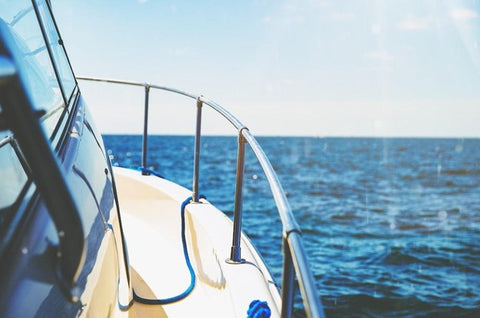
Navigation Lights
Navigation lights are a vital safety measure and almost all boat owners are legally obligated to have them installed on their boats if they don’t have them already. These lights aid all boats in navigating the waters after sundown, between dusk and dawn, as well as during bad weather conditions like rain and fog when the visibility is extremely poor.
With the help of these lights, boats can navigate more safely and spot the give-way vessel, thereby avoiding any collisions at sea. The navigation lights required for a boat vary depending on certain factors associated with the boat. These factors are:
- The size of your boat.
- If your boat relies on an engine or sails.
- Whether or not your boat is anchored.
- Whether your boat is in inland or international seas
On Board Powered Radio Systems
Powered radios are yet another key safety device that is mandatory on all commercial boats, cruise liners, and recreational boats that are over 65.5 feet in length. Having a powered radio system on your boat enables rapid communication between your boat and other boats, bridges, marinas, and the United States Coast Guard.
As such, you can use the radio to call for assistance, request weather forecasts and updates, and much more. Knowing this, it would be wise to have a radio system on your private boat even if you aren’t legally required to. You can easily plug in the radio system to your Bluetti solar power generator for boats and enjoy reliable communication and assistance from other sailors at sea.
Autopilot Systems
Sea adventures can be very exciting and thrilling and serve as the perfect getaway from your hectic city life routine. Breathing in that fresh salty air of the open seas has its own unique way of relaxing the body and mind. However, having to continuously stand at the helm grows tiring and can take away from the soothing experience you were hoping to achieve at sea.
Fortunately, modern boats come with autopilot systems that do an excellent job of maintaining the preset course of your boat with very few helm movements in light to moderate weather. These systems enjoy the benefit of having an endless attention span and don't get weary as their human counterparts do.
In addition, they steer extremely precisely, will save fuel and get you to your destination faster, especially when integrated with a GPS, all the while allowing you to sit back and enjoy the cool salty breeze of the sea. Using a portable solar generator paired with a portable solar panel for boats, you can easily power this electrical feature and enjoy a fun relaxing adventure at the sea.
Marine Refrigerator
Having a marine refrigerator on your boat can be a godsend. With a marine refrigerator, you can keep your perishable items fresh, your beverages cool, and even pack some food for your sea adventure and turn your solar sailing into a complete picnic over the sea.
Marine refrigerators have the added benefit of being better insulated than your ordinary refrigerators all the while consuming less energy than them. This allows your Bluetti portable solar panels and solar power generator for boats to power your refrigerator for an extended period of time without trouble.
If you have ever taken your boat out for a spin after sundown, you’ll know that it can get extremely dark out at the sea, pitch black in fact, and the visibility can go down near to zero. In such a situation, the only lights you have are the ones installed on your boat that allow you to see the waters ahead as well as around the boat.
But you needn’t worry, a high-capacity Bluetti portable solar generator can store enough energy during the day to power your boat lights throughout the night, making sure that you aren’t left in the dark.
If you have ever been at sea during the summers, you’ll know just how hot and humid it can get inside your boat. The moisture in the air can build up inside your boat’s cabin causing you sweat profusely and making it hard to breathe. In addition, the humidity can also force the gasoline fumes from the engine to linger and accumulate in the air in and around your cabin.
This can make things not just unpleasant for you but also dangerous. Fans are the perfect solution for this problem. These systems induce the required airflow in your boat’s cabin preventing the moisture or gasoline fumes from accumulating in the space. In addition, it also helps you fight off the heat. With portable solar panels and generators, you can keep your fans powered for several hours allowing you to stay cool and comfortable when sailing in the hot summer heat.
Final Thoughts
Using Bluetti portable solar panels and portable solar generators to power your boat can offer you various benefits compared to using your engine. For starters, it takes off the excess load from your engine, thereby reducing fuel consumption and allowing you to save a substantial amount on fuel costs in the long run.
In addition, using a solar power generator for boats allows you to power both your AC and DC appliances directly without having to purchase an individual inverter. The best part is that by using a small boat solar panel kit, you can enjoy electricity on small boats that do not even have an engine. This makes portable solar panels and solar generators the ideal energy source for boats.
Shop Bluetti for all your solar needs
- Prev Article
- Next Article
Popular Categories
Product Reviews
Knowledge Base
Power Outage
Home Appliances
RV / Motorhomes
Outdoor Usage
- Solar Panels
Solar Powered Generators
Solar Service

Get the latest news and exclusive offers from BLUETTI
- American Express
- Diners Club
- Portable Power Stations
- Home Power Backup
- Solar Generator Kit
- Expansion battery
- Accessories
- BLUETTI VIP & Bucks
- BLUETTI Lifestyle
- Refer and Earn
- BLUETTI Power Show
- Member Benefits
- About BLUETTI
- Exhibitions
- Blog Center
- Facebook Group
- BLUETTI Forum
- Where to Buy
- User Manuals
- Order Tracking
- Video Guidance
- Warranty Policy
- Warranty Extension
- Express Replacement
- Refund Policy
- Submit Request
- About ID.me ®
- Affiliate Program
- Become A Dealer
- Become An Installation Partner
- Terms of Service
- Privacy Policy
- Shipping Policy
Your cart is empty
Not sure which battery is right for you? Let AI help you

Service Locator
- Angler Endorsement
- Boat Towing Coverage
- Mechanical Breakdown
- Insurance Requirements in Mexico
- Agreed Hull Value
- Actual Cash Value
- Liability Only
- Insurance Payment Options
- Claims Information
- Towing Service Agreement
- Membership Plans
- Boat Show Tickets
- BoatUS Boats For Sale
- Membership Payment Options
- Consumer Affairs
- Boat Documentation Requirements
- Installation Instructions
- Shipping & Handling Information
- Contact Boat Lettering
- End User Agreement
- Frequently Asked Questions
- Vessel Documentation
- BoatUS Foundation
- Government Affairs
- Powercruisers
- Buying & Selling Advice
- Maintenance
- Tow Vehicles
- Make & Create
- Makeovers & Refitting
- Accessories
- Electronics
- Skills, Tips, Tools
- Spring Preparation
- Winterization
- Boaters’ Rights
- Environment & Clean Water
- Boat Safety
- Navigational Hazards
- Personal Safety
- Batteries & Onboard Power
- Motors, Engines, Propulsion
- Best Day on the Water
- Books & Movies
- Communication & Etiquette
- Contests & Sweepstakes
- Colleges & Tech Schools
- Food, Drink, Entertainment
- New To Boating
- Travel & Destinations
- Watersports
- Anchors & Anchoring
- Boat Handling
- ← Technology
What You Need To Know About Boat Solar Panels
Advertisement
Sunshine and boats are a natural together, so why not use all that free energy? Here’s the lowdown on solar panel selection and installation
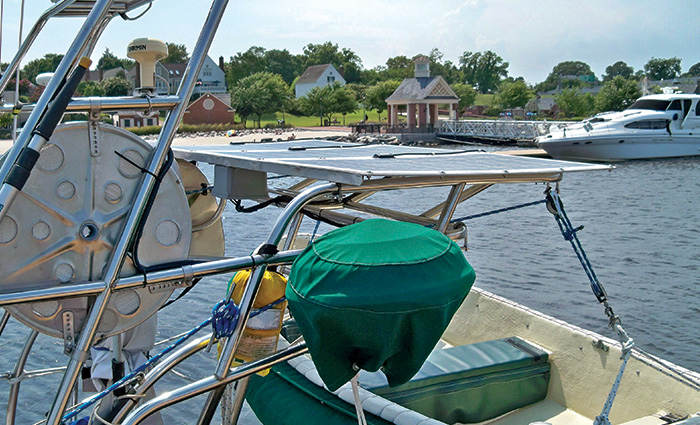
I first embraced the idea of solar power while up a pole (literally) in the Atlantic Intracoastal Waterway replacing dead batteries. It was the early 1980s, and I was maintaining buoys, beacons, and other such Aids To Navigation (ATON) for the U.S. Coast Guard, replacing massive, nonrechargeable batteries with rechargeable solar-powered ones. The higher-ups said the solar rechargeables would last six years – twice as long as the one-shot batteries. As the deck-ape in charge of lugging all those batteries up and down the ladders, my back and I immediately appreciated the whole “free power from the sun” thing, a concept I continue to embrace.
The strategy behind s olar energy onboard is simple: A solar panel converts sunlight into electricity, after which wiring conducts it to your batteries for storage until needed. Solar panels are used to keep batteries or banks charged rather than to power equipment directly. This arrangement allows the panels to store generated power whenever produced, while providing a steady source of power to a piece of equipment even when the panel is producing no power.
While they do require an initial outlay, solar panels can easily pay for themselves in money saved and independence gained over their service life. They’re noiseless, have no moving parts, and they provide free electricity for years with minimal maintenance. Solar panels also have the benefit of being modular, letting you start small and add more as your power requirements increase.
The benefits of solar
Almost any boat can benefit from solar power. Whether at a slip, mooring, or on a trailer, boats can keep their batteries topped off without the need for external power. You can also use solar power to supplement or even replace other onboard charging sources, reducing or eliminating the need to run engines or generators to keep batteries topped off (a wasteful practice that burns fuel while wearing down the costliest pieces of equipment onboard).
While underway, it’s a plus to be able to recharge a dead battery in an emergency – say, to operate a VHF radio or navigation gear. While dockside, solar panels keep batteries charged and vital systems (such as bilge pumps) up and running without the need for shore power.
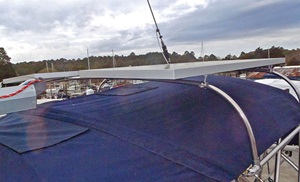
Just about any boat can benefit from solar power, whether it’s to keep batteries topped off or supplement other onboard charging sources.
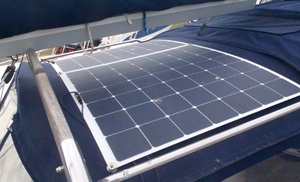
Mount solar panels where they are exposed to maximum sunlight but do not interfere with operation of the vessel.
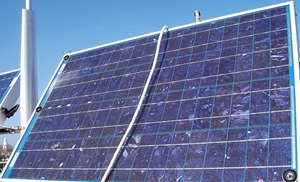
Bottom: Something as simple as the shadow of a line or shroud can reduce or halt output.
Types of panels
Solar panels contain photovoltaic cells – small silicon semiconductor devices that convert sunlight into electricity. Each cell generates between 0.45 and 0.5 volts, depending on exposure to direct sunlight. Cell size determines amperage, with a 3-inch cell producing roughly 2 amps, a 4-inch cell a little over 3 amps, and a 5-inch cell around 5 amps.
Construction-wise, the three main types of solar panels are monocrystalline, polycrystalline, and amorphous (or thin-film) technology.
Monocrystalline panels have been around the longest and remain the most popular. The panels are constructed of thin slices of crystal silicon (each cell is cut from a single crystal) housed in a rigid, aluminum frame and covered with tempered shatterproof glass. The panels have a uniform black, blue, or gray appearance and are generally quite rugged, although they can be cracked or broken if subjected to extreme abuse.
Monocrystalline panels have the longest service life of the three types. With a conversion efficiency of around 17%, they’re also the most efficient and have the highest electrical output per area, but they are also the most expensive.
Polycrystalline cells are sliced from a cast silicon block and have a shattered glass appearance. Built in much the same way as monocrystalline panels, they’re rectangular, giving the panel itself a tiled look. Their life span is similar to monocrystalline panels, and while their conversion efficiency is lower (by 14%), they’re also a bit less expensive.
Amorphous panels are made by placing a thin film of active silicon on a solid or flexible backing (such as stainless or aluminum sheeting) depending on whether the panel is to be rigid-framed and glass-fronted or flexible. Flexible amorphous panels, in which cells are sandwiched between rubber and polymer covers, are light and tough enough that you can walk on them and, in some cases, even roll them up for storage.
This type of solar panel is also better if shade is an issue. With crystalline panels, even the thin shadow of a rope or shroud across one cell can reduce or halt output of an entire module. Amorphous panels have “bypass” diodes that essentially turn off shaded cells and provide a current path around them. Some monocrystalline panels also have bypass diodes, but this feature comes at an increase in cost.
Amorphous panels are the least expensive of the three types, but their efficiency is also lower – around 8%, or roughly half that of a monocrystalline type. This lower output is somewhat mitigated in newer panels, however, which use three-layer construction. Each layer absorbs different colors of the solar spectrum, so the panel will deliver more power longer each day and during lower light conditions than the other two types.
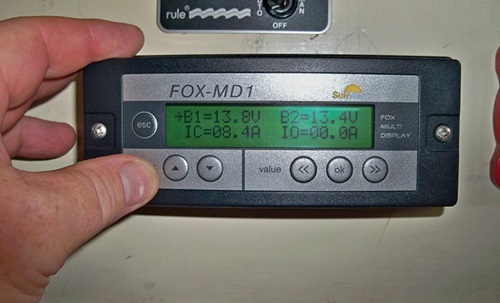
The charge controller should be mounted below decks and as close to the battery as possible.
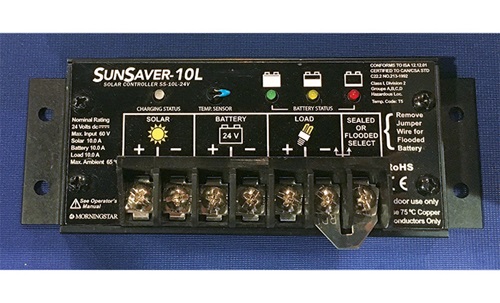
Follow manufacturer instructions for wire connections.
Planning the system
While factors such as cost, mounting options, and output are important, a successful installation depends on knowing what you want the system to accomplish. Is the goal to float-charge a single battery or supplement an overall vessel energy plan? Answering these questions up front will help determine the type, size, and number of panels required.
To understand the process better, let’s walk through the basic steps to determine power requirements and installation considerations for a single solar panel installation. While the example itself is simple, the steps are the same used to plan more complicated installations.
For our example, the goal is to install a solar panel to provide charging for a single 12-volt, 100-amp-hour wet-cell battery used to power an automatic anchor light on a moored vessel.
The first step is compiling a daily power consumption estimate to determine how much solar power is needed.
The daily self-discharge rate for a wet-cell battery is roughly 1%, meaning our 100-amp-hour battery requires one amp every 24 hours just to maintain the status quo. The anchor light draws 50 milliamps per hour of operation, and we’ll assume it operates 10 hours each night. Multiplying current draw (50 milliamps) by hours of daily operation (10) generates a daily energy expense of 500 milliamps or .5 amps.
This means our solar panel must meet a minimum daily energy tab of 1.5 amps – one amp of battery self-discharge rate plus .5 amps of power draw for the anchor light.
Next up is figuring out panel size and the best mounting location. For our example, let’s assume the panel will be a horizontal, fixed-mount installation. A 10-watt horizontally mounted panel should generate between 3- and 5-amp hours per day.
We’ll need at least 13 volts to fully charge our 12-volt battery. As most solar cells generate at least 0.45 volts, you’ll want a panel with a minimum of 33 cells, which should provide around 14.85 volts.
Keep in mind that’s the minimum needed, which may not be enough once you factor in a few cloudy days. Most panels are designed to generate between 15 and 20 volts to overcome problems like cloudy days or inherent electrical resistance within the panel or installation components. While this higher voltage lets you make up for less electrically productive days, it also means you’ll want to install a solar charge controller (voltage regulator) to avoid battery damage due to overcharging.
Attempts to plan a system that tries to use the output of the panel and capacity of the battery to prevent overcharging (and avoid the installation of a charge controller) is false economy and should not be done. The system will never meet its full output potential and, worst case, can damage the battery due to overcharging.
A word on ‘charge controller confliction’
If your vessel has multiple charging sources, such as solar panels and a wind turbine, a crucial but often overlooked consideration is “charge controller confliction.” In short, this is an issue where the charge controller for your solar panel and the charge controller for your wind turbine are internally adjusted to the same maximum charge voltage set point. This means they are constantly fighting each other to be the dominant power source, which results in diminished overall charging output and performance. An in-depth article on this issue can be found at missioncriticalenergy.com (in the website footer, click “Superwind Turbine Manuals & Technical Bulletins.” Under the header “Charge Controllers,” select the document “Resolving Charge Controller Confliction”).
While this article addresses charge controller confliction at remote, off-grid sites, the information provided is also applicable to vessel installations. — F.L.
Location and mounting
Solar panels should be mounted in a location where they are exposed to the maximum amount of sunlight but do not interfere with operation of the vessel or the movement of passengers and crew. Solar panels will typically be either fixed or mounted on some type of movable bracket that allows you to actively point the panel toward the sun for maximum output. Both methods have their pros and cons. Fixed panels (which are normally mounted horizontally) don’t produce as much power as a panel that can be adjusted to face the sun. The downside is that adjustable panels must be aimed throughout the day to maximize their output.
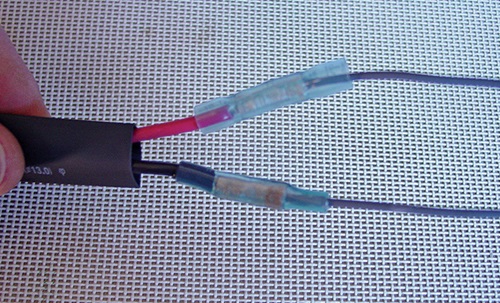
Use good quality, marine-grade heat shrink connectors (top) and liquid electrical tape (right) to create airtight, waterproof seals and reduce corrosion.
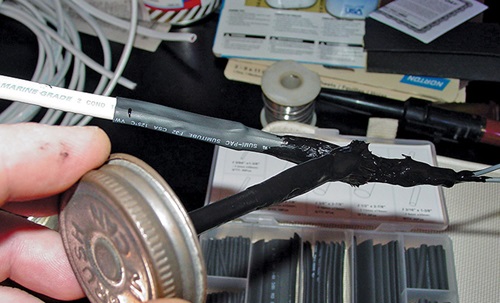
Installation
After choosing and mounting your panel, it’s time to connect it. The first thing you need to determine is the size (gauge) of the wiring to be used. Multiply your panel’s rated amp output by 1.25 (which adds a 25% safety factor). Then measure the length of the entire wiring run, panel to battery, and multiply by 2. Once you have these two numbers, refer to the American Boat and Yacht Council’s (ABYC) 3% voltage-drop table for wire size. Ancor Products offers a handy wire calculator on its website ( ancorproducts.com/resources ).
Always use good quality marine grade connectors and tinned, multi-stranded copper wire with vinyl sheathing. The wire will run from the solar panel to the charge controller first, then to the battery. Try to keep the wire run as short as possible, and if it transits an external deck or cabin house (it likely will), be sure to use an appropriate weatherproof deck fitting.
The charge controller should be mounted below decks and as close to the battery as possible. You’ll always want to follow the manufacturer’s instructions for connections, but in a typical installation you’ll connect the solar panel’s positive (red wire) lead to the charge controller’s positive input wire or terminal and the negative (black wire) lead to the charge controller’s negative input wire or terminal.
Next, connect the charge controller’s negative output to the battery negative terminal and the controller’s positive output to the battery’s positive terminal via an appropriately sized in-line fuse (or circuit breaker). ABYC recommends these be installed within 7 inches of connection to the battery or other point in the DC system. To reiterate, the installation of the charge controller can vary among models, so follow the manufacturer’s installation instructions.
Finally, ensure all connections are waterproof and secure any loose wire runs with wire ties and cable clamps for a neat installation. Then get ready to lean back and soak up some free sun.
Related Articles
The truth about ceramic coatings for boats.
Our editor investigates the marketing claims of consumer-grade ceramic coatings.
Fine-Tune Your Side Scan Fishfinder
Take your side-scanning fishfinder off auto mode, and you’ll be spotting your prey from afar in no time
DIY Boat Foam Decking
Closed-cell foam flooring helps make boating more comfortable. Here’s how to install it on your vessel
Click to explore related articles
Frank Lanier
Contributing Editor, BoatUS Magazine
Capt. Frank Lanier is a SAMS Accredited Marine Surveyor with more than 40 years of experience in the marine and diving industries. He’s also an author, public speaker, and multiple award-winning journalist whose articles on boat maintenance, repair, and seamanship appear regularly in numerous marine publications worldwide. He can be reached via his YouTube channel “Everything Boats with Capt. Frank Lanier” and website captfklanier.com.
BoatUS Magazine Is A Benefit Of BoatUS Membership
Membership Benefits Include:
Subscription to the print version of BoatUS Magazine
4% back on purchases from West Marine stores or online at WestMarine.com
Discounts on fuel, transient slips, repairs and more at over 1,200 businesses
Deals on cruises, charters, car rentals, hotel stays and more…
All for only $25/year!
We use cookies to enhance your visit to our website and to improve your experience. By continuing to use our website, you’re agreeing to our cookie policy.
- BOAT OF THE YEAR
- Newsletters
- Sailboat Reviews
- Boating Safety
- Sailing Totem
- Charter Resources
- Destinations
- Galley Recipes
- Living Aboard
- Sails and Rigging
- Maintenance
- Best Marine Electronics & Technology

Adding Solar Power to a Sailboat
- By Emily Fagan
- Updated: October 18, 2019
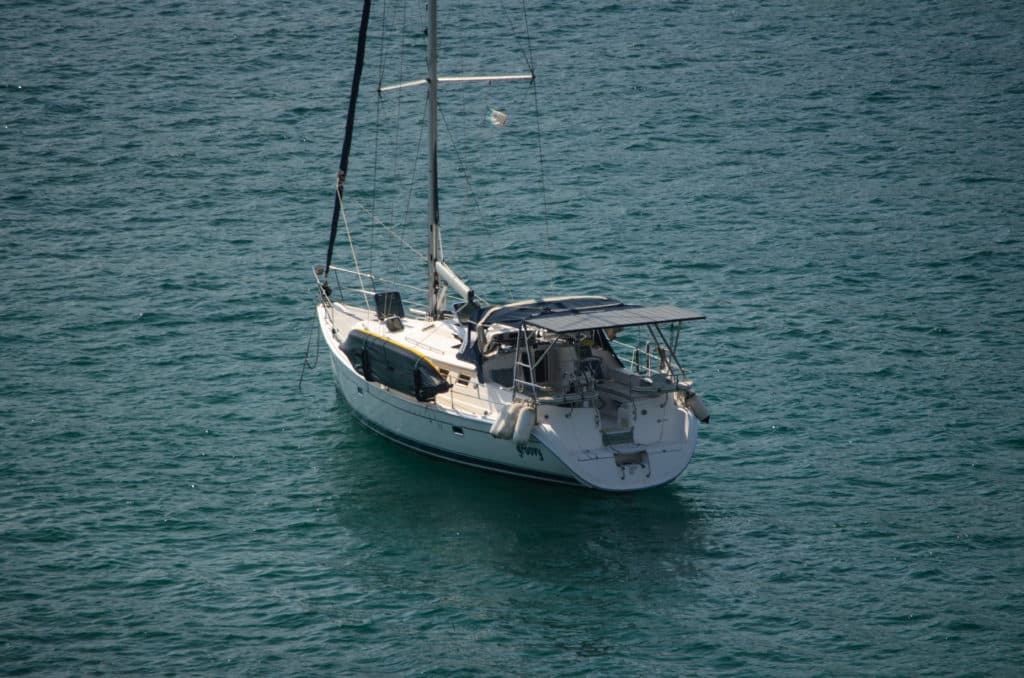
During our nearly four-year cruise of Mexico, my husband, Mark, and I lived almost exclusively on 555 watts of solar power charging a 640-amp-hour house battery bank. We anchored out virtually every night aboard our 2008 Hunter 44DS, Groovy , and relied on the sun for power. During one 10-week stretch, while we waited for a replacement engine alternator to arrive, our boat’s solar panels were our sole source of power. We had no backup charging system to turn to, and yet we lived and sailed comfortably the entire time. Mounting solar panels on a sailboat was not difficult, but a few key decisions made a huge difference in how effective our panels were.
A solar-power installation on a sailboat is made up of two independent systems: one system to charge the batteries, and another system to provide 120-volt AC power for household appliances. In the charging system, the solar panels convert sunlight into electrical current and deliver it to the batteries via a solar charge controller. Similar to a voltage regulator, the charge controller acts as a gatekeeper to protect the batteries from receiving more current than they need as they are being charged. In the AC power system, an inverter or inverter/charger converts the 12-volt DC power in the battery into 120 volts AC whenever it is turned on.
Panel Positioning and Wiring Considerations
One of the biggest challenges for sailors installing solar power on a sailboat is finding a place on the boat where the panels will be shaded as little as possible. Just a few square inches of shade on one panel can render that panel all but inoperable. Unfortunately, between the mast, radome, spreaders and boom, shadows cross the deck all day long, especially as the boat swings back and forth at anchor.
What’s worse, if the panels are wired in series rather than in parallel, this little bit of shade can shut down the entire solar-panel array. When we installed solar power on Groovy , we had already lived exclusively on solar power in an RV for over two years. Our RV solar panels had been wired in series, and we had witnessed the array shutting down current production when just half of one panel was shaded.
Choosing whether to wire the panels in series or parallel on a boat affects the wire gauge required, which is why many solar-power installers lean toward wiring the panels in series. Panels wired in series can be wired all the way to the solar charge controller with a thinner-gauge wire than those wired in parallel. This is because the voltage of panels wired in series is additive, while the current remains constant, so the current flowing is just that of a single panel. In contrast, the current flowing from panels that are wired in parallel is additive, while the voltage across them is not. This means that in a parallel installation, the current going to the charge controller is several times higher and requires much thicker cable to avoid any voltage loss over the length of the wire.
Not only is thinner-gauge wire less expensive, but it is also more supple and easier to work with, making the job of snaking it in and around various crevices in the boat and connecting it to the solar charge controller much less of a struggle. Thus the choice between series and parallel wiring boils down to a trade-off between system performance, expense and ease of solar system installation.
Luckily, the size of the wire can be reduced if higher-voltage solar panels are chosen. Since watts are determined by multiplying volts by amps, a higher-voltage panel that generates the same watts as a lower-voltage panel will produce less current. Therefore, selecting nominal 24-volt panels instead of 12-volt panels allows for the use of thinner wire sizes no matter how they are wired.
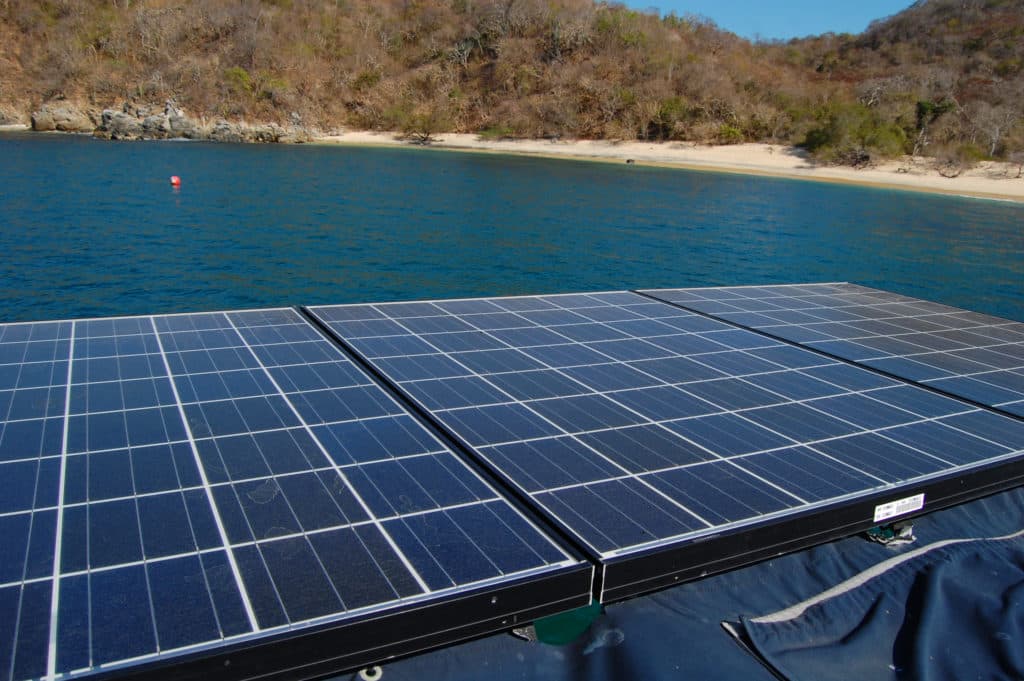

Our Marine Solar Panel Design Choices
In our installation, we decided to mount three 185-watt, 24-volt (nominal) Kyocera solar panels high above the cockpit, well aft of the boom, as far away as possible from potential shade. Our Hunter came with a big, solid stainless-steel arch, and we turned to Alejandro Ulloa, a brilliant metal fabricator at Baja Naval Boatyard in Ensenada, Mexico, to build a polished stainless-steel solar-panel arch extension onto the existing structure. He designed the arch extension with integrated telescoping davits to hoist our dinghy as well as support the solar panels. These davits were strong enough — and the lines and blocks had enough purchase — that either of us could lift our light Porta-Bote dinghy with its 6-horsepower outboard without a winch.
We spaced the panels about a half-inch apart and wired them in parallel. Using two twin-lead wires, we snaked the three positive leads and one common ground down through the inside of the arch tubes so they wouldn’t be visible, and placed wire loom over the exposed wires under the panels.
The junction points for the three parallel panels were on positive and negative bus bars inside a combiner box, all mounted in a cockpit lazarette. Inside the combiner box, we installed three breakers, one for each panel. This gave us the ability to shut off any or all of the panels if we needed to (we never did).
We mounted a Xantrex solar charge controller (model XW MPPT 60-150) in a hanging locker, as close to the batteries as possible, in a spot where it was easy to monitor and program. We ran twin-lead wire from the combiner box to the charge controller and from there to the batteries.
Our boat came with three new 12-volt Mastervolt 4D AGM house batteries, all wired in parallel, for a total of 480 amp-hours of capacity. We wanted a bigger house battery bank, and because it is best for the age, type and size of the batteries to be matched, we added a fourth new Mastervolt 4D AGM house battery, which brought our total to 640 amp-hours. Our batteries were installed at the lowest point in the hull, below the floorboards, and they ran the length of the saloon, from just forward of the companionway stairs to just aft of the V-berth stateroom door.
The best way to charge a bank of batteries that are wired in parallel is to span the entire battery bank with the leads coming from the charge controller. We did this by connecting the positive lead from the charge controller to the positive terminal of the first battery in the bank, and the negative lead from the charge controller to the negative terminal of the last battery. By spanning the entire bank, the batteries were charged equally rather than having the charging current focused on just the first battery in the bank.
We feel that AGM batteries are superior to wet cell (flooded) batteries because they can be installed in any orientation, don’t require maintenance, can’t spill (even in a capsize), and charge more quickly. Our Mastervolt batteries, like almost all AGM batteries on the market, are dual-purpose, combining the very different characteristics of both deep-cycle and start batteries. Our batteries work well, but if we were doing an installation from scratch today, we would consider the new Trojan Reliant AGM batteries. These batteries are engineered strictly for deep-cycle use and have been optimized to provide consistent current and maximize battery life.
Our boat came with a Xantrex Freedom 2,500-watt inverter/charger wired into the boat’s AC wiring system with a transfer switch. The inverter/charger performed two functions. While the boat was disconnected from shore power, it converted the batteries’ 12-volt DC power into 120-volt AC power, allowing us to operate 120-volt appliances, like our microwave. When the boat was connected to shore power, it charged the batteries.
Because this inverter/charger was a modified-sine-wave inverter, mimicking AC current with a stair-stepped square wave, we also had a 600-watt pure-sine-wave inverter to power our potentially more sensitive electronic devices. We chose Exeltech because its inverters produce an electrical signal that is clean enough to power medical equipment, and they are NASA’s choice for both the Russian and American sides of the International Space Station. For simplicity, rather than wiring the inverter into the cabin’s AC wiring, we plugged ordinary household power strips into the AC outlets on the inverter and plugged our appliances into the power strips. Like the charge controller, the inverter must be located as close to the batteries as possible. Ours was under a settee.
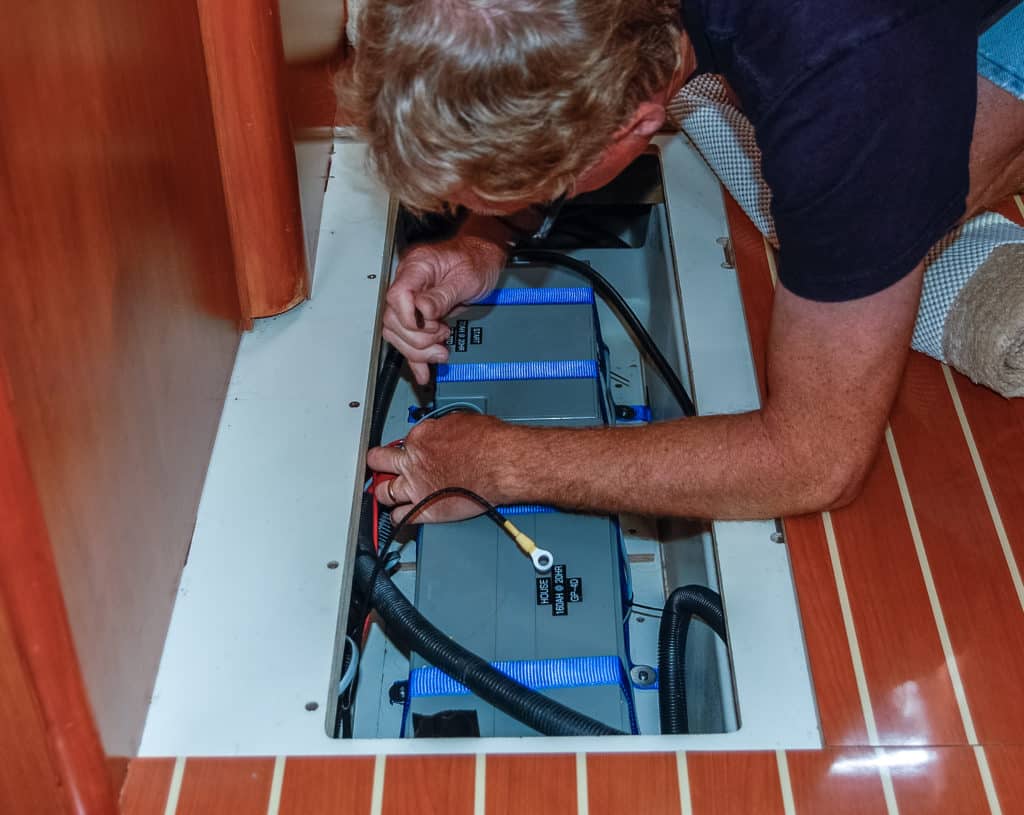
Shade’s Impact on Sailboat Solar Panels
Once our solar installation was completed on our sailboat, we closely observed the effects of shade on our solar-panel array. We were often anchored in an orientation that put the panels in full sun. Just as often, however, we were angled in such a way that shade from the mast and boom covered portions of our panels. It was fascinating to monitor the solar charge controller’s LCD display whenever the sun was forward of the beam — the current from the panels to the batteries fluctuated up and down as we swung at anchor.
Taking notes one morning, we noticed that the charging current was repeatedly creeping up and down between 9.5 and 24.5 amps as the boat moved to and fro. When the entire solar-panel array was in full sun, it generated 24.5 amps of current. When we moved so the mast shaded a portion of one panel, the array generated 15 amps. When it shaded portions of two panels and only one was in full sun, the array produced just 9.5 amps. Of course, it would have been preferable to see a steady 24.5 amps all morning, but this sure beat watching the current drop to zero whenever a shadow crossed a panel.
We discovered that shade makes a huge impact while sailing, too. Surprisingly, it is far worse to have the panels shaded by the sails than to have the panels in full sun but tilted away from its direct rays. One afternoon, we noticed that while we were on a tack that tilted the panels away from the sun, they generated 24.5 amps of current, whereas on a tack where the panels were tilted toward the sun but two of the three were partially shaded by the sails, the current dropped to a mere 10 amps.
Reflections On Our Solar Panel Installation
A wonderful and surprising side benefit of our large solar panels and arch system was that the setup created fabulous shade over the jumpseats at the stern end of the cockpit. Our metal fabricator, Alejandro, placed a support strut at hand-holding height, and sitting in those seats feels secure and comfortable while sailing, no matter the conditions.
After living on solar power for eight years of cruising and land-yacht travel, we’ve learned that you can never have too much solar power. Groovy’s 555 watts was enough to run all our household appliances as needed, including our nearly 4-cubic-foot DC refrigerator, two laptops, a TV/DVD player, and lights at night. However, it was not quite enough power to run all that plus our stand-alone 2.5-cubic-foot DC freezer during the short days and low sun angles of the winter months without supplemental charging from the engine alternator every few days. For the 10 weeks that we did not have a functioning alternator, our solution was to turn off the freezer, which enabled our batteries to reach full charge every afternoon.
Solar power made a world of difference in our cruise. Not only did it allow us to live comfortably and with ample electricity for weeks on end when our engine alternator went on the blink, but as a “set-it-and-forget-it” system, it also gave us the freedom to anchor out for as long as we wished without worrying about the batteries. In our eyes, the solar-panel arch enhanced the beauty and lines of our boat, giving her a sleek and clean appearance. It was true icing on the cake to discover that the panels and arch system also provided much-needed shade over the cockpit and helm from the hot tropical sunshine. If you are preparing for a cruise, consider turning to the sun for electricity and outfitting your sailboat with solar power.
The Installation:
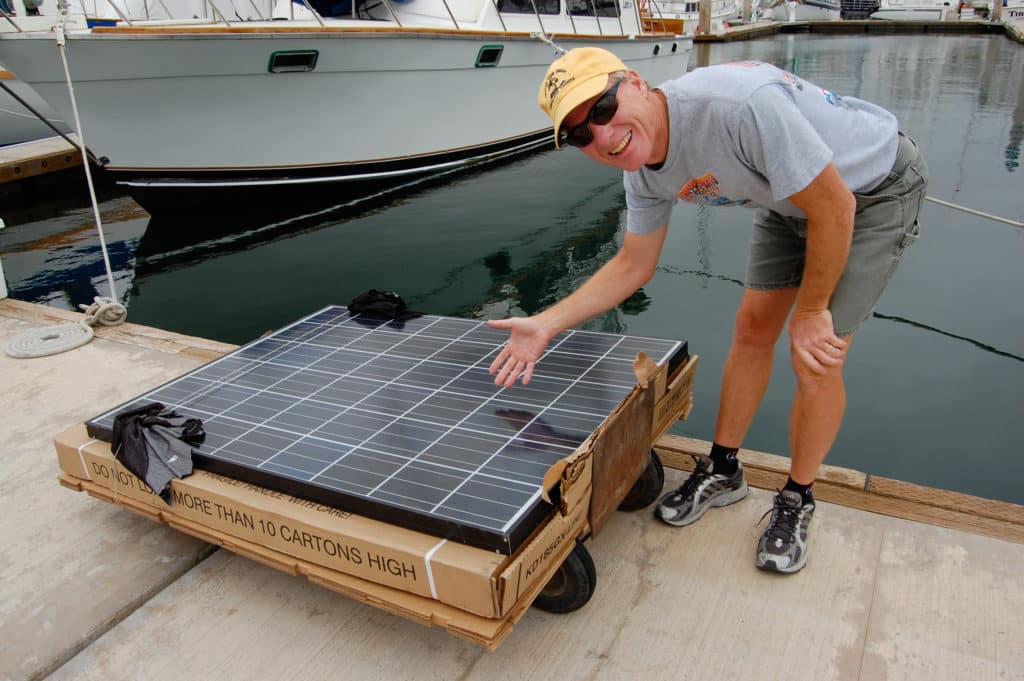
Emily and Mark Fagan offer cruising tips and share their stories and photos on their website, roadslesstraveled.us . They are currently enjoying a land cruise across America aboard an RV.
- More: DIY Sailboat Projects , green sailing , How To , installations , Refits , Sail Green , solar , solar panel , Upgrades
- More How To

3 Clutch Sails For Peak Performance

It’s Time to Rethink Your Ditch Kit

8 Ways to Prevent Seasickness

How To De-Winterize Your Diesel Engine

Kirsten Neuschäfer Receives CCA Blue Water Medal

2024 Regata del Sol al Sol Registration Closing Soon

US Sailing Honors Bob Johnstone

Bitter End Expands Watersports Program
- Digital Edition
- Customer Service
- Privacy Policy
- Email Newsletters
- Cruising World
- Sailing World
- Salt Water Sportsman
- Sport Fishing
- Wakeboarding

Sustainability Success
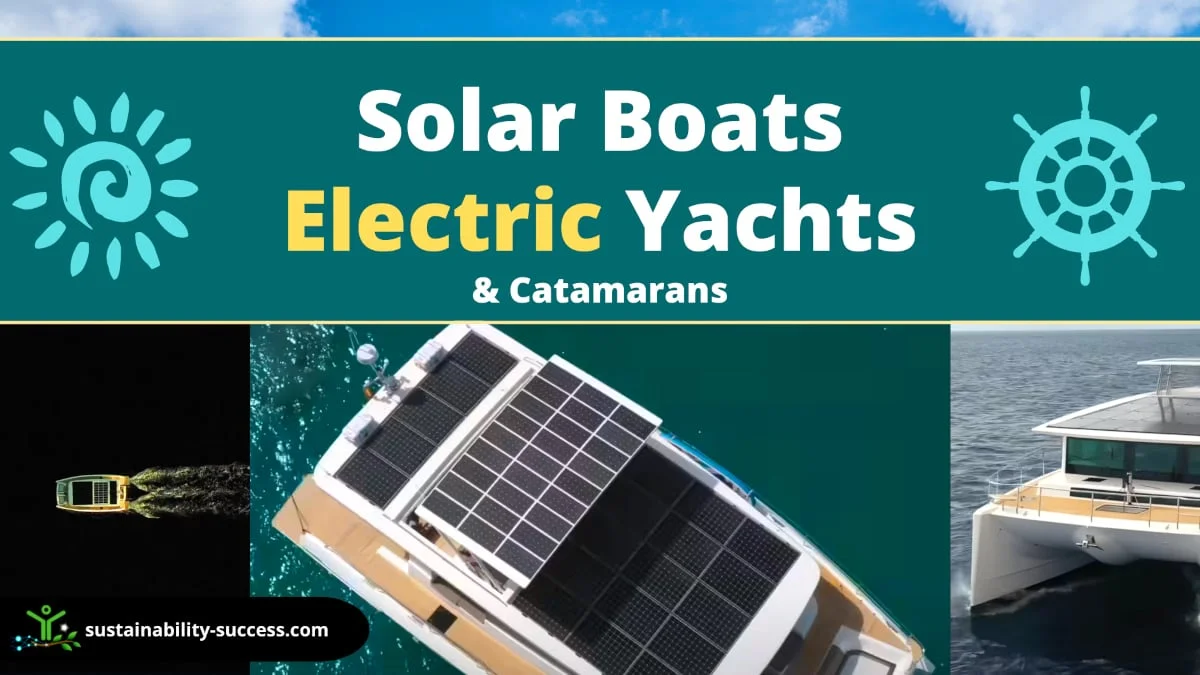
10 SOLAR Boats 2023 & 2024 | Electric Yachts & Catamarans
With more steps being taken towards sustainable development, new, eco-friendly solar boats have been introduced in the world of green travel: solar electric catamarans.
Solar boats are electric yachts that can go for long distances without needing to stop for fuel and without emissions. Those solar catamarans are interesting eco-friendly alternatives to the classic power boat or sailing yacht for cruising. However, there are also a few disadvantages that you should know about before purchasing one!
Table Of Contents
10 Solar boats, electric yachts & catamarans
Here are the best solar boats that will delight you with a top-notch sustainable yachting experience based on your requirements:
Sunreef Yachts – Eco 80 Sail Catamaran
- Silent Yachts – Silent 80 3-Deck
HH Catamarans – HH44
Silent yachts – silent 60, sunreef 43m eco (140 ft).
- Silent 120 Explorer
- 100 Sunreef Power Eco
Azura Marine – Aquanima 40
Soel yachts – soel senses 48, serenity yachts – serenity 64 (hybrid).
Here’s a quick summary of the features of the best solar catamarans for green yachting in 2023-2024:
If you are an advocate of sustainable yachting or sustainable tourism and are looking to buy an eco-friendly boat that doesn’t rely on fossil fuels , then you would do well to consider getting a solar catamaran. In this article, I will go through the pros and cons of 10 of the best solar yachts and superyachts that you can buy in 2023 and 2024!
It is also important to note that while there are solar panels for sailboats that you can fit on older models, those new boats have been specifically designed to maximize the use of renewable energy.
Most Luxurious + Most innovative solar system
The Eco 80 Sail Catamaran is one of the electric solar boats provided by Sunreef Yachts.
It features a unique “solar skin” that covers all composite structures on the boat, including hull sides, boom, mast, bimini, and superstructure. This green tech makes it possible to place solar panels where it wouldn’t normally be possible (like the hull and any other smaller but useful surface) and provide enough solar energy from every angle.
The boat is 80-feet long (24.38 meters) and includes electric motors that push it smoothly over the water without causing any vibrations or noise.
Besides being solar powered boat, the Eco 80 Sail Catamaran can also be powered by wind and hydropower. It is designed with a sail on its structure, allowing it to tap into wind power and supplement the solar.
The solar powered sailboat generates enough green power not only to propel the boat and keep it moving but also to charge the essential electric water appliances and other water-sport toys.
So far, the Sunreef Yachts Eco solar sailboats have earned a good reputation for being eco-friendly and sustainable. Besides, this solar powered catamaran takes its commitment to the environment a notch higher by using recycled materials , natural fibers, and non-toxic paints to create their boats.
It is no wonder that Sunreef Yachts have been winning environmental awards for so many years. This solar sailboat is one of the most remarkable boats you can ever invest in and it clearly shows the latest advancements in technology .
Prices: about $8 million USD
Where to buy : Sunreef Yachts .
- Larger surface covered with solar panels, that are installed also along the hull, and in other unusual areas.
- The batteries are 30% lighter than normal
- Unlimited cruising range.
- It runs silently and does not cause pollution.
- It has also traditional sails, so it can cruise also when it is not sunny without relying on batteries.
- Luxury, superb quality and finishing
- Great helm position.
- The solar catamaran is very costly (going for $8 million USD or more).
- The solar panels installed on the sides of the catamaran may not be appealing to the eye of all people.
Silent Yachts – Silent 80 Tri-Deck Solar Catamaran
Best pure electric
The Silent 80 Tri-Deck Solar yacht is popular for the large amount of space it offers.
This solar catamaran by Silent Yachts features three large decks that can be easily customized to fit the owner’s preferences and needs. The topmost deck can either be open or enclosed.
This solar powered yacht offers 4 to 6 cabins that are customizable, regardless of whether the deck remains open or enclosed. Besides, the top deck provides additional living space and can be used as a luxury master suite that opens onto a private space outdoors.
Where to buy : Silent Yachts .
- Purely electric propulsion that can be helped by the kite sail.
- The finishing, while being of high standards, doesn’t seem to be at the level of other options in its category.
- Quite costly, with prices starting at about $6 million USD.
- If going for a long cruise during cloudy days you may need to run the generator to keep going.
- The kite sail helps to give some propulsion using wind, but it is less effective than traditional sails.
- The absence of a traditional sail may make the boat a bit less stable, compromising a bit of the comfort while cruising.
Best for world cruising
HH Catamarans is a small boutique boat builder designing some of the most impressive solar boats for cruising, with one of their latest creations being the HH44.
The HH44 is a groundbreaking new boat that is designed to be eco-friendly and efficient.
The boat has a large battery bank that can be charged by solar panels, and also has two electric motors that can be used for electric propulsion up to 7 knots for up to 2h.
The HH44 has an innovative propulsion system named Eco-Drive. This is a parallel hybrid system that combines diesel and electric propulsion for long-range motoring and silent electric propulsion.
The boat also has two diesel engines, which can be used for long-range motoring or to generate electricity. The boat is also designed to be safe, with four propulsion devices plus sails and a large solar array.
The HH44 has a number of technical features that make it a groundbreaking eco-friendly design, including:
- 3 types of propulsion: full electric, standard diesel, and sail.
- 4.2 kWh of solar panels: generating power for recharging the lithium battery bank for solar .
- 10 kW electric motors (5kW each): mounted on the back end of each diesel engine for electric propulsion.
- The diesel engines can be used both for propulsion and as electric generators.
- Possibility to use the propellers to recharge the battery while the boat is sailing. Kind of like using hydropower to charge your solar batteries , pretty cool!
The HH44 is also a performance catamaran thanks to its C-shaped §daggerboards. Daggerboards are an essential component of many sailing vessels, providing both vertical lift and increased upwind sailing performance.
This solar powered yacht features up to 4 double cabins and 2 heads . Not bad for this world-cruising vessel!
If instead, you are looking for a larger boat, HH Catamarans also have other models up to 88ft.
This solar catamaran was also the preferred choice of Gone with the Wynns , a popular cruising YouTube channel. Here’s their announcement video:
Where to buy : HH Catamarans .
- A true performance world cruiser.
- Very resilient with 3 different propulsion modes (electric, sail, and conventional engines) and ideal for offshore cruising.
- It can run silently and without causing pollution.
- More affordable than other solar catamarans, starting from $1 mm USD
- Smaller than other options.
- The improved sailing performance requires narrower hulls, which reduces the available space onboard compared to other traditional vessels of similar size
Best mid-range
The Silent 60 is one of the smaller electric boats made by Silent Yachts. It is designed to be handled by at least two people. The users can either choose to include an additional crew or not.
Despite its outward small appearance, Silent 60 is very spacious and can accommodate a good number of people.
Besides, the electric yacht has a beautiful design that adds to its elegant and luxurious feel. It is usually designed with up to 6 cabins , with each cabin offering every basic amenity you need to have a luxurious stay on the yacht. In fact, the electric solar boat is equipped with everything you need to allow you to live on board permanently!

As someone who loves spending time on the water, I was really excited to learn about the Sunreef 43M Eco: a superyacht that is both eco-friendly and luxurious.
I was especially impressed by the solar power system, which is built into the composite structures of the yacht, and the large hydraulic platform which creates a vast walkaround beach club.
The interior of the solar superyacht is just as impressive as the exterior, with a variety of sustainably-sourced materials and fabrics used throughout as well as energy-saving air-conditioning. The Sunreef 43M Eco can welcome up to 12 guests in the most luxurious conditions.
Silent Yachts – Silent 120 Explorer

Here’s another incredible solar super-yacht by Silent Yachts. The Silent 120 Explorer is a truly unique yacht, designed to explore the world in style and comfort.
Powered by solar energy, this solar catamaran is perfect for those who want to enjoy the beauty of the open seas without worrying about the impact on the environment.
With plenty of space for guests and all the amenities you need onboard, the Silent 120 Explorer is the perfect choice for your next adventure. If you’re looking for a yacht that combines luxury and environmental responsibility, the Silent 120 Explorer is a perfect choice.
The company didn’t yet release detailed information, however, this superyacht seems to be even featuring a helipad under the roof’s solar panels!
The Silent 120 Explorer has plenty of room for guests and all the amenities you need onboard. So if you’re ready to embark on your next great adventure, be sure to consider the Silent 120 Explorer, which will likely start being delivered in 2023.
The 100 Sunreef Power Eco
Sunreef recently launched and sold their first 100 Sunreef Power Eco catamaran, a transatlantic luxury craft that takes solar boat design to the next level.
With massive living space, great autonomy, and impressive features like a flybridge that can be transformed into an outdoor cinema, the 100 Sunreef Power Eco is the perfect vessel for cruising in supreme luxury
This catamaran uses the latest innovations in solar power to achieve outstanding energy efficiency, and its ultralight battery bank provides for silent cruising and infinite range.
The fully customizable interior and exterior make this catamaran a truly one-of-a-kind option, and its use of ethically-sourced and eco-responsible materials is sure to please even the most discerning buyer.
If you’re looking for an electric yacht that is both luxurious and eco-friendly, the 100 Sunreef Power Eco is certainly a great option for you if you can afford it!
The most affordable $
The Aquanima 40 catamaran is entirely powered by solar energy. It features creative adaptations and unique innovations that make it eco-friendlier and more economical boat than other solar-powered catamarans. For example, the solar panels installed on the electric catamaran are built in such a way that they can sell any excess solar energy back to shore stations when connected.
The exterior of the Aquanima 40 has an elegant design. Also, the interior is not only aesthetically pleasing, but also very clean and modern.
The boat is designed with 2 single cabins for the crew and 2 double cabins for guests.
Indeed, this solar boat by Azura Marine is one of the most economical and cost-effective options you can go for when buying a solar catamaran.
- Relatively fast.
- Ideal for short vacations.
- The most affordable solar catamaran, starting at about $0.6 million USD.
- Much smaller than other options.
- Not recommended for long cruises.
- Basic looks and layout.
As its name suggests, the Soel Senses 48 is 48 feet long. It has a slender design and is lightweight , making it more economical than most other solar-powered boats.
The boat is designed with two sleeping berths that can accommodate two people each. It also includes a salon that can offer enough sleeping space for four people.
Compared with most other solar yachts, the Soel Senses 48 has a much smaller size. Its size, adding to its sleek and innovative design, give it faster speed than other solar-powered boats.
It incorporates 12 solar panels installed on the roof ; all these panels generate a combined electrical power of up to 2.7 kWh. The electricity generated by the solar panels is then stored in two batteries which can be easily configured to hold a maximum solar power of 142 kWh.
Like other Soel Yachts, the Soel Senses 48 glides smoothly over water without causing any noise, rattles, or generating fumes.
It has average cruising speeds of 10 knots, even reaching top speeds of up to 18 knots. However, the solar catamaran cannot run at its top speed for long periods.
Both the interior and the exterior of the Soel Senses 48 have a sleek and modern design. Every single component of the solar catamaran has been designed carefully to make it as functional and comfortable as possible. Therefore, when you board on this boat, you can expect to experience one of the best sailing experiences of your life.
The Serenity 64 Yacht features a diesel engine. It is a hybrid solar boat, which means that it can run on either solar power or on diesel.
The diesel engine especially comes in handy when the users wish to achieve faster cruising.
The solar catamaran is a very spacious electric boat and provides plenty of living space. It is built with four luxurious cabins, with each cabin having its ensuite bathroom. And even though the Serenity 64 is smaller than the Serenity 74 model also built by Serenity, it still provided an elegant feel and a smooth sailing experience.
Solar Boats Pros and Cons
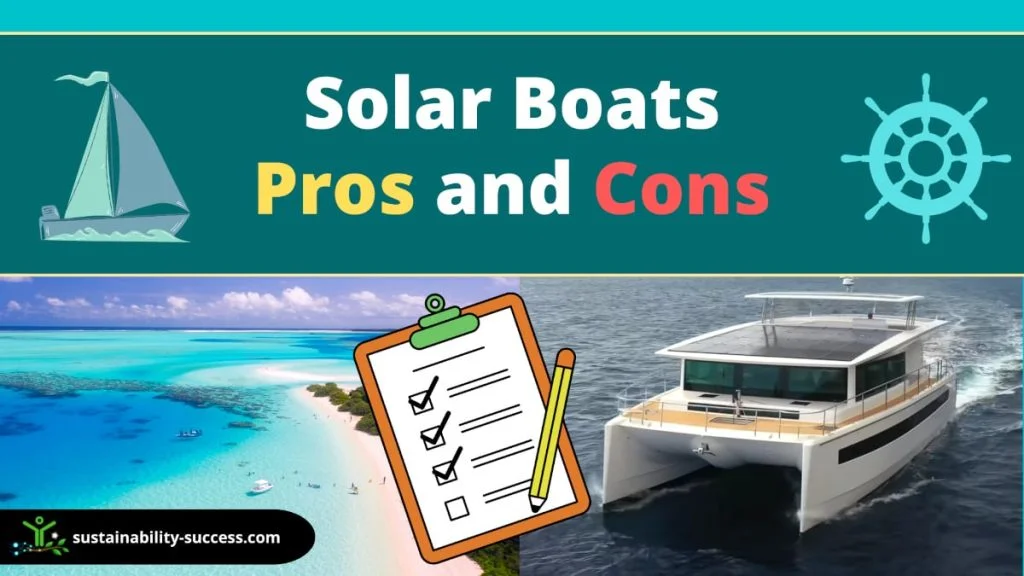
The sun is a powerful and free source of energy, making solar power an attractive option for those looking to power their yacht. Solar panels can be used to generate electricity to run the yacht’s lights, appliances, and even the engine. Solar power can also be used to heat water for showers and laundry. But, what are the pros and cons of solar catamarans?
Here’s a quick summary of the solar yachts’ advantages and disadvantages:
One of the main benefits of solar power is that it is renewable and environmentally friendly. Solar panels have no emissions and do not produce pollution. In principle, they also do not require fuel, making them very cost-effective in the long run. Solar power is also very reliable, as the sun is a constant source of energy.
There are a few disadvantages to solar power. Solar panels can be expensive to install, and while they require less maintenance, this can be quite costly, especially when it will come time to replace the batteries. Solar panels also need to be pointing directly at the sun to be effective, so they may not generate power on cloudy days or at night.
But there’s more, let’s see what some sailing experts are thinking about solar catamarans!
Sailing expert’s solar Boat review
Recently, one of the most popular sailing YouTube channels, Saliling La Vagabonde , published a very honest and interesting review of the solar powered yacht Silent 55. Here’s a summary of their experience:
- 7 Days onboard (6 nights)
- Travelled 145nm with an average speed of 7 knots
- Generator used for about 12h (in total)
- Fuel consumed: 208 liters
Here are some interesting observations they made:
- While cruising it may feel less stable than a standard sailing boat because it doesn’t have a sail to stabilize it when hitting the waves.
- For the Silent 55 it was possible to move at about 3 knots by using only the power generated by the solar panels (without using the batteries) on a sunny day. This means that if you are moving the solar yacht around quite frequently, you will end up using the generator quite a lot to produce the necessary power.
- When the batteries are out of power, the Silent yacht is using a (diesel) generator to supply the necessary power to keep the boat moving and to power the appliances.
- A great luxury yacht with all the comforts and going in the right direction for the future of the sector.
- Overall, the Silent Yacht is a great eco-friendly alternative to a power boat , while if you are thinking about cruising around the world, you would be probably better off going for a standard sailboat (or for some of the hybrid alternatives mentioned in this article, like the HH44).
Why are solar yachts all catamarans?
Solar yachts are all catamarans for 2 main reasons:
- Catamarans have a larger surface, which allows for placing more solar panels and also offers more room for the batteries onboard.
- Catamarans have efficient hulls for their size. This reduces their power consumption while moving.
This makes catamarans the ideal platform to build a solar-powered boat.
Modern solar electric boats are undoubtedly an eco-friendly choice in sea travel and a form of green tourism . Not only do these electric boats provide a smooth sailing experience, but they also reduce the release of emissions into the atmosphere, reducing the environmental impact and enhancing sustainability .
Luckily, given their size, solar catamarans can charge themselves (unlike electric cars ), so they can sail indefinitely without the need to stop for refueling.
If you are environmentally conscious and looking to get a boat that is more viable, desirable, and eco-friendly, you may consider investing in one of the solar yachts discussed in this article!
Suggested Articles
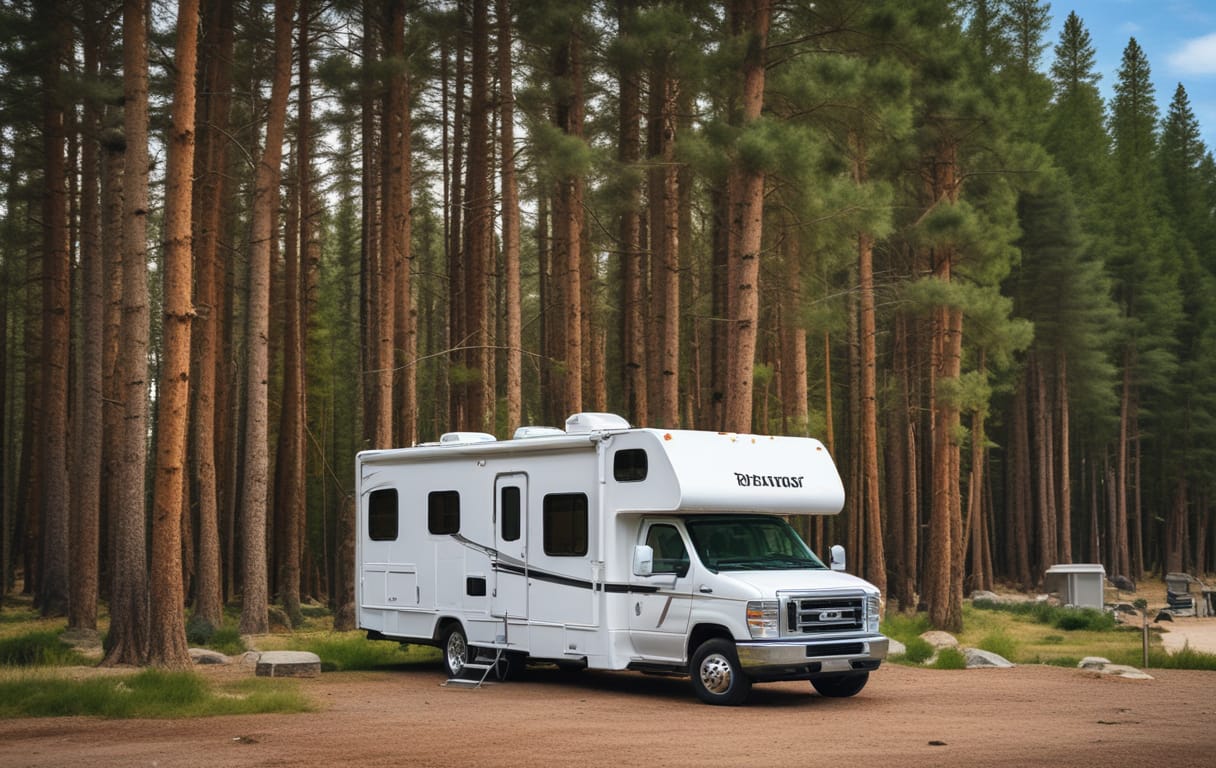

Top 3 Best Solar Panels For Sailboats

Last Updated by
Daniel Wade
June 15, 2022
Choosing whether or not to install solar panels on your sailboat is a big decision. They are not exactly cheap, though they can start to pay themselves off pretty quickly.
This article is going to cover not only why you might want to use solar panels but all the benefits they provide. You will also find a helpful guide on which solar panels would be best for you and your budget. Hopefully, by the end, you will feel confident in your decision to install solar panels on your sailboat and even have an idea of which ones you might like.
Table of contents
Are solar panels on sailboats necessary?
Whether or not you should be installing solar panels on your boat is a matter of choice, not out of necessity. Sailboats get their power from the wind, by harnassing it in their sail. So if you plan to be sailing for the afternoon you probably don’t need solar panels.
You could charge a battery pack from the marina and that will probably see you through several trips. The problems only really start to arise if you are planning to be on your sailboat for longer periods, or even permanently. If you plan to live on your sailboat year-round, even if you spend 80% of it in a marina, you would be better off with some solar panels. Even if it is just as a backup source of power.
Are solar panels on boats safe?
Solar panels are generally pretty safe. They have no moving parts and typically have a very strong protective cover over them so you never come in contact with the electrics themself. So, as a source of power, they are generally pretty safe. The only time they may become unsafe is if they are badly damaged.
Solar panels are often covered by glass plating that keeps them safe. It also helps them absorb sunlight and warmth. This is great, except when the glass breaks. If the glass protective cover on your solar panels should crack and splinter you are at risk of serious injury from sharp shards of glass. Not only is the glass itself dangerous at this point, so are the electronic components inside. They have powerful currents running through them, and if you come in contact with them you may be in for a shock.
Furthermore, if these electronics get wet they can become deadly. Electricity and water do not mix well at all. Being as you are on a sailboat, at sea, the chances of them getting wet is very high. Luckily, the chances of them breaking in the first place are slim to none. The only real way they would break, besides vandalism, is by debris hitting them during a bad storm. There is not often debris at sea, so this shouldn’t be too much of a problem.
What are the benefits of having solar panels on a sailboat?
There are so many great benefits of having solar panels on a sailboat. They can be a lifesaver if you find yourself at sea for a long time. There benefits range from trivial comforts to being the difference between life and death. Here are some of the benefits you might not have considered about having solar panels installed on your sailboat.
Money-saving
Solar panels are not cheap, it is far cheaper to just run a generator or charge your batteries from the marina the whole time. At least, it is in the short term. Over time, it can start to become very expensive. With solar panels, you are looking at a big initial cost (the solar panels themself) and then it’s smooth sailing. You don’t need to pay for power again. Solar panels last for about 40 years before they start to become too inefficient at producing power. The cost of a few solar panels upfront compared to 40 years of marina fees and gasoline for a generator is the financially savvy move.
Emergency power
If you find yourself at sea, the wind dies down (or becomes too strong), and you find yourself stuck bobbing around waiting for more favorable conditions you may run into trouble. Depending on how long you are out there, you may find yourself with dead electronics. Be it a satellite phone, radio, or secondary engine (depending on the boat). Having a set of solar panels and a power bank can be a genuine lifesaver in these situations.
Comfort amenities
Whether you are day sailing or making a week-long voyage, having access to the comforts in life can make the whole journey so much more enjoyable. The amenities may not be available to you without having a constant source of power at sea. Having access to a kettle, tv, videogame system, radio or microwave oven may be the only thing keeping you going at rougher times. As exciting as sailing can be, when you aren’t sailing and are just bobbing around it can be quite dull. The sea is beautiful, but there is only so much time you can spend looking at the water before you miss the comforts of land. With solar panels, you can bring those comforts with you.
Eco-friendly
There are only two alternatives to solar panels. A gasoline generator, and taking power from the grid. Neither of these is good for the environment. Luckily, solar panels are a great third option. Solar panels are completely eco-friendly and are great for the environment. This is not just great for the earth, and your conscience, but for the journey itself. If you are running a gasoline generator at sea you are going to be listening to it thrumming away and smell the burning gasoline. Wouldnt you prefer silence and nothing but the smell of the sea breeze?
How much do solar panels cost?
How much solar panels cost is almost entirely tied into both their voltage/wattage and whether or not they are portable panels. Portable solar panels are great for people who don’t spend a lot of time on their boat or are happy enough living off the marina’s power grid. Permanent solar panels, the kind that may need to professionally installed, can end up costing far more. They are also likely to be far superior and you can pretty much forget about them once they are installed.
Portable solar panels will cost just a few hundred dollars each. You will need a few to be sustainable, but that’s not going to be much of a problem. These portable solar panels can just be rolled out on the deck of your boat, weighed down, and then hooked up to a battery pack. The battery itself here is going to be the most expensive part of the whole set up. A decent-sized battery could set you back a $1000. But, when charged fully it will last days. Even with constant use.
Permanently installed solar panels can cost one or two thousand dollars in some cases. The advantage here though is once they are installed that’s it, you can forget about them. You don’t have to put them up, take them down, and find somewhere to stow them every time they need using. They too will need to be hooked up to a battery, the battery is still only going to cost you $1000. If you are installing permanent solar panels because you plan to be making long voyages, it is ideal to have two or perhaps even three large batteries hooked up to your boat. One to run off, one or two for emergencies.
How do I maintain my solar panels?
Solar panels, unlike gasoline generators, are generally pretty easy to maintain. They have no moving parts and are thus pretty self-sufficient. They don’t need taking apart and they last as long as 40 years. That being said, if they do break they need repairing as soon as possible. The exposed electrics can be deadly when water is thrown into the mix. Which, on a boat, is almost always. The glass cover will need replacing and the electronics inside may need repairing, though not always. Don’t ever attempt to do this yourself unless you are experienced at making these repairs. The cost of hiring someone to do it for you is preferable to being dead. Solar panels have very powerful electric currents, that when in contact with water and yourself can be fatal. As mentioned above, these panels rarely break so you will likely not ever run into this problem. If you do, hire a contractor.
Do my solar panels need cleaning?
Solar panels work by converting the light and heat of the sun into useable power. The process itself is rather complicated but the results are simple to understand. That being said, there are some reasons that your solar panels will stop working as effectively. They all revolve around a lack of sunlight. It could be because it is night time. It could be because it is very cloudy. Or, it could be because they are dirty. If solar panels become too dusty, dirty, and become too covered in grime they stop operating at maximum efficiency. This is not as much of a problem at sea, the sea spray stops dust settling. The biggest thing you will need to clean off your solar panels is salt build-up and slime. This is easy enough to do with some warm soapy water. Freshwater, not seawater. You want to be removing as much salt as possible. Salt is corrosive to electronics, so removing it is important. Never clean your solar panels using pressure washers as they can crack the glass.
Which are the best solar panels for sailing?
There are so many options on the market at various price points. Here are three very different options that will all make good choices, depending on your needs. It is important to consider not just price but power output. Spending a lot of money on solar panels now might not feel ideal, but it is the most cost-effective decision.
1. Renogy Starter Kit
This starter kit is going to be perfect for installing on almost any sized boat. There are four solar panels, each can be fitted permanently to the boat. They can be mounted (and unmounted) easily, for your convenience. They do require a flat surface, but they are small enough that that likely won’t be too much of a problem. This starter kit is very middle of the pack price-wise but should provide enough power for a small to medium-sized vessel easily. It is also possible to buy extra panels individually should you need them.
Wattage: 400/4 (100 per panel)
2. Nature Power Rigid
The nature power rigid is a large, powerful, single solar panel. If you are looking for the right panels to power your entire boat comfortably, these are the ones for you. They are very large so they will need a large flat surface area. alternatively, they can be hung vertically from rails. This is an inefficient way of using them, so you would need to buy more this way. Nature power makes various solar panels so you could find some smaller ones of the same brand to supplement it. This one is not so easy to install, you might need to hire someone to install it for you.
Wattage: 165
3. Nature Power Monocrystalline
Nature power makes a portable solar panel that fits inside a special briefcase. It is perfect for stowing away easily and only taking it out when it is needed. It is decently powerful considering its portable, but there is the inconvenience factor of having to set it up each time. If you planned to buy the nature power rigid, buying one of these portable panels might be ideal for supplementing your power supply when it is especially sunny. Though, it may be cheaper for you to just fit more of the Nature Power Rigids.
Wattage: 120
Hopefully, you now have a good idea about whether solar panels would be right for you and your sailboat. Sailing is great, but the lack of power at sea can be dreadfully boring. Luckily, there are so many great options available on the market. Not just the ones mentioned above. Buying a solar panel is an investment, the initial cost is minor compared to the steady return from all the savings you will make.
Related Articles
I've personally had thousands of questions about sailing and sailboats over the years. As I learn and experience sailing, and the community, I share the answers that work and make sense to me, here on Life of Sailing.
by this author
Sailboat Upgrades
Most Recent

What Does "Sailing By The Lee" Mean?
October 3, 2023

The Best Sailing Schools And Programs: Reviews & Ratings
September 26, 2023
Important Legal Info
Lifeofsailing.com is a participant in the Amazon Services LLC Associates Program, an affiliate advertising program designed to provide a means for sites to earn advertising fees by advertising and linking to Amazon. This site also participates in other affiliate programs and is compensated for referring traffic and business to these companies.
Similar Posts

How To Choose The Right Sailing Instructor
August 16, 2023

Cost To Sail Around The World
May 16, 2023

Small Sailboat Sizes: A Complete Guide
October 30, 2022
Popular Posts

Best Liveaboard Catamaran Sailboats
December 28, 2023

Can a Novice Sail Around the World?
Elizabeth O'Malley

4 Best Electric Outboard Motors

How Long Did It Take The Vikings To Sail To England?

10 Best Sailboat Brands (And Why)
December 20, 2023

7 Best Places To Liveaboard A Sailboat
Get the best sailing content.
Top Rated Posts
Lifeofsailing.com is a participant in the Amazon Services LLC Associates Program, an affiliate advertising program designed to provide a means for sites to earn advertising fees by advertising and linking to Amazon. This site also participates in other affiliate programs and is compensated for referring traffic and business to these companies. (866) 342-SAIL
© 2024 Life of Sailing Email: [email protected] Address: 11816 Inwood Rd #3024 Dallas, TX 75244 Disclaimer Privacy Policy
- New Sailboats
- Sailboats 21-30ft
- Sailboats 31-35ft
- Sailboats 36-40ft
- Sailboats Over 40ft
- Sailboats Under 21feet
- used_sailboats
- Apps and Computer Programs
- Communications
- Fishfinders
- Handheld Electronics
- Plotters MFDS Rradar
- Wind, Speed & Depth Instruments
- Anchoring Mooring
- Running Rigging
- Sails Canvas
- Standing Rigging
- Diesel Engines
- Off Grid Energy
- Cleaning Waxing
- DIY Projects
- Repair, Tools & Materials
- Spare Parts
- Tools & Gadgets
- Cabin Comfort
- Ventilation
- Footwear Apparel
- Foul Weather Gear
- Mailport & PS Advisor
- Inside Practical Sailor Blog
- Activate My Web Access
- Reset Password
- Pay My Bill
- Customer Service

- Free Newsletter
- Give a Gift

How to Sell Your Boat

Cal 2-46: A Venerable Lapworth Design Brought Up to Date

Rhumb Lines: Show Highlights from Annapolis

Open Transom Pros and Cons

Leaping Into Lithium

The Importance of Sea State in Weather Planning

Do-it-yourself Electrical System Survey and Inspection

Install a Standalone Sounder Without Drilling

When Should We Retire Dyneema Stays and Running Rigging?

Rethinking MOB Prevention

Top-notch Wind Indicators

The Everlasting Multihull Trampoline

How Dangerous is Your Shore Power?

DIY survey of boat solar and wind turbine systems

What’s Involved in Setting Up a Lithium Battery System?

The Scraper-only Approach to Bottom Paint Removal

Can You Recoat Dyneema?

Gonytia Hot Knife Proves its Mettle

Where Winches Dare to Go

The Day Sailor’s First-Aid Kit

Choosing and Securing Seat Cushions

Cockpit Drains on Race Boats

Rhumb Lines: Livin’ the Wharf Rat Life

Re-sealing the Seams on Waterproof Fabrics

Safer Sailing: Add Leg Loops to Your Harness

Waxing and Polishing Your Boat

Reducing Engine Room Noise

Tricks and Tips to Forming Do-it-yourself Rigging Terminals

Marine Toilet Maintenance Tips

Learning to Live with Plastic Boat Bits
- Sailboat Reviews
EXPO Solar Sailer
Designed as a sail trainer, this dinghy with an electric motor and solar panel makes a fun family boat..
Put Gary Hoyt, Ted Hood and Everett Pearson in a canoe and you have the marine industry’s maximum tripartite brain power. The cerebral sparks from these three New England dynamos produced the EXPO Solar Sailer.
Introduced at Sail Expo ’93 in Atlantic City, the EXPO Solar Sailer is a brilliant, purposeful little boat. The object is to “solo” a rank beginner in an hour.
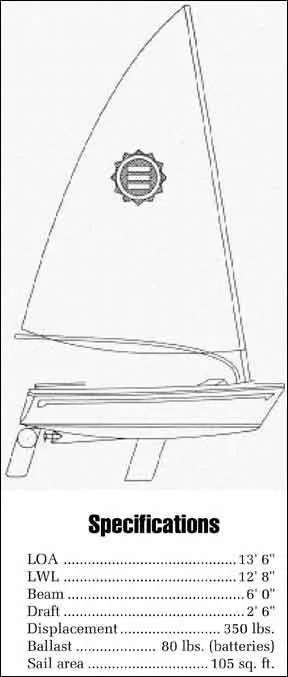
Despite its utility as an educational tool, the 13-1/ 2-foot boat was dubbed by Naval Architect Bob Perry as “an ideal daysailer for a sailor with a relaxed attitude.”
In short, it’s a fun boat-at the other end of the scale from, for instance, a sailboard, which is guaranteed to make anyone look foolish for a couple of weekends.
Design and Construction
The EXPO was conceived by Hoyt (who has a long list of conceptions to his credit), designed by Hood (who needs no introduction) and built by TPI (at present, or one time or another, the builder of J Boats, Aldens, Jeanneau catamarans and Freedoms).
“It takes both the mystery and the fear out of learning to sail,” said Hoyt, who, beginning with the Freedom 40, has spent 20 years trying to take the mystery out of learning to sail. He can talk for hours about how fast, tippy boats intimidate beginners, and that if the sailing industry is serious about attracting newcomers, it must first provide a simple, safe boat that won’t scare off those on the edge of jumping in. That’s the premise of the EXPO Solar Sailer.
Hood calls the EXPO a “cruising Finn dinghy” because the shape of the hull, although beamier, is like the Olympic-class Finn. Pearson is proud of the EXPO’s sturdiness.
The hulls are “Infused Resin Molded” using a vacuum-bagged, injected resin system that creates a powerful, high strength-to-weight composite that should defy decades of hard usage.
She’s a fat little rascal, very stable. Hoyt said that of the 70 built and in use as of late 1994, mostly in educational programs and rental businesses, he knows of only one capsize (by a very hefty gentleman beginner who, in a stiff breeze, jibed and didn’t move until he was in the water).
The white-painted aluminum boom, independent of the rotating mast, arches up and over the cockpit. You’d have to stand up to get clouted. Hoyt has applied for a patent on the free-standing boom.
The 14-pound, tapered carbon fiber mast rotates on a Harken base. The 105-square-foot, loose-footed sail furls on the mast, very easily controlled by a continuous line that serves also as an outhaul. The outhaul and rotating mast also provides reefing, in seconds, with little effort.
On the non-skid deck just forward of the cockpit is a permanently-mounted windvane with color-coded sectors. To trim the sail, the beginner merely matches the color-sector indicated by the vane to the color-coded mainsheet, held in a Harken cam cleat pedestal mounted in the cockpit.
The kick-up rudder is mounted inboard, not only to make it very accessible to the skipper but to give the EXPO a proper yachty look. The daggerboard is easy to operate and has a stopper hole and pin to secure it in the withdrawn position. With the board up and the rudder taking care of itself, the EXPO can simply be winched up on a dock or trailer.
It has a two-way Henderson pump, one channel to pump the hull, the other for the cockpit, which is not self-draining because Hoyt wanted to keep the floor low for adequate leg room. A commodious bow compartment with a well-fitted door provides stowage for a cooler, lunch, foul weather gear and an anchor and rode (in case you want to stop to fish or swim).
The EXPO displaces 350 pounds. It carries up to six persons, but Hoyt conceded that with that load she’d be crowded and sluggish.
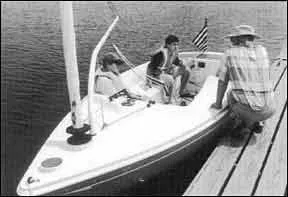
To get away from the dock and motor about, it has an electric engine powered by two securely-anchored gelcell batteries (with an in-line regulator and battery meter) charged by a flexible Unisolar solar panel mounted neatly on the deck aft of the cockpit.
There’s also a built-in 110-volt charging unit. The simple engine switch handle provides three forward speeds and two in reverse. The little prop is protected by a skeg. In flat water, the boat will motor at close to 3 knots (full power) for three hours, five hours at half-speed. Hoyt warned that, under power, it will not work against much of a chop.
Aboard the EXPO, you can shove off and be sailing in five minutes. The EXPO has a hull speed of 4.7 knots, which it should reach in a moderate breeze, even while dragging the little prop on the Minnkoto engine.
The Sail Trainer Test
To try out the EXPO, we dragooned two lads—a 14-year-old experienced Laser racer (he happens to be our son, Kyle Nouse), and Kyle’s 14-year-old buddy, Joe Costa, who knew absolutely nothing about sailing. In fact, he never before had been aboard a sailboat of any kind.
At Newport’s Ida Lewis Yacht Club, the day was hot, with a moderate breeze, with some slightly heavy gusts.
We elected to conduct the test as though we had bought the EXPO for use on an inland lake or bay, taken it out of the crate, assembled it, and said, “It’s all yours, boys.”
Our experienced lad looked over the boat for no more than 10 minutes, tried the furling and the engine controls, pushed the daggerboard down, straightened up the mainsheet, cast off and in less than three minutes was sailing back and forth. Our neophyte, Joe Costa, watched carefully from the dock.
As instructed, Kyle furled the sail and motored back to the dock, with little ado. All he said was, “Awesome.” but he says that often.
With Kyle as a passenger (under orders to not provide even a speck of help or advice), Joe Costa stepped aboard, a bit timorously, settled himself in the starboard aft corner of the cockpit and cast off. He motored away from the dock, hooked the boat into the wind, unfurled the sail, checked the color-coded wind vane and sheet and shouted, “Hey, I’m sailing!”
There was one glitch. Because Joe had an overwhelming tendency to jibe to starboard, round and round and round and round, he skinned too close to shore and ran aground. Kyle quickly furled the sail, put the engine in reverse, pulled up the daggerboard (she draws 2′ 6″ with the board down), backed into deeper water and had Joe sailing again in two or three minutes.
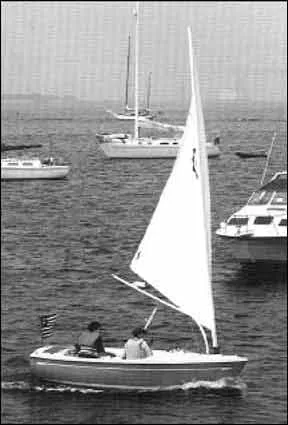
After coming into the dock to collect Joe’s wits and add a little advice about going to weather and the need to shift his butt to the windward side, off the boys went again, this time for a half-hour sail, during which Kyle quickly refined Joe’s skill at tacking, jibing and, most of all, going straight.
Kyle said the most difficult part for Joe was going to weather, keeping the boat moving in a straight line, and then tacking.
It all took about an hour and a half, at the end of which Kyle and Joe were zipping around the harbor, changing helmsmen frequently. When hailed, they responded:
“Do we have to come in now?”
When they did, they were making plans to go out in a Laser, at which time Joe’s learning curve will take a steep upward turn.
What do we think of the EXPO?
It’s a marvelous design, beautifully built with a great rig. With a sail area/displacement ratio of 37 and a displacement/length ratio of 76, it moves very well in most any kind of air. Reefed down a bit, it can handle some fairly heavy going.
However, as a dinghy, the EXPO wouldn’t do. It’s too heavy to tow or lift aboard. It might make a tender or harbor sailor for a big boat that can hoist her aboard, but unshipping the mast would be difficult.
As a teaching tool for both youngsters and adults, this little boat is peerless, squarely meeting its designed intent better than any boat we’ve ever seen. For both commercial usage and for junior programs at yacht clubs and sailing associations, it’s ideal.
We also see the EXPO as simply a very safe, comfortable, inland lake or bay boat that would be a joy to own.
The 1994 price, $6,415, which includes everything, reflects the high quality present in every detail. The price is difficult to compare with other daysailers. Lined up against engineless boats like a Laser ($3,200) or a Sunfish ($2,200), she’s expensive.
However, compared with a 15’ West Wight Potter at $5,995, a Peep Hen 14 with a 4-hp. outboard at $7,245, or an American 14.6 (a Carolina version with an outboard and trailer) at $4,250, the EXPO seems reasonably priced.
RELATED ARTICLES MORE FROM AUTHOR
Leave a reply cancel reply.
Log in to leave a comment
Latest Videos

Island Packet 370: What You Should Know | Boat Review

How To Make Starlink Better On Your Boat | Interview

Catalina 380: What You Should Know | Boat Review
- Privacy Policy
- Do Not Sell My Personal Information
- Online Account Activation
- Privacy Manager
solarboatsUSA.com Your Gateway to Green Boating where Innovation meet sustainability
(619) 997-1288
- e-tech electric drives
- Solliner for rent
Infinity solar boats
Welcome to solar electric boat "solliner".

Explore our Boats
Luxury yachts.
Experience the ultimate renewable energy boating. Perfect for entertaining guests or enjoying a romantic evening with your significant other.
Solliner is a solar-powered electric catamaran that offers numerous benefits for eco-friendly boating experiences. It is sustainable, relying on solar energy and producing zero emissions during operation. The catamaran's silent operation enhances the enjoyment of nature and wildlife without disturbing their habitats. It is also highly energy-efficient, eco-friendly watercraft utilizing advanced solar technology and lightweight materials to maximize energy usage and extend the cruising range.
With a reduced number of moving parts, Solliner requires less maintenance and has lower overall maintenance costs. Additionally, it offers a luxurious onboard experience with comfortable seating areas, lounges, and open deck spaces for relaxation and entertainment and zero-emission green boating experience.
The electric propulsion system is easy to operate, making it accessible to a wide range of users. Overall, Solliner combines sustainability, silent operation, energy efficiency, low maintenance, luxury, and ease of use to provide a premium boating experience while minimizing environmental impact for eco-conscious mariners.
SOLLINER with more than standard equipment
Equipment details.
This Solliner 21 is equipped with the following features and its today's price is $70000 delivered to Miami, FL
4-kW Electric motor with appropriate batteries and charger and 1120W of solar panels
Electric engine lift system
Electric horn
Blue metallic iridescent vinyl wrap hull color
Depth Finder
Extra LED lighting in the cockpit, engine compartment, between hull in the front
Marine grade radio with Bluetooth and two waterproofed speakers
Radar reflector (folding)
2 fishing pole holders
Folding SS swim ladder
Forward LED reflector
Extra table for the fishing rod holder
Solliner is wonderful family boat
White solliner with a standard equipment, solliner with black and white details.
This is a basic electric boat model. It has a 3-kW engine with two 210Ah AGM (Absorbent Glass Mat) batteries.
Beautiful and simple contrasting color scheme Price for the standard model at this moment is $60300
We have two used Solliners available to own. If interested contact Tad at
619 997 1288
Discover the Beauty of Infinity Solar Boats Watercraft Collection
Luxurious Solliner 31 Hybrid, Fully autonomous, speed up to 20 m/h
Luxurious configuration 275000 euro
Solliner 31 commercial configuration 20 passengers and 3 crew. 215000 euro
Wonderful solar-electric eco-friendly catamaran
Meva - classic craft for boats enthusiasts - solar-electric
Site content, meva - solar - electric boat.
Electric boat Meva is a fiberglass boat with a top side finished elegantly with a teak wood.
Meva can be powered by one or two motors.
It is very easily maneuverable and can run
15 km/h powered by 4 batteries 210 Ah each.
Length of 20.1' width 6.5'
High quality finish
Spacious with 360 degree view.
Meva is beautifully finished in high quality materials for upholstery and teak wood interior.
Space for 8 to 10 passengers with folding teak table for elegance and comfort.
Solar power extending batteries life
Under sit space is utilized for storage and two coolers.
This electric boat is powered by four batteries that if not used for 2/3 days can be recharged by this 300 W solar panel that works as a cover for very large storage compartment.
Sun deck of this electric boat can be used buy covering the solar panels. All this beauty for just $50000
Infinity Solar Boats's Fleet in Pictures: Browse Our Boat and Yacht Gallery
Please click DOWNLOAD to see the new catalog of this electric boat.
2018-09-25_katalog_solliner (pdf)
Infinity Solar Boats - authorized dealer for solliner
Elegant black version, solliner ran 3000-km without shore charging in poland, driving this boat is eeeeasssy.
I discovered Solliner boats in 2015 vacationing in Poland.
I noticed three decent sized boats motoring by with good speed and no noise. Looking closer, I realized that these boats were electric and powered by solar panels.
September 2018, I visited Poland again to purchase a few of the most unique boats to bring to the US. I was fortunate to have several summer-like days and able to drive three different Solliners. It was easy, relaxing, smooth, fast (up to 12 km/h ), quiet and had no exhaust fumes - just the smell of fresh air. I loved it!
Solliner boats have a high grade marine electric engines powered by four AGM (Absorbent Glass Mat), marine batteries, 210-Ah each. AGM batteries are the most advanced batteries, AGM batteries provide 3X longer life span at max power.
It provides essentially unlimited travel distance since it is constantly charged by 1120-W solar panels
More about Solliner
How to order solliner, where can you see solliner.
The standard version of Solliner costs $60300 delivered to Miami . Discounted prices
for orders of multiple boats. Pricing to be negotiated.
Call for details 619 997 1286
Solliners are located in Sarasota, Florida
www.infinitysolarboats.com gets you to Solliner rental site
Videos and pictures from the locations of the Solliner on my: facebook.com/solarboatsUSA
plus a lot more.
Testimonials
Current deals.
YouTube and Facebook videos and testimonials, from mostly European boat owners and users, can be found by searching ‘Solliner’. There is an excellent 2016 university presentation by Green Dream Boats representative Bartlomiej Zientek, click here Facebook page is
www.facebook.com/solarboatsusa
Search YouTube for Solliner
We just became a distributor for E-tech electric boat motors. Check the website
www.etechdrives.com
Solliner comes with a one year bumper to bumper warranty on mechanical and electric parts from Infinity Solar Boats plus all manufacturer warranties and a 2-year warranty on the structural integrity of the boat.
Distance with solar charging is unlimited when operating with less than 80% of the engine power.
No solar charging: 3 hours at full speed 7 m/h
No solar charging: 8 hours at 4 m/h
Drop us a line!
This site is protected by reCAPTCHA and the Google Privacy Policy and Terms of Service apply.
Better yet, see us in person!
We love our customers, so feel free to visit during normal business hours.
www.solarboatsUSA.com
Centennial Park Boat Ramp, Sarasota, Florida 34236, United States
6199971288 , [email protected]
Copyright © 2019 Infinity Solar Boats - All Rights Reserved.
Powered by GoDaddy Website Builde9

Suggested Searches
- Climate Change
- Expedition 64
- Mars perseverance
- SpaceX Crew-2
- International Space Station
- View All Topics A-Z
Humans in Space
Earth & climate, the solar system, the universe, aeronautics, learning resources, news & events.

NASA Study: Asteroid’s Orbit, Shape Changed After DART Impact

US, Germany Partnering on Mission to Track Earth’s Water Movement

Tech Today: NASA Helps Find Where the Wildfires Are
- Search All NASA Missions
- A to Z List of Missions
- Upcoming Launches and Landings
- Spaceships and Rockets
- Communicating with Missions
- James Webb Space Telescope
- Hubble Space Telescope
- Why Go to Space
- Astronauts Home
- Commercial Space
- Destinations
- Living in Space
- Explore Earth Science
- Earth, Our Planet
- Earth Science in Action
- Earth Multimedia
- Earth Science Researchers
- Pluto & Dwarf Planets
- Asteroids, Comets & Meteors
- The Kuiper Belt
- The Oort Cloud
- Skywatching
- The Search for Life in the Universe
Black Holes
- The Big Bang
- Dark Energy & Dark Matter
- Earth Science
- Planetary Science
- Astrophysics & Space Science
- The Sun & Heliophysics
- Biological & Physical Sciences
- Lunar Science
- Citizen Science
- Astromaterials
- Aeronautics Research
- Human Space Travel Research
- Science in the Air
- NASA Aircraft
- Flight Innovation
- Supersonic Flight
- Air Traffic Solutions
- Green Aviation Tech
- Drones & You
- Technology Transfer & Spinoffs
- Space Travel Technology
- Technology Living in Space
- Manufacturing and Materials
- Science Instruments
- For Kids and Students
- For Educators
- For Colleges and Universities
- For Professionals
- Science for Everyone
- Requests for Exhibits, Artifacts, or Speakers
- STEM Engagement at NASA
- NASA's Impacts
- Centers and Facilities
- Directorates
- Organizations
- People of NASA
- Internships
- Our History
- Doing Business with NASA
- Get Involved
- Aeronáutica
- Ciencias Terrestres
- Sistema Solar
- All NASA News
- Video Series on NASA+
- Newsletters
- Social Media
- Media Resources
- Upcoming Launches & Landings
- Virtual Events
- Sounds and Ringtones
- Interactives
- STEM Multimedia

NASA, SpaceX 30th Commercial Resupply Mission Overview

NASA Advanced Air Mobility Partnerships

55 Years Ago: Four Months Until the Moon Landing
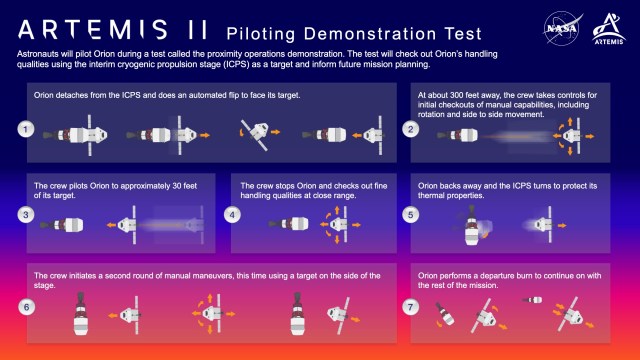
Key Test Drive of Orion on NASA’s Artemis II to Aid Future Missions

NASA Sees Progress on Blue Origin’s Orbital Reef Life Support System
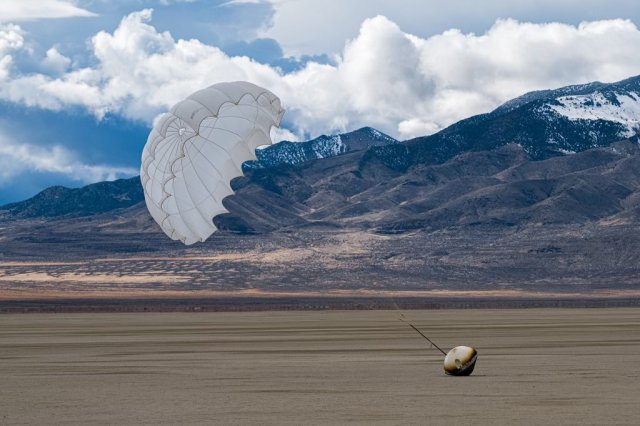
NASA Helps Emerging Space Companies ‘Take the Heat’

Climate Change Multimedia

Ask NASA Climate
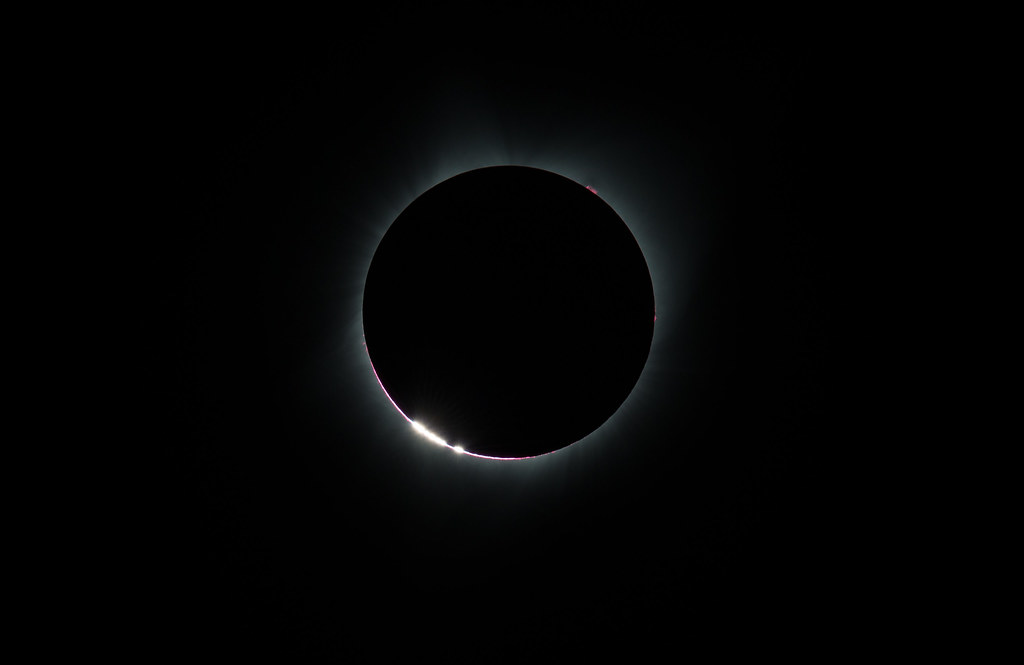
Sketch the Shape of the Sun for Science During the Solar Eclipse

Casey Honniball: Finding Her Space in Lunar Science

Hubble Views a Galaxy Under Pressure

Cheers! NASA’s Webb Finds Ethanol, Other Icy Ingredients for Worlds

Earth Science to Action
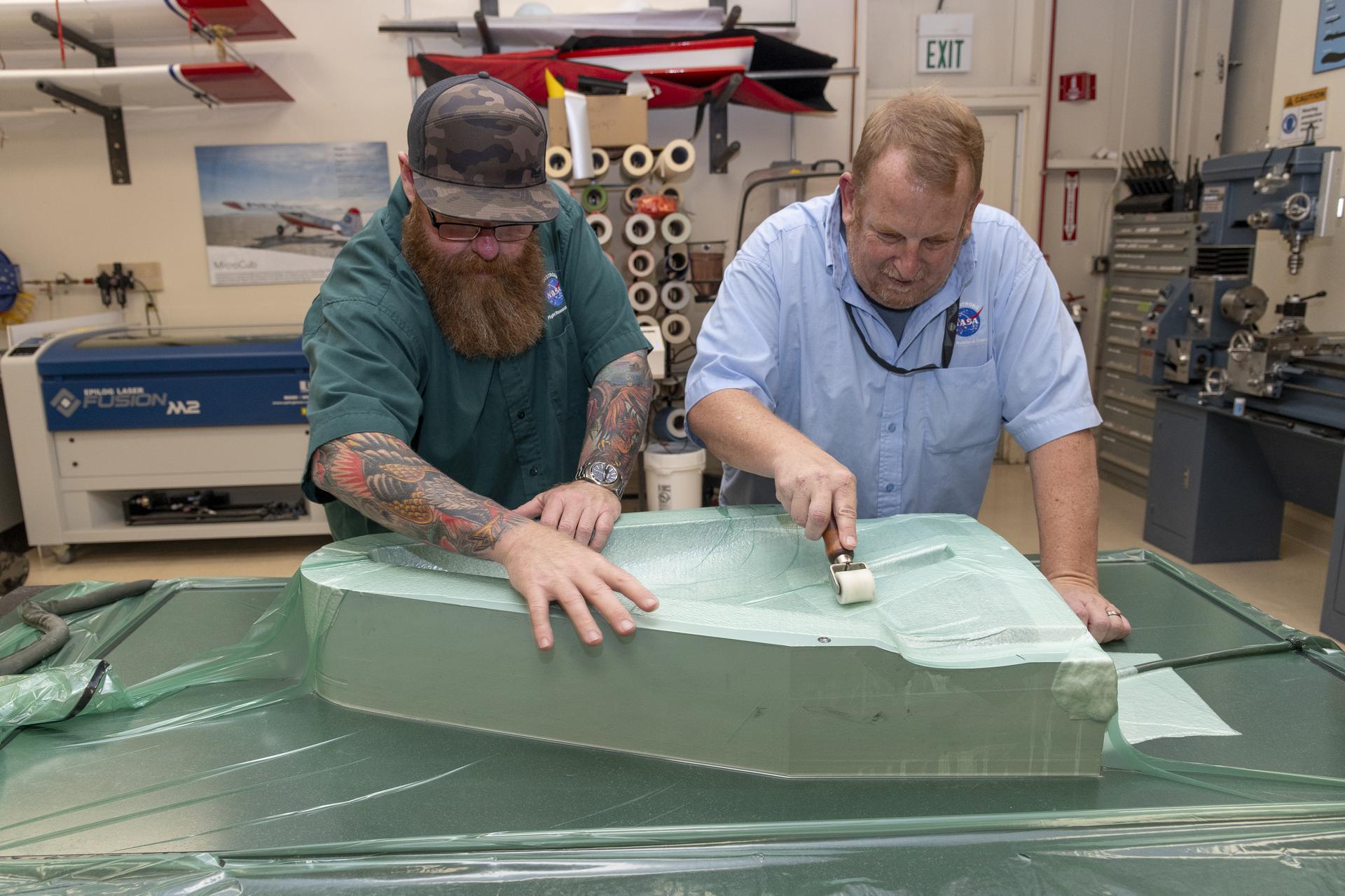
NASA Armstrong Updates 1960s Concept to Study Giant Planets

ARMD Solicitations

2024 Dream with Us Design Challenge

NASA, Industry Improve Lidars for Exploration, Science

NASA Announces Semifinalists of Power to Explore Challenge
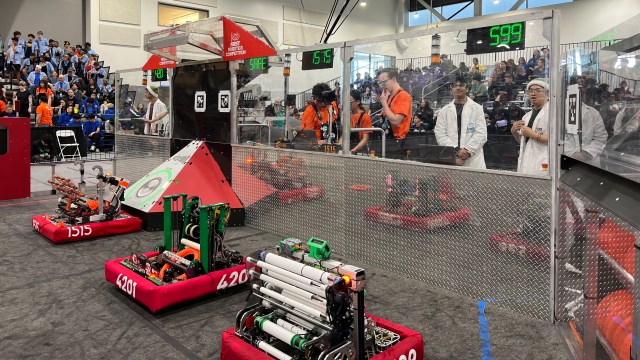
Student-Built Robots Clash at Competition Supported by NASA-JPL

NASA Challenge Invites Artemis Generation Coders to Johnson Space Center
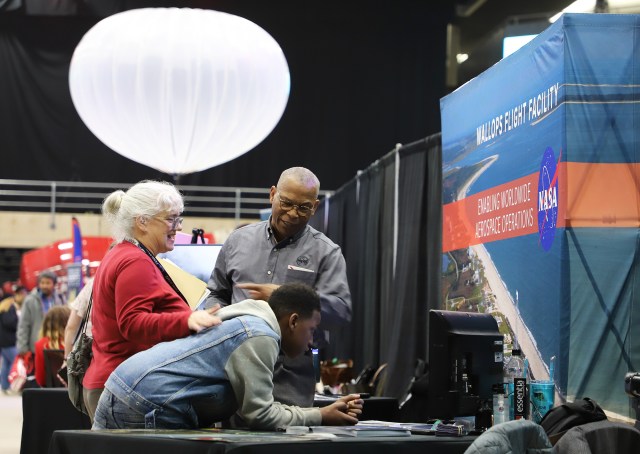
NASA Wallops Offers Career Inspiration to Delmarva Students

NASA Volunteers Find Fifteen Rare “Active Asteroids”

Astronauta de la NASA Marcos Berríos

Resultados científicos revolucionarios en la estación espacial de 2023
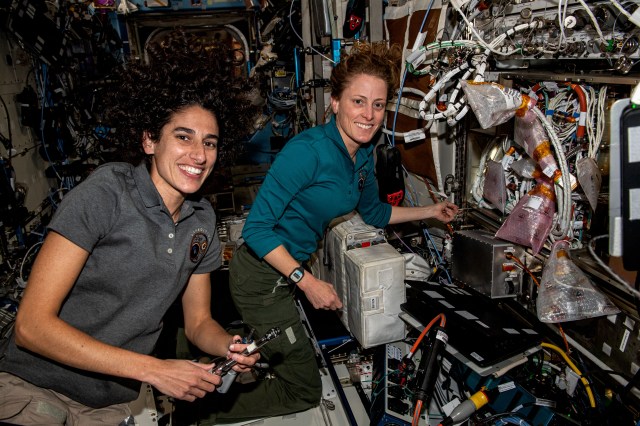
Logros de la NASA en la estación espacial en 2023
The marshall star for march 20, 2024.

Marshall Technologist Talks Solar Sail Technology in Rocket Center Exhibit
Robert champion named manager of sls exploration upper stage office at marshall, june malone named director of the office of center operations at marshall , nasa lights ‘beacon’ on moon with autonomous navigation system test, nasa artemis mission progresses with spacex starship test flight, evolved adapter for future nasa sls flights readied for testing, crew, cargo launches to space station scheduled for march 21, europa clipper mission highlighted on ‘this week at nasa’.
By Jessica Barnett
Space enthusiasts at the U.S. Space & Rocket Center were treated to a special exhibit featuring technologist Les Johnson of NASA’s Marshall Space Flight Center and a look at the future of solar sail technology.

Johnson shared the latest updates on the solar sail technology through brief presentations onstage in the Rocket Center’s atrium as well as one-on-one interactions with museum guests at the various displays set up near the stage. He discussed how the technology will work, showed a video of the solar sail team testing one of the sail’s four quadrants, and discussed what it could mean for the future of space exploration.
“I’m excited about this type of propulsion, because it’s free, it doesn’t run out of fuel, and you can use it to do amazing things in the future,” Johnson said. “We could build really big sails – 10 to 100 times bigger than the Solar Cruiser sail – and instead of using sunlight, we could shine lasers on it and go out in the solar system, literally where we’ve never been before.”
NASA continues to unfurl plans for solar sail technology as a promising method of deep space transportation. The agency cleared a key technology milestone in January with one of four identical solar sail quadrants successfully deploying. Together, the solar sail quadrants will make up the 17,800-square-foot sail.
Marshall leads the solar sail team, which includes Florida-based Redwire Corporation as prime contractor and Huntsville-based NeXolve as subcontractor.
Barnett, a Media Fusion employee, supports the Marshall Office of Communications.
› Back to Top
Robert Champion has been named as manager of the SLS (Space Launch System) Exploration Upper Stage Office at NASA’s Marshall Space Flight Center, effective March 24th.
In his role, he will be responsible for the continued development of the exploration upper stage on the more powerful SLS Block 1B rocket, which is set to debut for the Artemis IV mission. Marshall manages the SLS Program.

Champion has been director of the Office of Center Operations at Marshall since 2021. In that role, he managed center services that included industrial labor relations, environmental engineering, occupational health, facility management, logistics and transportation, protective services, emergency management, and subordinate site operations.
Champion previously served as the director of NASA’s Michoud Assembly Facility in New Orleans from 2019 to 2021; deputy director of Marshall’s Propulsion Systems Department from 2015 to 2019; deputy director of Marshall’s Space Systems Department from 2014 to 2015; and deputy director at Michoud from 2010 to 2014.
His 37-year career at NASA has included leadership roles in engineering, program and project organizations focused on launch vehicle development, system engineering, and propulsion systems.
Champion has received several of NASA’s highest awards, including the Presidential Rank Award, the Exceptional Achievement Medal, the Medal for Exceptional Service, Space Flight Awareness Honoree, Director’s Commendation, and the Contracting Officers Technical Representative of the Year. He was selected as an American Institute of Aeronautics and Astronautics Associate fellow and received the organization’s 2018-2019 Holger Toftoy Award for outstanding technical management in the fields of aeronautics and astronautics.
A native of Woodstock, Alabama, Champion holds a bachelor’s degree in aerospace engineering from Auburn University. He lives in Hazel Green with his wife, Maria Shelby. Combined, they have six adult children and six grandchildren.
June Malone has been named as director of the Office of Center Operations at NASA’s Marshall Space Flight Center, effective March 24.
With an annual budget of approximately $94 million, the organization includes 120 engineers and specialized civil servants and more than 500 contractors. Services provided by Center Operations include industrial labor relations, environmental engineering, occupational health, facility management, logistics and transportation, protective services, emergency management, and subordinate site operations.

Malone has been director of the Office of Strategic Analysis & Communications at Marshall since 2021. In that role, she led the organization in providing strategic planning, objective analysis, and comprehensive communication to support the policy, program, and budget decisions for the center.
Malone has worked in a variety of leadership roles throughout her 30-year NASA career. She previously was manager for Marshall’s Office of Communications from 2019 to 2021, overseeing the center’s full communications portfolio, including media, social media, website content, exhibits, history, and employee communications. Previously in 2019, she worked in Marshall’s Office of Human Capital, where she established a new Human Resources Business Partner organization and operating model. She also held a year-long position in 2016-2017 as deputy director of the Office of Strategic Analysis & Communications.
From 2014-2016 and again 2017-2019, Malone was manager of Marshall’s Office of Communication, guiding media and social media for all center projects, programs, and activities, including crisis and risk communication. She has managed public affairs and media relations activities for the Space Shuttle Propulsion Projects Office, the Space Launch Initiative, the Advanced Space Transportation Program, and the full suite of science and engineering work at Marshall. She was the primary NASA spokesperson for the Space Shuttle Propulsion Projects Office, communicating with media and the public on technical subjects and controversial issues that included the Columbia accident and Return to Flight.
Prior to joining NASA in 1991, Malone was an active-duty Air Force officer from 1985-1991. She worked at the Pentagon on the secretary of the Air Force staff in the Office of Public Affairs as a public affairs officer, and subsequently at Tactical Air Command at Langley Air Force Base in Hampton, Virginia, during Operation Desert Storm. She formulated and implemented public affairs and media relations policy, strategic public affairs activities, and media relations plans.
Malone holds a bachelor’s degree in communications from Southern Illinois University and a master’s degree in communications research from The Florida State University in Tallahassee. Her awards include a Silver Snoopy, NASA Outstanding Leadership Medal, Air Force Meritorious Service Medal, and Rotary National Award for Communication.
An Illinois native, Malone and her husband, Roy, reside in Huntsville. Their son, Wil, is a NASA engineer, and their daughter, Madison, is a medical doctor in San Francisco.
By Rick Smith
For 30 total minutes in February, NASA lit a beacon on the Moon – successfully testing a sophisticated positioning system that will make it safer for Artemis-era explorers to visit and establish a permanent human presence on the lunar surface.
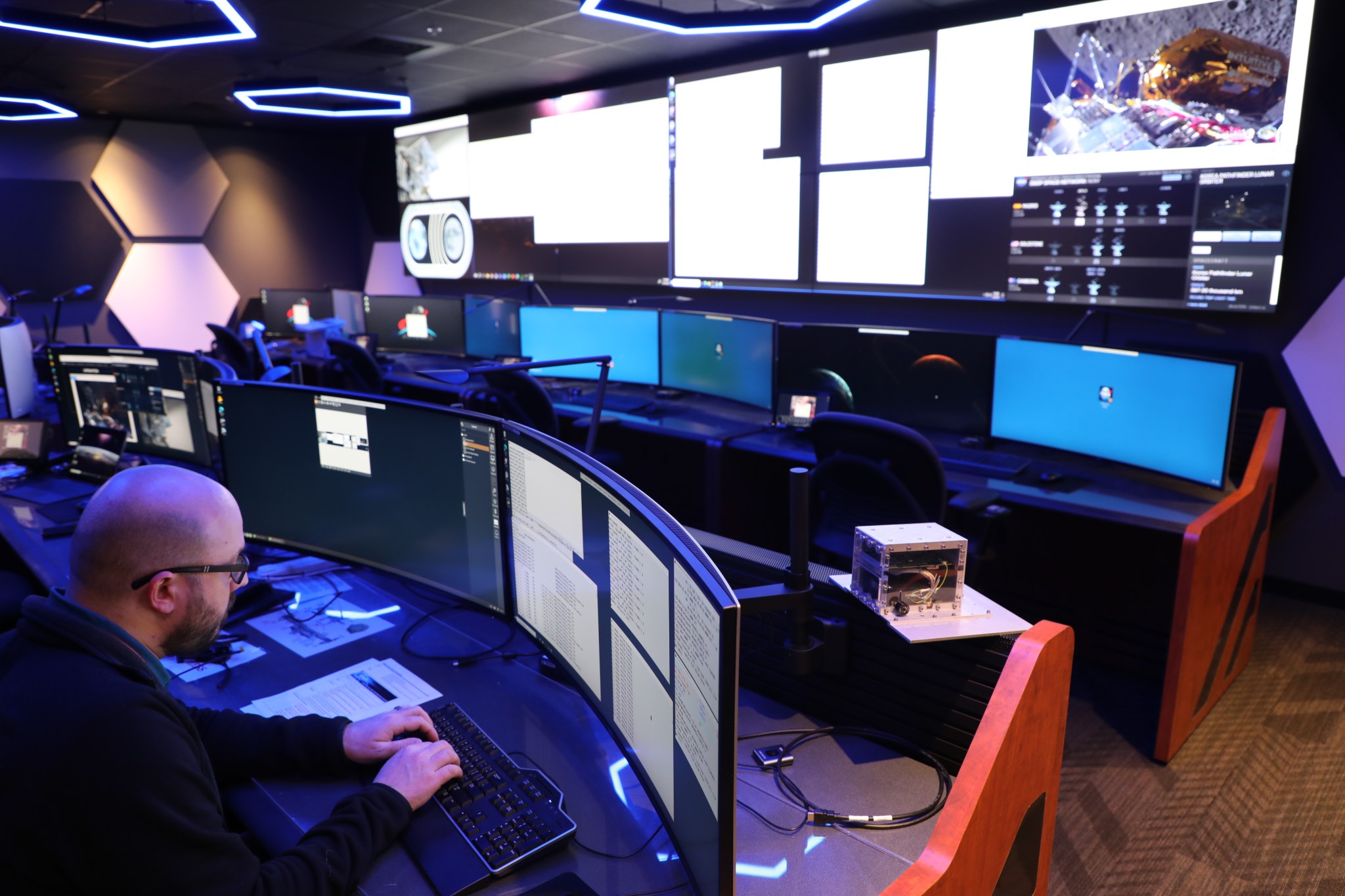
The Lunar Node 1 demonstrator, or LN-1, is an autonomous navigation system intended to provide a real-time, point-to-point communications network on the Moon. The system – tested during Intuitive Machines’ IM-1 mission as part of NASA’s CLPS ( Commercial Lunar Payload Services ) initiative – could link orbiters, landers, and even individual astronauts on the surface, digitally verifying each explorer’s position relative to other networked spacecraft, ground stations, or rovers on the move.
That system would be a marked improvement over conventional, Earth-based radio data relays, NASA researchers said – even more so compared to Apollo-era astronauts trying to “eyeball” distance and direction on the vast, mostly grey lunar surface.
“We’ve lit a temporary beacon on the lunar shore,” said Evan Anzalone, LN-1 principal investigator at NASA’s Marshall Space Flight Center . “Now, we seek to deliver a sustainable local network – a series of lighthouses that point the way for spacecraft and ground crews to safely, confidently spread out and explore.”
The experiment was launched Feb. 15 as a payload on the IM-1 mission. The Nova-C lander, named Odysseus, successfully touched down Feb. 22 near Malapert A, a lunar impact crater near the Moon’s South Pole region, executing the first American commercial uncrewed landing on the Moon. The lander spent its subsequent days on the surface conducting six science and technology demonstrations , among them LN-1, before it officially powered down on Feb. 29.
“This feat from Intuitive Machines, SpaceX, and NASA demonstrates the promise of American leadership in space and the power of commercial partnerships under NASA’s CLPS initiative,” NASA Administrator Bill Nelson said in a statement after the landing. “Further, this success opens the door for new voyages under Artemis to send astronauts to the Moon, then on to Mars.”
During IM-1’s translunar journey, the Marshall team conducted daily tests of the LN-1 beacon. The original plan was for the payload to transmit its beacon around the clock upon landing. NASA’s Deep Space Network , the international giant radio antenna array, would have received that signal for, on average, 10 hours daily.
Instead, due to the lander’s touchdown orientation, LN-1 conducted two 15-minute transmissions from the surface. DSN assets successfully locked on the signal, feeding telemetry, navigation measurements, and other data to researchers at Marshall, NASA’s Jet Propulsion Laboratory, and Morehead State University in Morehead, Kentucky. The team continues to evaluate the data.
LN-1 even provided critical backup to IM-1’s onboard navigation system, noted Dr. Susan Lederer, CLPS project scientist at NASA’s Johnson Space Center. The LN-1 team “really stepped up to the task,” she said, by relaying spacecraft positioning data during translunar flight to NASA’s Deep Space Network satellites at the Goldstone and Madrid Deep Space Communications Complexes in Fort Irwin, California, and Robledo de Chavela, Spain, respectively.
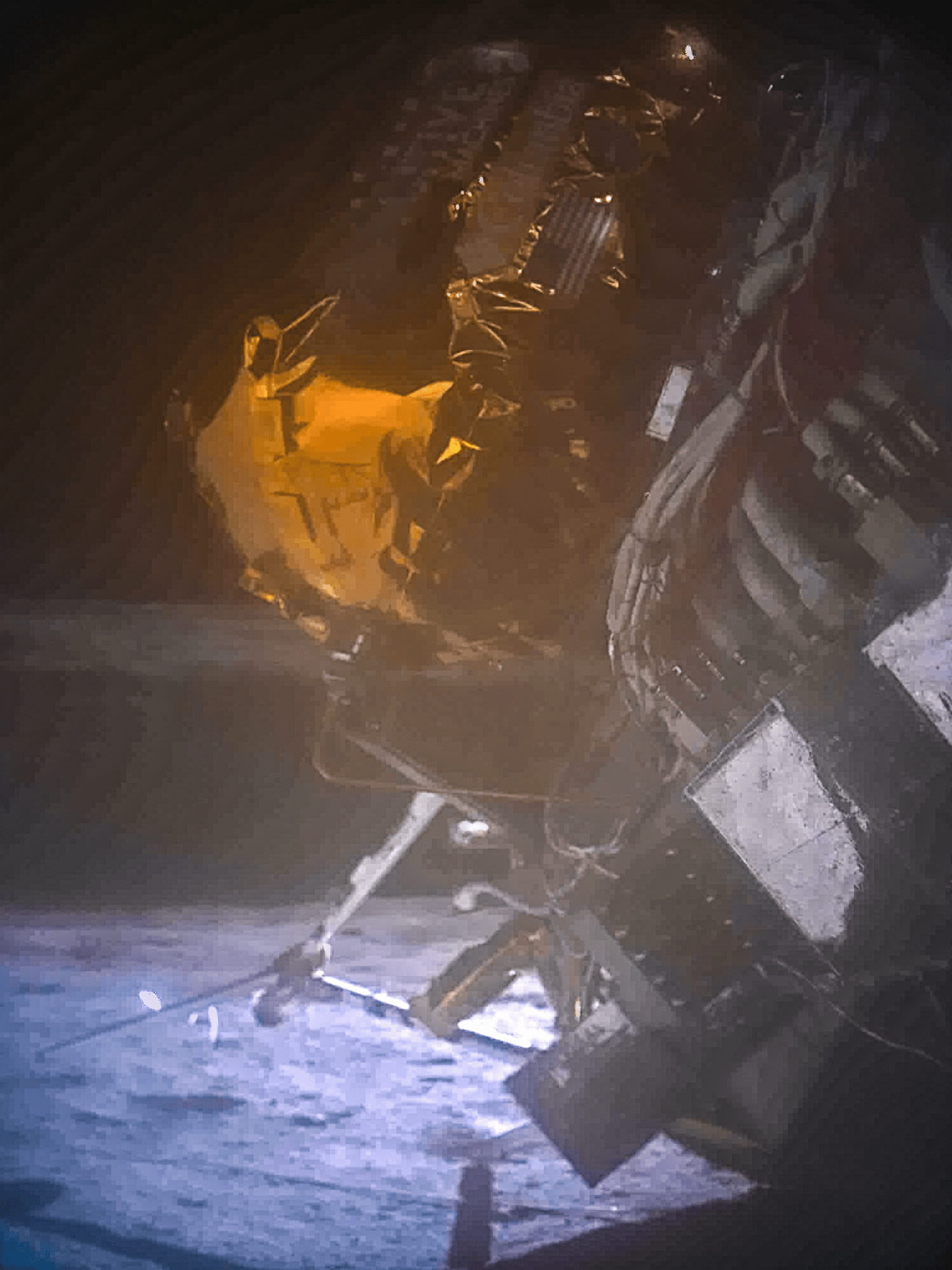
In time, navigation aids such as Lunar Node-1 could be used to augment navigation and communication relays and surface nodes, providing increased robustness and capability to a variety of users in orbit and on the surface.
As the lunar infrastructure expands, Anzalone envisions LN-1 evolving into something akin to a network that monitors and maintains a busy metropolitan subway system, tracking every “train” in real time, and operating as one part of a larger, LunaNet -compatible architecture, augmenting other NASA and international investments , including the Japanese Aerospace Exploration Agency’s Lunar Navigation Satellite System .
And the technology promises even greater value to NASA’s Moon to Mars efforts, he said. LN-1 may improve data delivery to lunar explorers by just a matter of seconds over conventional relays – but real-time navigation and positioning becomes much more vital on Mars, where transmission delays from Earth can take up to 20 minutes.
“That’s a very long time to wait for a spacecraft pilot making a precision orbital adjustment, or humans traversing uncharted Martian landscapes,” Anzalone said. “LN-1 can make lighthouse beacons of every explorer, vehicle, temporary or long-term camp, and site of interest we send to the Moon and to Mars.”
Marshall engineers designed, developed, integrated, and tested LN-1 as part of the NPLP ( NASA-Provided Lunar Payloads ) project funded by the agency’s Science Mission Directorate. Marshall also developed MAPS (Multi-spacecraft Autonomous Positioning System), the underlying networked computer navigation software. MAPS previously was tested on the International Space Station in 2018, using NASA’s Space Communications and Navigations (SCaN) Testbed .
NASA’s CLPS initiative oversees industry development, testing, and launch of small robotic landers and rovers supporting NASA’s Artemis campaign . Learn more here .
Smith, an Aeyon/MTS employee, supports the Marshall Office of Communications.
As part of NASA’s Artemis campaign to return humans to the Moon for the benefit of all, the agency is working with SpaceX to develop the company’s Starship human landing system (HLS), which will land astronauts near the Moon’s South Pole during the Artemis III and Artemis IV missions. On March 14, SpaceX launched the third integrated flight test of its Super Heavy booster and Starship upper stage, an important milestone toward providing NASA with a Starship HLS for its Artemis missions.

A complement of 33 Raptor engines, fueled by super-cooled liquid methane and liquid oxygen, powered the Super Heavy booster with Starship stacked on top, from the company’s Starbase orbital launch pad at 8:25 a.m. CDT. Starship, using six Raptor engines, separated from the Super Heavy booster employing a hot-staging technique to fire the engines before separation at approximately three minutes into the flight, in accordance with the flight plan. This was the third flight test of the integrated Super Heavy-Starship system.
“With each flight test, SpaceX attempts increasingly ambitious objectives for Starship to learn as much as possible for future mission systems development. The ability to test key systems and processes in flight scenarios like these integrated tests allows both NASA and SpaceX to gather crucial data needed for the continued development of Starship HLS,” said Lisa Watson-Morgan, HLS Program Manager at NASA’s Marshall Space Flight Center.
This test accomplished several important firsts that will contribute to the development of Starship for Artemis lunar landing missions. The spacecraft reached its expected orbit and Starship completed the full-duration ascent burn.
One objective closely tied to future Artemis operations is the transfer of thousands of pounds of cryogenic propellant between internal tanks during the spacecraft’s coast phase as part of NASA’s Space Technology Missions Directorate 2020 Tipping Point awards . The propellant transfer demonstration operations were completed, and the NASA-SpaceX team is currently reviewing the flight data that was received. This Tipping Point technology demonstration is one of more than 20 development activities NASA is undertaking to solve the challenges of using cryogenic fluids during future missions.
As a key step toward understanding how super-cooled propellant sloshes within the tanks when the engines shut down, and how that movement affects Starship’s stability while in orbit, engineers will study flight test data to assess the performance of thrusters that control Starship’s orientation in space. They are also interested to learn more about how the fluid’s movement within the tanks can be settled to maximize propellant transfer efficiency and ensure Raptor engines receive needed propellant conditions to support restart in orbit.
“Storing and transferring cryogenic propellant in orbit has never been attempted on this scale before,” said Jeremy Kenny, project manager, NASA’s Cryogenic Fluid Management Portfolio at Marshall. “But this is a game-changing technology that must be developed and matured for science and exploration missions at the Moon, Mars, and those that will venture even deeper into our solar system.”
Under NASA’s Artemis campaign, the agency will land the first woman, first person of color, and its first international partner astronaut on the lunar surface and prepare for human expeditions to Mars. Commercial human landing systems are critical to deep space exploration, along with the Space Launch System rocket, Orion spacecraft, advanced spacesuits and rovers, exploration ground systems, and the Gateway space station.
Read more about NASA’s Human Landing System.
A test article of the universal stage adapter for NASA’s more powerful version of its SLS (Space Launch System) rocket arrived to Building 4619 at NASA’s Marshall Space Flight Center on Feb. 22 from Leidos in Decatur, Alabama.
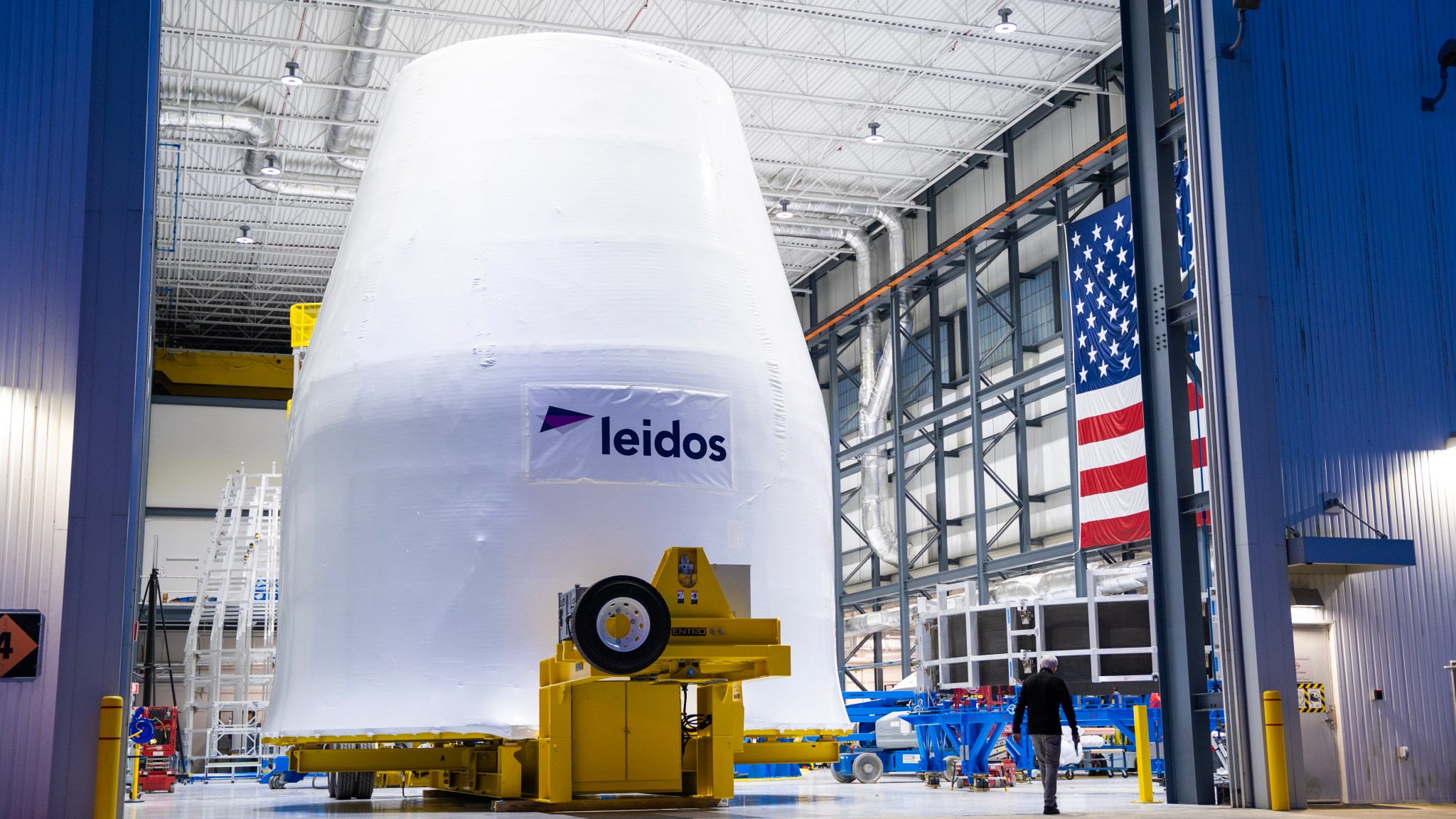
The universal stage adapter will connect the rocket’s upgraded in-space propulsion stage, called the exploration upper stage, to NASA’s Orion spacecraft as part of the evolved Block 1B configuration of the SLS rocket. It will also serve as a compartment capable of accommodating large payloads, such as modules or other exploration spacecraft. The SLS Block 1B variant will debut on Artemis IV and will increase SLS’s payload capability to send more than 84,000 pounds to the Moon in a single launch.
In Building 4619’s Load Test Annex High Bay at Marshall , the development test article will first undergo modal testing that will shake the hardware to validate dynamic models. Later, during ultimate load testing, force will be applied vertically and to the sides of the hardware. Unlike the flight hardware, the development test article has flaws intentionally included in its design, which will help engineers verify that the adapter can withstand the extreme forces it will face during launch and flight.
The test article joins an already-rich history of rocket hardware that has undergone high-and-low pressure, acoustic, and extreme temperature testing in the multipurpose, high-bay test facility; it will be tested in the same location that once bent, compressed, and torqued the core stage intertank test article for SLS rocket’s Block 1 configuration. Leidos, the prime contractor for the universal stage adapter, manufactured the full-scale prototype at its Aerospace Structures Complex in Decatur.
NASA is working to land the first woman, first person of color, and its first international partner astronaut on the Moon under Artemis. SLS is part of NASA’s backbone for deep space exploration, along with the Orion spacecraft and Gateway in orbit around the Moon and commercial human landing systems, next-generational spacesuits, and rovers on the lunar surface. SLS is the only rocket that can send Orion, astronauts, and supplies to the Moon in a single launch.
Marshall manages the SLS and human landing system programs.
When NASA’s DART (Double Asteroid Redirection Test) deliberately smashed into a 560-foot-wide asteroid on Sept. 26, 2022, it made its mark in more ways than one. The demonstration showed that a kinetic impactor could deflect a hazardous asteroid should one ever be on a collision course with Earth. Now a new study published in the Planetary Science Journal shows the impact changed not only the motion of the asteroid, but also its shape.

DART’s target, the asteroid Dimorphos, orbits a larger near-Earth asteroid called Didymos. Before the impact, Dimorphos had a roughly symmetrical “oblate spheroid” shape – like a squashed ball that is wider than it is tall. With a well-defined, circular orbit at a distance of about 3,900 feet from Didymos, Dimorphos took 11 hours and 55 minutes to complete one loop around Didymos.
“When DART made impact, things got very interesting,” said Shantanu Naidu, a navigation engineer at NASA’s Jet Propulsion Laboratory in Southern California, who led the study. “Dimorphos’ orbit is no longer circular: Its orbital period” – the time it takes to complete a single orbit – “is now 33 minutes and 15 seconds shorter. And the entire shape of the asteroid has changed, from a relatively symmetrical object to a ‘triaxial ellipsoid’ – something more like an oblong watermelon.”
Naidu’s team used three data sources in their computer models to deduce what had happened to the asteroid after impact. The first source was aboard DART: The spacecraft captured images as it approached the asteroid and sent them back to Earth via NASA’s Deep Space Network ( DSN ). These images provided close-up measurements of the gap between Didymos and Dimorphos while also gauging the dimensions of both asteroids just prior to impact.
The second data source was the DSN’s Goldstone Solar System Radar, located near Barstow, California, which bounced radio waves off both asteroids to precisely measure the position and velocity of Dimorphos relative to Didymos after impact. Radar observations quickly helped NASA conclude that DART’s effect on the asteroid greatly exceeded the minimum expectations.
The third and most significant source of data: ground telescopes around the world that measured both asteroids’ “light curve,” or how the sunlight reflecting off the asteroids’ surfaces changed over time. By comparing the light curves before and after impact, the researchers could learn how DART altered Dimorphos’ motion.
As Dimorphos orbits, it periodically passes in front of and then behind Didymos. In these so-called “mutual events,” one asteroid can cast a shadow on the other, or block our view from Earth. In either case, a temporary dimming – a dip in the light curve – will be recorded by telescopes.
See the DART impact with NASA’s Eyes on the Solar System .
“We used the timing of this precise series of light-curve dips to deduce the shape of the orbit, and because our models were so sensitive, we could also figure out the shape of the asteroid,” said Steve Chesley, a senior research scientist at JPL and study co-author. The team found Dimorphos’ orbit is now slightly elongated, or eccentric. “Before impact,” Chesley continued, “the times of the events occurred regularly, showing a circular orbit. After impact, there were very slight timing differences, showing something was askew. We never expected to get this kind of accuracy.”
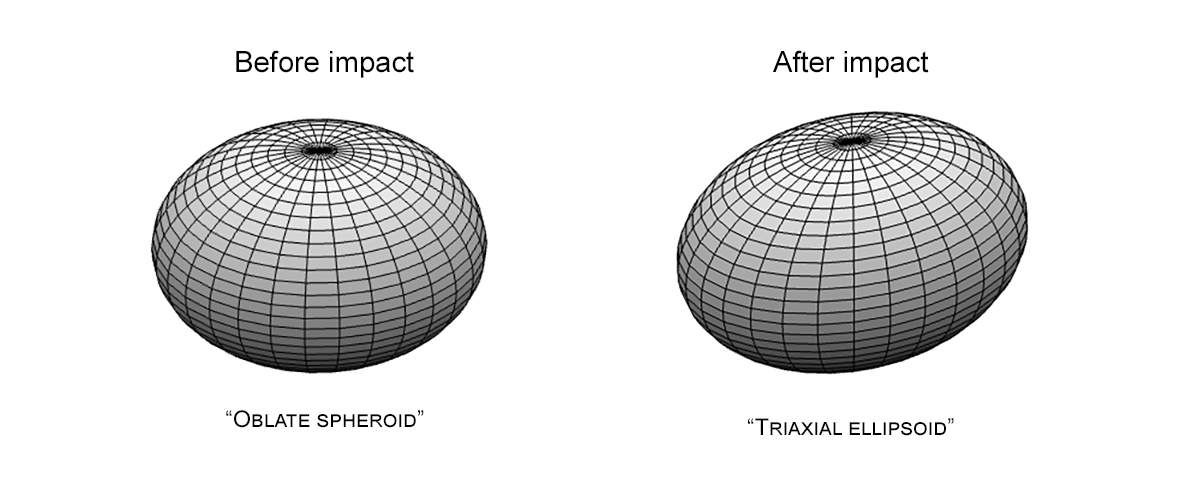
The models are so precise, they even show that Dimorphos rocks back and forth as it orbits Didymos, Naidu said.
The team’s models also calculated how Dimorphos’ orbital period evolved. Immediately after impact, DART reduced the average distance between the two asteroids, shortening Dimorphos’ orbital period by 32 minutes and 42 seconds, to 11 hours, 22 minutes, and 37 seconds.
Over the following weeks, the asteroid’s orbital period continued to shorten as Dimorphos lost more rocky material to space, finally settling at 11 hours, 22 minutes, and 3 seconds per orbit – 33 minutes and 15 seconds less time than before impact. This calculation is accurate to within 1 ½ seconds, Naidu said. Dimorphos now has a mean orbital distance from Didymos of about 3,780 feet – about 120 feet closer than before impact.
“The results of this study agree with others that are being published,” said Tom Statler, lead scientist for solar system small bodies at NASA Headquarters. “Seeing separate groups analyze the data and independently come to the same conclusions is a hallmark of a solid scientific result. DART is not only showing us the pathway to an asteroid-deflection technology, it’s revealing new fundamental understanding of what asteroids are and how they behave.”
These results and observations of the debris left after impact indicate that Dimorphos is a loosely packed “rubble pile” object, similar to asteroid Bennu . ESA’s (European Space Agency) Hera mission, planned to launch in October 2024, will travel to the asteroid pair to carry out a detailed survey and confirm how DART reshaped Dimorphos.
DART was designed, built, and operated by the Johns Hopkins Applied Physics Laboratory (APL) in Laurel, Maryland, for NASA’s Planetary Defense Coordination Office, which oversees the agency’s ongoing efforts in planetary defense. The mission is a project of the agency’s Planetary Mission Program Office , which is at NASA’s Marshall Space Flight Center. DART was humanity’s first mission to intentionally move a celestial object.
JPL, a division of Caltech in Pasadena, California, manages the DSN for NASA’s Space Communications and Navigation (SCaN) program within the Space Operations Mission Directorate at the agency’s headquarters.
Equipment installs, health investigations, and training occupied the schedule aboard the International Space Station on March 19 as the seven orbital residents near the arrival of three crew members and a cargo delivery.

NASA’s SpaceX 30th commercial resupply mission to the station is scheduled for launch at 3:55 p.m. CDT March 21 from Space Launch Complex 40 in Florida. The Dragon cargo craft will deliver food, supplies, and new science investigations to the crew, including a set of sensors for the free-flying Astrobee robots and a new botany experiment to examine how two types of grass capture carbon dioxide from the atmosphere. Dragon will autonomously dock to the zenith port of the Harmony module at 6:30 a.m. March 23.
Ahead of Dragon’s liftoff, three crew members – NASA astronaut Tracy Dyson, cosmonaut Oleg Novitsky, and Flight Engineer Marina Vasilevskaya of Belarus – will launch from the Baikonur Cosmodrome in Kazakhstan at 8:21 a.m. March 21. The international crew will take a short ride to the station, docking only a few hours later at 11:39 p.m., before opening the hatch and joining the Expedition 70 crew in microgravity. Dyson will begin a six-month microgravity research mission once aboard, while Novitsky and Vasilevskaya will spend 12 days on station before departing back to Earth with NASA astronaut Loral O’Hara.
NASA TV will cover both launches beginning at 7:20 a.m. and 3:35 p.m. respectively.
Aboard station, the crew returned to work March 19 following a few days off-duty. Throughout the day, O’Hara and two of her NASA crewmates, Michael Barratt and Matthew Dominick, completed a round of SpaceX Dragon rendezvous training ahead of Dragon’s cargo arrival.
The HOSC (Huntsville Operations Support Center) at NASA’s Marshall Space Flight Center provides engineering and mission operations support for the space station, the Commercial Crew Program, and Artemis missions, as well as science and technology demonstration missions. The Payload Operations Integration Center within the HOSC operates, plans, and coordinates the science experiments onboard the space station 365 days a year, 24 hours a day.
Technicians at NASA’s Kennedy Space Center recently fully extended the first of two five-panel solar arrays for the agency’s Europa Clipper spacecraft. The mission is featured in “This Week @ NASA,” a weekly video program broadcast on NASA-TV and posted online.
The 46.5-foot arrays also will be inspected and cleaned as part of assembly, test, and launch operations. Targeted for launch in October 2024, the mission will study Jupiter’s moon Europa, which is believed to have a global ocean beneath its icy crust that has more water than all of Earth’s oceans combined.
Managed by Caltech in Pasadena, California, JPL leads the development of the Europa Clipper mission in partnership with the Johns Hopkins Applied Physics Laboratory (APL) in Laurel, Maryland, for NASA’s Science Mission Directorate. APL designed the main spacecraft body in collaboration with JPL and NASA’s Goddard Space Flight Center. The Planetary Missions Program Office at NASA’s Marshall Space Flight Center executes program management of the Europa Clipper mission.
View this and previous episodes at “This Week @NASA” on NASA’s YouTube page.
The little (electric) engine that could: The Port of San Diego unveils the nation’s first all-electric tug boat
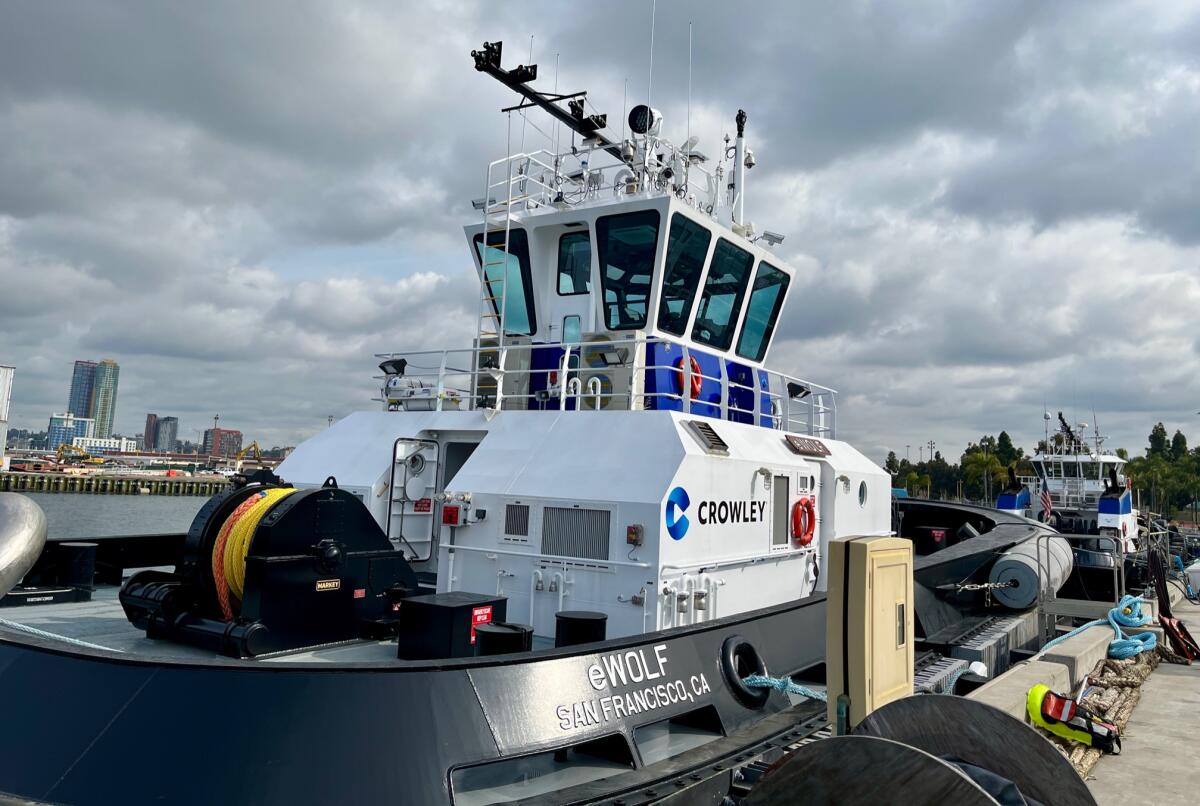
The 82-foot eWolf expects to eliminate 3,100 metric tons of carbon dioxide
- Show more sharing options
- Copy Link URL Copied!
The nation’s first all-electric tug boat has docked at the Port of San Diego and expects to begin emissions-free operations in about a month.
Operated by Crowley Maritime Corporation , the 82-foot eWolf will escort ships entering and leaving the Tenth Avenue Marine Terminal using electric power instead of diesel fuel, helping slash greenhouse gas emissions at the port and its neighbors in Barrio Logan and National City.
For the record:
1:58 p.m. March 13, 2024 This story has been updated to show the correct amount of government funding that went to the project.
“This is a big deal,” said port chairman Frank Urtasun at a news conference Monday. “This is new technology.”
Capable of speeds of up to 12 knots, the eWolf is powered by a 6.2 megawatt-hour main propulsion battery and two electric drives. The tug has thrust — also known as bollard pull in the parlance of the shipping industry — of 76.8 short tons, which is more powerful than the diesel-powered counterparts at the port.
Constructed in Alabama, the eWolf is equipped with two small generators for emergency use that allow the boat to travel longer distances at a reduced speed.
“Like an electric car, you step on the gas and it jumps,” said Paul Manzi, vice president of Crowley Shipping, based in Jacksonville, Fla. “All of the attributes that you have with an electric motor operation in a car or in an electric truck, you see here in the (eWolf) at massive scale. And it’s extremely quiet so when it pulls away from the dock you literally won’t hear any noise.”
The tug boat’s electricity will come from a charging station that is part of a microgrid facility equipped with two energy storage containers. Battery modules in each container have storage capacity of nearly 1.5 megawatt-hours.
Interconnected with the help of San Diego Gas & Electric, the charging station at the port is designed to allow the vessel to recharge quickly and reduce peak loads on the electric grid.
Operators plan to charge the eWolf overnight so it can perform its chores during daytime hours.
“This technology has individually been around for a while, but it hasn’t necessarily been integrated and optimized to all work together — and that’s kind of our role,” said Bruce Strupp, vice president at ABB Marine & Ports , the company that designed the boat’s propulsion system. “Some of the technology is our technology, some of it’s third-party technology, but we integrate it all together.”
The electric tug boat is expected to begin commercial operations at the port in mid- to late-April, depending on the completion of the charging station.

Officials at Crowley did not release the eWolf’s price tag Monday, saying only that it cost about twice as much as a conventional diesel-powered tug boat of comparable size.
But, Manzi said, the company expects the eWolf’s maintenance and operating costs will be “dramatically lower” than what’s spent on a diesel-powered tug boat because the electric model has fewer moving parts.
The entire project — the vessel as well as the charging station — received four grants that added up to $13.67 million, with two grants of $10.9 million from the San Diego Air Pollution Control District, one grant of just over $2 million from the U.S. Environmental Protection Agency and $750,000 from the federal government’s Maritime Administration.
In 2020, Gov. Gavin Newsom signed an executive order that directed state agencies to transition off-road vehicles — including tug boats — and equipment to 100 percent zero emissions by 2035.
By replacing one of the port’s diesel-powered tugs, the eWolf is expected to eliminate the consumption of about 35,000 gallons of diesel fuel per year. In its first 10 years of use, the electric tug boat is expected to reduce about 3,100 metric tons of carbon dioxide from the port and its surrounding areas such as Barrio Logan and National City.
“We’re trying to be good neighbors and trying to be able to help to reduce emissions here to help the electrification movement,” Urtasun said, adding that the port has spent about $130 million on various electrification projects.
Last year, the Port of San Diego became the first in North America to install a pair of all-electric cranes to load and off-load heavy cargo. Each 262 feet high, the cranes replaced an older crane that ran on diesel fuel. Together, the cranes expect to help the port reduce greenhouse gas emissions by 47 metric tons per year.
Get U-T Business in your inbox on Mondays
Get ready for your week with the week’s top business stories from San Diego and California, in your inbox Monday mornings.
You may occasionally receive promotional content from the San Diego Union-Tribune.

More from this Author
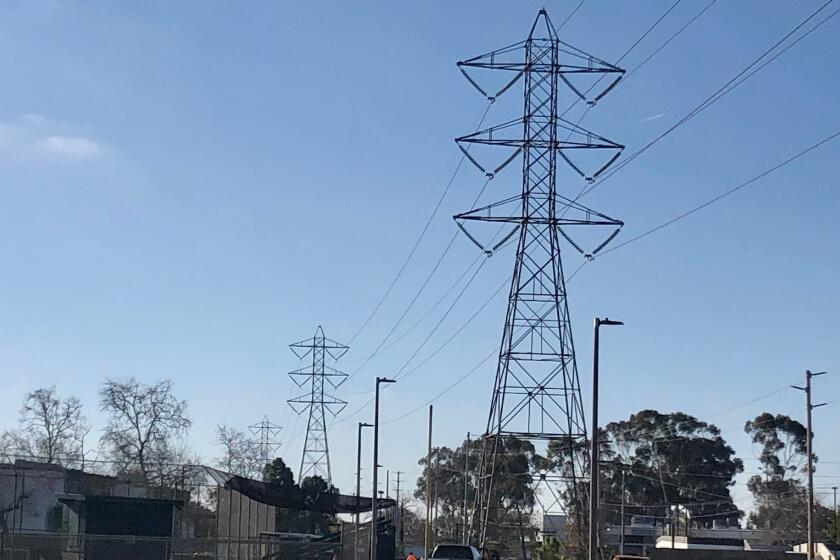
If the city of San Diego ran its own municipal utility instead of using SDG&E, how much would it cost?
March 15, 2024
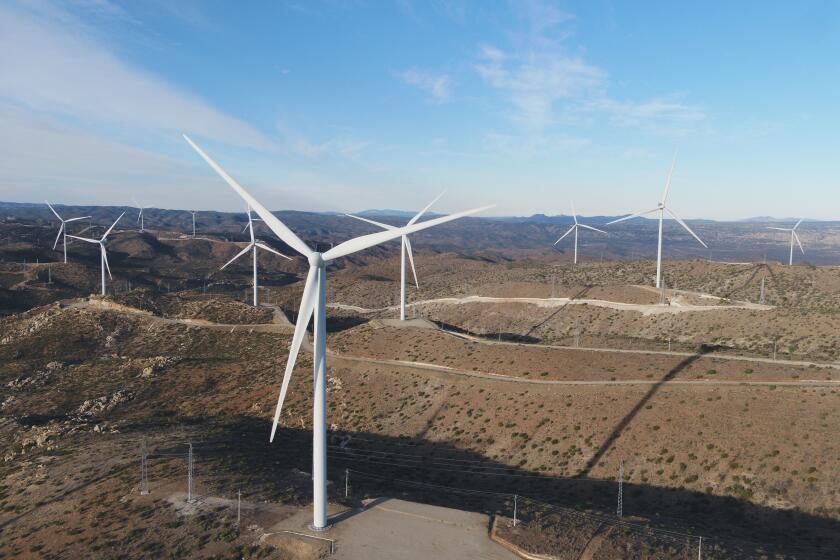
Blowin’ south of the border: Sempra subsidiary will build a new wind farm in Mexico

San Diego EV charging company completes $1 million deal with the U.K.’s defense ministry
March 12, 2024
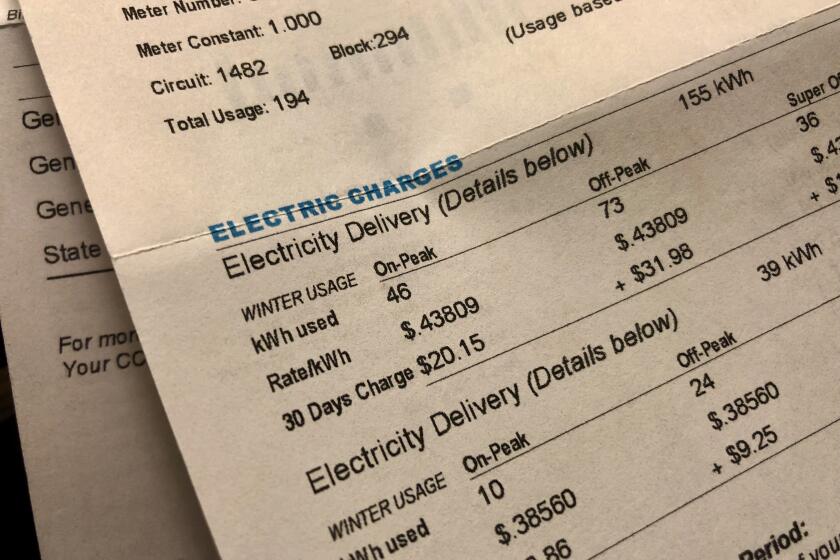
Here’s how many San Diego customers are behind on their utility bills
March 10, 2024

Biden hits the pause button on new LNG projects. It may cloud expansion plans at a Sempra project in Texas
Feb. 29, 2024

SDG&E profits hit a record $936 million
Feb. 27, 2024
More in this section
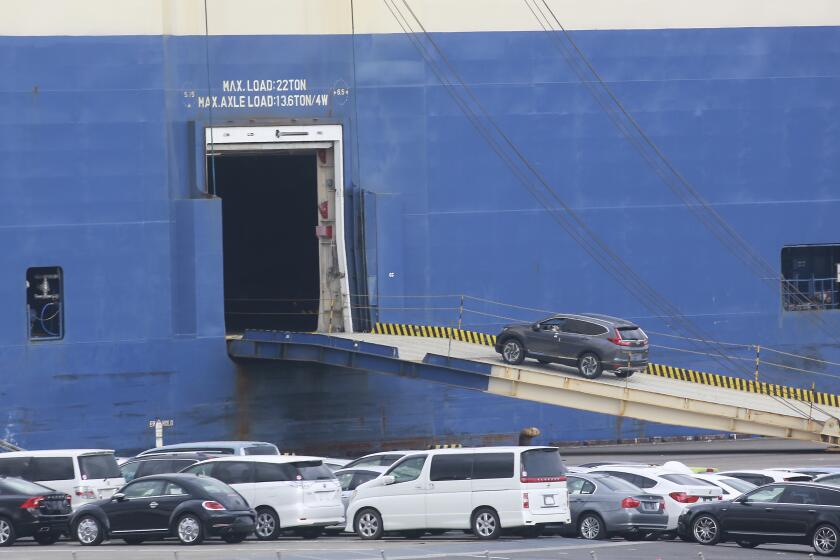
National Business
Japan’s exports grow for a third month as trade deficit sinks to $2.5 billion
Japan’s exports have risen 7.8% in February, as shipments continued to expand in cars and electrical machinery

New Zealand slips into its second recession in 18 months as economy contracts
New Zealand has entered its second recession in 18 months after the latest round of GDP figures confirmed its economy contracted in the last quarter of 2023
Brother of airport director shot by ATF agents speaks out about shooting
The brother of the Little Rock airport executive shot by federal agents serving a search warrant says he fears his brother may not survive

A new airline for San Diego is bringing five nonstop flights in time for summer travel
Low-cost carrier Breeze Airways is making its debut at the San Diego International Airport in April and May. It’s also offering a discounted fare promotion of up to 34 percent off.
Grains mixed, Livestock lower
Wheat for May was down 7.50 cents at $5.45 a bushel; May corn fell .50 cent at $4.39 a bushel, May oats fell 3.25 cents at $3.5325 a bushel; while May soybeans rose 24 cents at $12.0950 a bushel.
March 20, 2024

Virginia House leaders dispute governor’s claim that their consultant heaped praise on arena deal
Top legislators in the Virginia House of Delegates are disputing Republican Gov. Glenn Youngkin’s claim that an independent consultant gave the thumbs-up to his proposal to lure two sports teams to the state
Watch NASA unfurl basketball-court-sized solar sail for deep space propulsion (video)
"We've met our goal and demonstrated that we're ready to be flown."
NASA has reached a significant technological milestone with progress on an experimental form of spacecraft propulsion which utilizes solar radiation.
The space agency successfully deployed one of four identical quadrants of a huge solar sail at Redwire Space's facility in Longmont, Colorado on Jan. 30. The demonstration was a big step towards some day using the technology in space and, farther in the future, utilizing the concept for deep space transportation.
"This was a major last step on the ground before it's ready to be proposed for space missions," NASA technologist Les Johnson said in a statement . "What's next is for scientists to propose the use of solar sails in their missions. We've met our goal and demonstrated that we're ready to be flown."
Related: Solar-sailing probes may soon get their moment in the sun
In the same way a sailboat uses the wind to propel itself, the solar sail harnesses and reflects sunlight to generate propulsion. Particles of light, known as photons, have no mass, yet when they bounce off of a reflective surface such as the foil-like material of a solar sail, they impart some of their momentum onto it. In the vacuum of space, and with enough photons, a large amount of energy can be transferred to a solar sail over time.
When used within a solar system in which solar radiation is abundant, a solar sail can continue absorbing this momentum to accelerate as long as light reflects off of it. This means craft propelled by solar sails can reach very high speeds, much faster than a chemical rocket — at least in theory.
The major advantages of solar sails are that they do not require fuel and are very light. This makes the technology suitable for low-mass missions in novel orbits. These include orbits for studying space weather and its effects on the Earth, or for advanced studies of the north and south poles of the sun, according to NASA.
Get the Space.com Newsletter
Breaking space news, the latest updates on rocket launches, skywatching events and more!
The sail will measure 17,780 square feet (1652 sq. meters) when fully deployed. It is made of a polymer material coated with aluminum with a thickness of 2.5 microns, or less than the width of a human hair.
Solar sails have gathered momentum in recent years. The first solar sail to successfully fly was the Japanese Space Exploration Agency's Interplanetary Kite-craft Accelerated by Radiation Of the Sun ( IKAROS ) spacecraft in 2010. Later missions have included NASA's NanoSail-D and the Planetary Society's Lightsail 1 and Lightsail 2 missions.
The tech could soon be propelling low-cost, long-duration space missions and even help accelerate missions beyond the solar system . NASA's Johnson added that lasers could even be used to accelerate the solar sails to high speeds.
"In the future, we might place big lasers in space that shine their beams on the sails as they depart the solar system, accelerating them to higher and higher speeds, until eventually they are going fast enough to reach another star in a reasonable amount of time," Johnson said in the statement.
— What Is a Solar Sail?
— Researchers unlock the keys to designing an interstellar sail
— LightSail 2 spacecraft ends its solar-sailing mission in a blaze of glory
NASA's Science Mission Directorate funded Redwire's solar sail technology to reach a new technology readiness level, or TRL 6, which means it's ready for proposals to be flown on space missions. The 1-9 TRL scale represents the stage of development of a technology, with TRL 9 meaning the system has proven through successful mission operations and is considered fully mature and operational.
The project is led by NASA's Marshall Space Flight Center in Huntsville, Alabama. Prime contractor Redwire developed the deployment mechanisms and booms, with subcontractor NeXolve of Huntsville providing the sail membrane. Marshall developed the algorithms for controlling and navigating with the sail when it flies in space.
Join our Space Forums to keep talking space on the latest missions, night sky and more! And if you have a news tip, correction or comment, let us know at: [email protected].

Andrew is a freelance space journalist with a focus on reporting on China's rapidly growing space sector. He began writing for Space.com in 2019 and writes for SpaceNews, IEEE Spectrum, National Geographic, Sky & Telescope, New Scientist and others. Andrew first caught the space bug when, as a youngster, he saw Voyager images of other worlds in our solar system for the first time. Away from space, Andrew enjoys trail running in the forests of Finland. You can follow him on Twitter @AJ_FI .
Deep-space astronomy sensor peers into the heart of an atom
Private Varda Space capsule returns to Earth with space-grown antiviral drug aboard
Citizen scientists and AI take a cosmic cruise to discover 430,000 new galaxies
- Cisventure Astronot I can't wait for a spacecraft to pull an Opportunity, and operate long after its initial mission. Let's just hope it doesn't also pull an OSIRIS-APEX, and rename itself every time it gets a new objective. Reply
- Atlan0001 Probably not, but I wonder if the UFO disks we keep seeing pictures of house titanic (for the size of the disks) unfolding and folding cosmic energy sails to power drives of constant acceleration/decelerations in the space of the universe? Even balloon-shaped surface sails ("surround-sound" and then superconduct energy, so to speak) if not strictly sun facing energy sails? Whatever? Reply
- iMaxPlanck Increasing speed of space travel, okay, but "reach another star in a reasonable amount of time"? Like hundreds or thousands of years reasonable? Reply
iMaxPlanck said: Increasing speed of space travel, okay, but "reach another star in a reasonable amount of time"? Like hundreds or thousands of years reasonable?
Atlan0001 said: ...cosmic energy sails to power drives of constant acceleration/decelerations in the space of the universe?
- Classical Motion I hate to be so contrary but I don't think a solar sail will work. Yes they can put one up there and measure some momentum and gain some acceleration. But the power source for this device decreases at an inverse square rate with distance. Not practical for any outward travel. Imagine the size of the sail needed at Neptune to have the same momentum we would get here. Light is not a free ride. It fades too quickly. I was under the impression that cosmic rays were more or less omni-directional. Or at least what net direction it had would be sparse. Much less than the stated number. And from what I've heard what directional flux there is temporary. The net cosmic flux could be like the wind. One would need to detect the cosmic flow currents for navigation. The solar wind might work if we could harvest it's momentum. The depictions of it show a net stream of it that might be tacked. This flux also has some dispersion to it, but unlike light, this flux is accelerating. The flux is sparse at Neptune but has much higher velocity. With an efficient harvesting method or converter or collector...this would help counter the inverse square loss for a more practical form of solar travel. But it's in the future. For future tech. Understanding why the solar wind accelerates for so long might really help space travel. It's so anti-gravity. Reply
- billslugg Yes, solar sails are possible but there are lots of problems. In order to get a good enough push from the Sun, one must start very close to it. And, yes, galacitc cosmic rays are omnidirectional, they would need to be absorbed, converted into another form of energy, aimed out the back. Solar cosmic rays come from one direction, but why use them when you have sunlight? Reply
billslugg said: Yes, solar sails are possible but there are lots of problems. In order to get a good enough push from the Sun, one must start very close to it. And, yes, galacitc cosmic rays are omnidirectional, they would need to be absorbed, converted into another form of energy, aimed out the back. Solar cosmic rays come from one direction, but why use them when you have sunlight?
- billslugg Well, first off, solar cosmic rays produce a power output about 10^-10 that of sunlight, and the intensity falls off by the inverse square just like sunlight does. However, at some point far from the Sun, sunlight power would fall below that of interstellar cosmic rays. I don't know how far that might be. Reply
- View All 9 Comments
Most Popular
By Joe Rao March 19, 2024
By Sharmila Kuthunur March 19, 2024
By Robert Lea March 19, 2024
By Mike Wall March 18, 2024
By Jeff Spry March 18, 2024
By Elizabeth Howell March 18, 2024
By Robert Lea March 18, 2024
By Robert Z. Pearlman March 18, 2024
- 2 The dark side of the Force rises in 1st 'Star Wars: The Acolyte' trailer (video)
- 3 How to view solar eclipse 2024 with items from around the home
- 4 Condor Array Telescope confirms Chinese astrology records of 'new star' spotted in 77 BCE
- 5 Astrobotic readies next lunar lander following failed Peregrine moon mission
- What's My Car Worth?
- Buyer's Guide
Yamaha's Got a New 7600-RPM, 200-HP Four-Cylinder Engine
We'll take our new engine debuts where we can get them these days. Even if they're in boats.
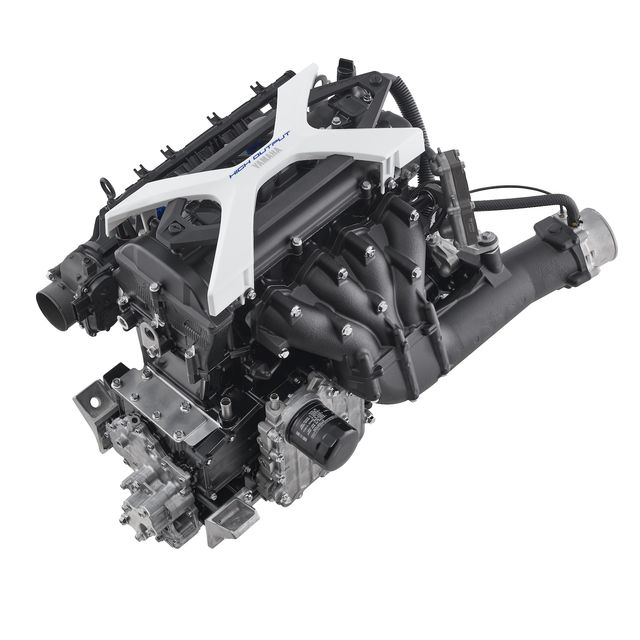
But the marine industry is a different story, and in recent years some of the coolest new engines— Mercury's V-12 , Honda's V-8 —were designed for boats. Which is also the case for Yamaha's new 1.9-liter four-cylinder, which makes 200 hp at 7600 rpm and can be found powering high-output WaveRunners and jet-drive boats. It's not designed for cars, but the Lemons racers among us can dare to dream.
The 1.9-liter four replaces Yamaha's 180-hp 1.8-liter mill and blurs the performance line between the company's naturally aspirated and supercharged engines. Yamaha's supercharged 1.8-liter makes 255 horsepower, but in a WaveRunner there's not a huge practical difference between the boosted 1.8 in a SVHO model and the naturally aspirated 1.9 that powers HOs. Personal-watercraft manufacturers adhere to an agreement that's something like the old German pact to limit top speeds to 155 mph, except on the water the target is 65 mph. That spec includes a 2-mph fudge factor, which naturally means that PWCs of sufficient horsepower top out at an electronically limited 67 mph. Since a 200-hp WaveRunner can hit that limit, the only difference is how quick you get there.

The 1.9-liter, as a new design, enjoys a bundle of changes aimed at durability and refinement. One example: There's an extra bolt connecting the cam chain housing to the block—a little tweak that makes a big difference. "The cam chain room is a thin aluminum casting," says Mark Sagers, senior watercraft factory service technical specialist (in other words, the guy who knows all the engines inside out). "That great big straight piece of aluminum is like a sound board, amplifying the noise of the cam chain. But if you run a fastener from that to the main casting, it knocks that noise way down. That's important when you're sitting right on top of the engine and it's bolted to a guitar body, basically."
Performance-enhancing upgrades include a new exhaust manifold with dedicated pipes for cylinders one and four, a bore increase from 86 mm to 88 mm, and a channel to route cooling water between the exhaust valves to cool the valve seats. The 1.9 even uses about a half-quart less oil than the 1.8, because Yamaha determined that it could cut windage losses (read: increase horsepower) without sacrificing durability. And durability versus performance is always a tradeoff, whether on land or not. "In a 250-cc motocross bike, the maintenance schedule calls for a new piston every nine hours and it's putting out specific power like a NASCAR engine, or almost Indy," says Sagers. "Boats are more on the lower end of high performance, so we can make them last thousands of hours."
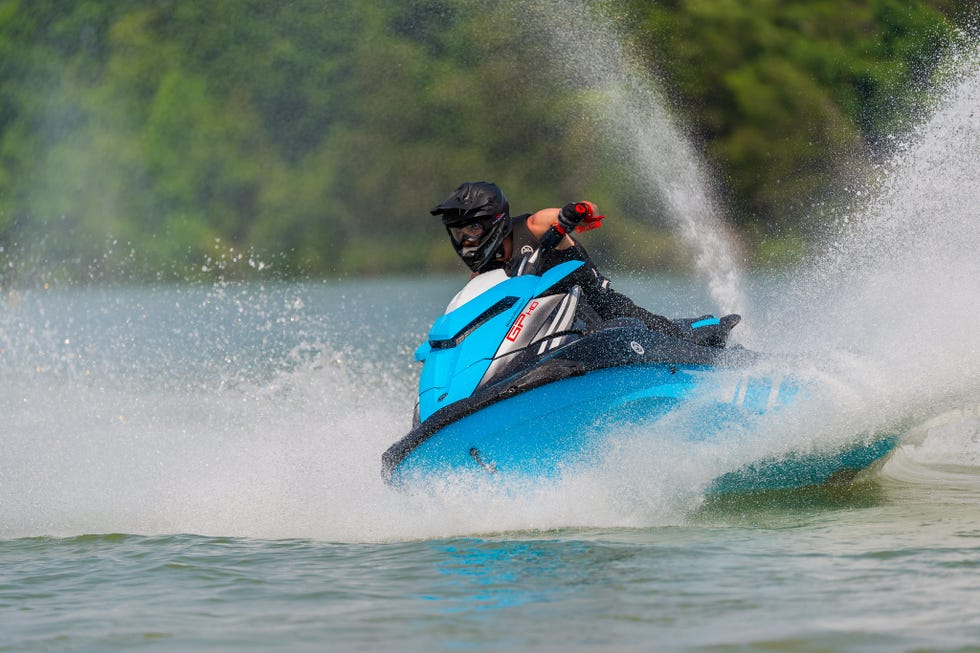
A car engine might well make its horsepower peak beyond 7000 rpm, but it isn't expected to spend much time there. An engine destined for a WaveRunner is a different story. "A lot of the durability testing is done fully loaded at wide open throttle," Sagers says. "These will run a very long time at WOT. Waverunners are often idling or WOT, and there's no middle ground. But I've seen Waverunner engines with more than 1500 hours and no major mechanical work. It's staggering that these mechanical things can live through this."
Still, 200 hp isn't enough for everyone. Logically, it would seem inevitable that this engine will get a supercharger and the 1.8-liter will be retired. Boost prognosticators might find a clue at the 1.9-liter's Coast Guard–mandated intake flame arrester—the intake manifold is cast around it so it can't be sucked into the engine. Which is the kind of thing that would probably only happen if said intake was huffing some major boost. Perhaps soon, it will be.
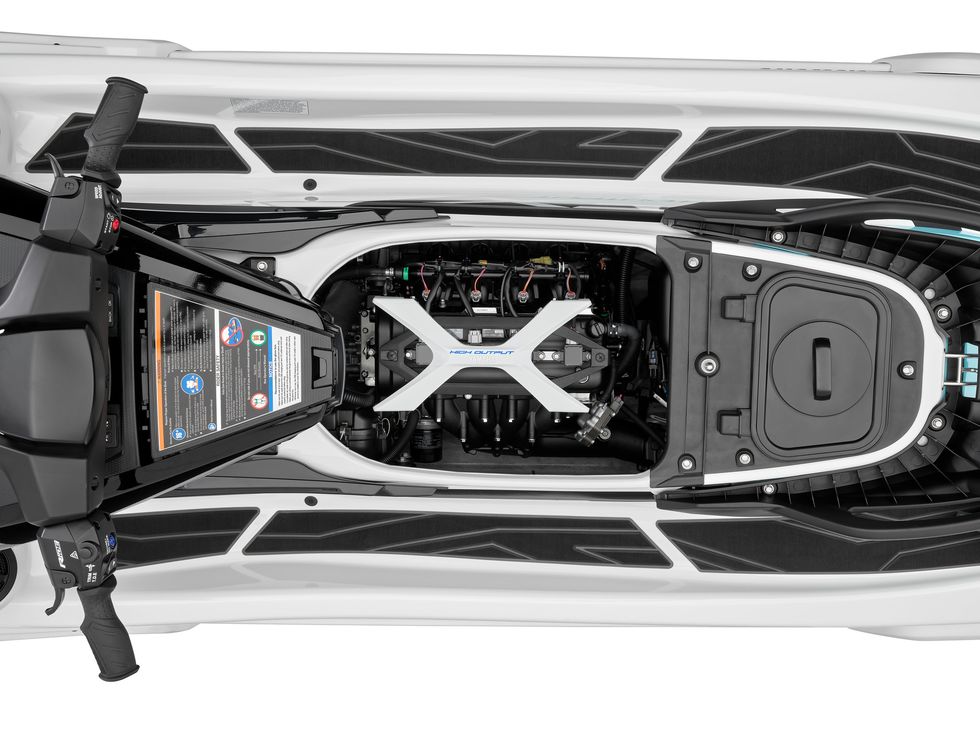
In the meantime, you can break the 200-hp barrier without forced induction. And for twin-engine boats, that means Yamaha is packing 400 horsepower into some of its 22-footers, which we imagine would mean 50-plus-mph top speeds given that the 210 FSH hit 48.0 mph with the 1.8s and their 360 total horsepower.
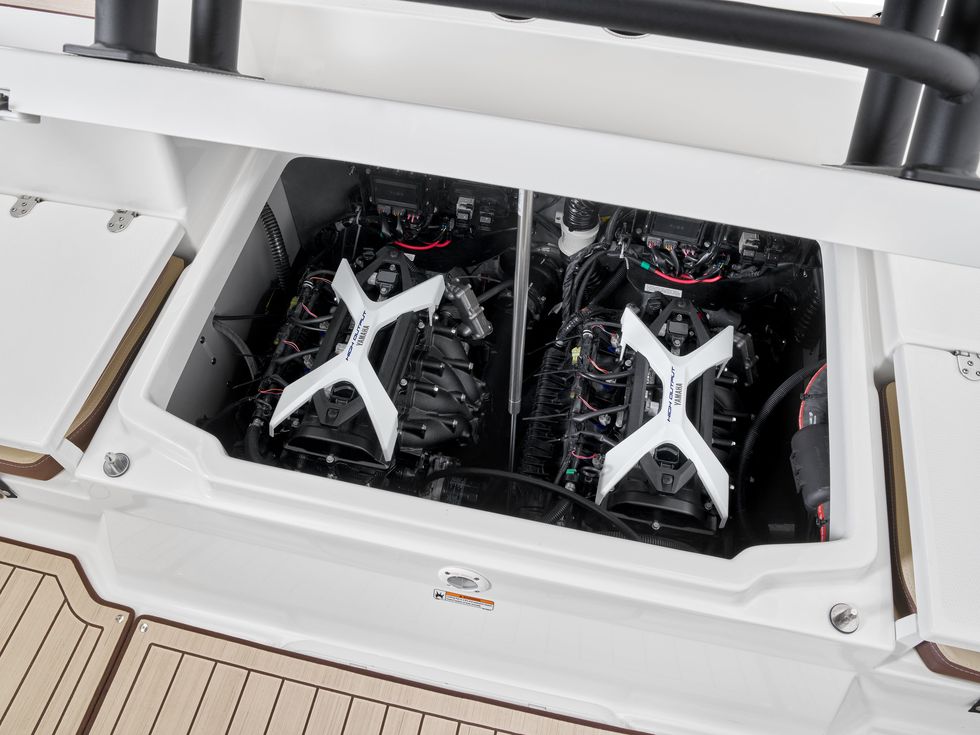
Yamaha has built some nice automotive engines—most famously, the Ford Taurus SHO's —but those of us dreaming of 200-hp Yamaha-powered Miatas will probably have to wait a while for these latest ones to hit the salvage yards. (You can spend that interim figuring out how to adapt a closed-loop cooling system, since the jet drive on these engines doubles as a water pump.)
Calling a powerplant a "boat motor" is traditionally a pejorative, meaning a low-revving hunk of iron, an outdated castoff better suited as a mooring. But motors are electric, and that's where things are heading on the highways. So if you appreciate the mechanical complexity and cleverness of engines, boats are the new—and maybe last—frontier.
Ezra Dyer is a Car and Driver senior editor and columnist. He's now based in North Carolina but still remembers how to turn right. He owns a 2009 GEM e4 and once drove 206 mph. Those facts are mutually exclusive.

.css-190qir1:before{background-color:#000000;color:#fff;left:0;width:50%;border:0 solid transparent;bottom:48%;height:0.125rem;content:'';position:absolute;z-index:-10;} News .css-188buow:after{background-color:#000000;color:#fff;right:0;width:50%;border:0 solid transparent;bottom:48%;height:0.125rem;content:'';position:absolute;z-index:-10;}
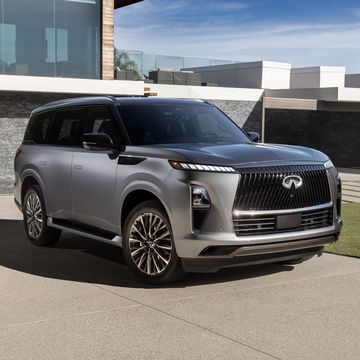
Feds Tighten Emissions Rules to Encourage EVs

2025 Mercedes-Benz GLC350e Plug-In Hybrid Revealed
$101K Wrangler V-8 Final Edition Drops the Mic
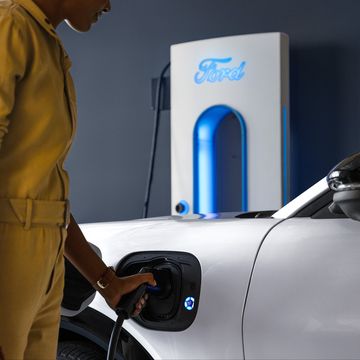
Ford Planning $25,000 Compact EV for 2026: Report
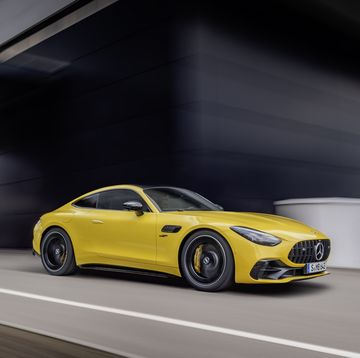
New AMG GT43 Coupe Has 416-HP Turbo Four and RWD

The 2024 Hyundai Santa Fe's Most Notable Features

Hertz CEO Resigns after Buying 100,000 Teslas

2024 Hyundai Santa Fe Has Lots More Cargo Space

Fisker Pauses Production for Six Weeks
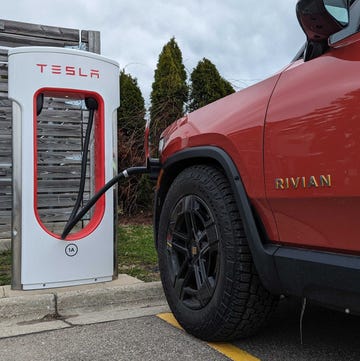
Rivian Models Can Now Use Tesla's Superchargers
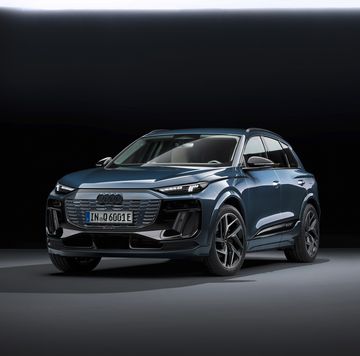
2025 Q6 and SQ6 e-tron Advance Audi’s EV Game
How Erie hospitals plan to deal with traffic issues during April 8 eclipse
Erie's two largest hospitals are preparing for the April 8 eclipse by staggering employee shifts, rescheduling elective procedures, closing certain medical offices and ensuring that ambulances have access to their emergency departments.
VisitErie officials have said the eclipse could draw up to 200,000 visitors to Erie County, which could increase demand for emergency medical services at both UPMC Hamot and Saint Vincent Hospital.
"It's hard to predict what will happen, but we have been running through all types of scenarios," said Dr. Christopher Clark, Saint Vincent president. "The one thing we are pretty sure about, we expect a lot of traffic issues."
Traffic congestion around a hospital can not only prevent ambulances from transporting emergency patients in a timely manner, but also can make it difficult for nurses, doctors, medical technicians and other staff to get to work on time.
UPMC Hamot faces a particular challenge because it is located between two areas of downtown Erie where crowds are expected to gather for the eclipse: Perry Square and Dobbins Landing.
"We're expecting an event similar to the Tall Ships festival , where there is a lot of focus and traffic along the bayfront," said Jason Chenault, Hamot's director of emergency, hospitalist and critical care services. "We want our patients and staff to be able to get to the hospital safely."
Hospitals changing work shifts, closing some medical offices
Hamot is closing many of its medical offices that day, including the UPMC Hamot Surgery Center, and its offices at 380 E. Bayfront Parkway, 100 Peach St. and 300 State St. Many elective surgeries and procedures at UPMC Hamot originally scheduled for April 8 have been rescheduled, Chenault said.
Both Hamot and Saint Vincent are altering typical work schedules so that few, if any, employees arrive or leave the hospital during the eclipse, which will peak around 3:15 p.m. The hospitals also will make a concerted effort to discharge all recovered patients by late morning.
"We are looking at increasing the number of clinical staff who will work 11 a.m. to 11 p.m. that day, assuring that they won't be affected by traffic issues that may pop up in the afternoon," Clark said.
Ambulances will use alternate route to UPMC Hamot
Making sure ambulances have clear access to emergency departments might be the most important concern.
An alternate route to Hamot will be used April 8 that doesn't rely on the Bayfront Parkway, which tends to get congested whenever there are major events at Dobbins Landing or the Bayfront Convention Center.
"We are telling our staff to utilize East 12th Street and Holland Streets when they transport patients to Hamot," said David Basnak, EmergyCare chief executive. "The city plans to implement parking restrictions on Holland to make it easier for our vehicles to get to Hamot."
Boat will transport emergency patients off Presque Isle State Park
Plans are also being made to transport patients who suffer medical emergencies while viewing the eclipse at Presque Isle State Park, Basnak said.
Traffic congestion is expected on the peninsula that afternoon, so the Pennsylvania Department of Conservation and Natural Resources is making plans with EmergyCare and others to transport people by boat.
"DCNR is coordinating those efforts, but the plan right now is to use whatever boat is available, such as a Coast Guard or DCNR boat, to take those people to the Bayfront Convention Center or the Sheraton (Erie Bayfront Hotel)," Basnak said. "That's where we would pick them up and transport them to the hospital.
"We expect it just to be too difficult to drive someone off the peninsula at that time," Basnak said.
Paramedics from Saint Vincent's parent organization, Allegheny Health Network, will be stationed at Presque Isle April 8 to assist with any medical issues, Clark said.
Hamot's and Saint Vincent's emergency departments will be fully staffed April 8. Ophthalmologists will be on call all day at both places, as usual, in case someone suffers an eye injury viewing the eclipse, Clark and Chenault said.
"We don't expect to see a lot of patients with those types of injuries, but we will be prepared," Clark said.
Contact David Bruce at [email protected] . Follow him on X @ETNBruce .

IMAGES
VIDEO
COMMENTS
THE AVAILABLE SPACE. In practical terms, a modern 40ft monohull would have the space for around 1,200W of PV panels (cockpit arch, sprayhood top, deck), maybe 1,500W with the addition of a few portable panels for use at anchor. The 1,200W of fixed position solar array could produce around 360Ah on a sunny summer's day (zero shading) or more ...
It's super easy to set up the solar powered motor systems, like plug and play. Take the above-mentioned Spirit 1.0 Plus as an example, here are 2 simple steps to have the Spirit battery charged via solar energy: Step 1: Connect the solar charger controller to the Spirit battery plus. Step 2: Connect solar charger controller to the solar panel.
This makes the experience of sailing a solar boat much more peaceful. No pollution: on a solar boat, there is no engine producing noise pollution, no carbon or greenhouse gas emissions, and no risk of fuel or oil spills. More space: the absence of engines frees up a lot of space.
The solar-powered Silent 64 is the first model to be built by Silent Yachts. The traveler, he noted, is at the mercy of the vessel's fuel -capacity. While the powerplant or generator is running, the fumes, constant noise and vibration can wear you down as much as sporty conditions and merciless sun. (And the need for maintenance increases.)
He's been living aboard and renovating the boat for the past 3.5 years We're excited to show you the transformation as well as how he plans to propel the boat without the use of diesel or fossil fuels! 5280w Solar System for Electric Powered Catamaran. 16 Rigid solar panels (330w each) 20kwh of Lithium Batteries.
Correct Craft's new GS22E wakesurf boat found a way to twist battery limitations to its advantage. "We've designed the most energy-dense battery system for where a combustion engine ...
This yacht sets sail with solar. The 60 square meters of solar panels produces 30-50 kWh of energy per day, enough to power all of the onboard electronic equipment for around seven hours. Solar-powered Baltic yacht. Baltic Yachts began delivery in July of its Baltic 146 Path, which includes an 8,714 watt solar rooftop and energy storage system ...
1,493 4 minutes read. The new SILENT 60 solar powered catamaran carries 42 solar panels for 17 kWp of solar energy to power two electric motors of up to 2x340kw. Backed up by a battery capacity of up to 286 kWh, the yacht can cruise efficiently with zero emissions solely on solar power for up to 100 nautical miles a day for weeks.
Solar boat engineer and designer Silent Yachts has shared new details of the SILENT-60, a 60′ catamaran with 42 solar panels and two electric propelled motors backed by 286 kWh of battery ...
The electric propulsion is powered by a 48 volt system, meaning it's safe to touch without electrical shock (an ideal situation for maritime fun). Each electric motor on the yacht is powered by ...
The Aditya. The Aditya is India's largest solar boat and the world's first solar-powered ferry. Carrying approximately 1,700 passengers per day, it is 30 times cheaper to run than the diesel ferry ...
With two luxuriously modern solar-powered models, Serenity 64 and Serenity 74, Serenity Yachts offers environmentally sensitive products with plenty of other advantages—like the ability to sail ...
WATTS/AMPS: 400W/22A. SIZE: 4 x 47.0" x 21.3" x 2.0". PROS: Includes x4 100W panels along with a charge controller and everything else needed to set up, ideal for sailors looking for a lot of power, easy mounting system, great price for a comprehensive kit. CONS: Rigid solar panels can only be on flat surfaces or mounted on rails ...
Today, the technology of our in-house developed solar-electric drivetrain has been perfected and is multiple generations ahead in terms of reliability, performance and efficiency. Historical Track-Record. In 2009, the Solarwave 46 was launched as our first prototype of a fully solar-electric, self-sufficient ocean-going catamaran. Since then ...
In this article, I discuss some of the coolest solar-powered catamarans out there! Here are three of the best solar-powered catamarans: Sunreef's 80 Sunreef Power Eco Yacht. Silent Yachts' Silent 80. Soel's Senses 48. There are soo many variables that it's tough to say one is better than the others.
Using Bluetti portable solar panels and portable solar generators to power your boat can offer you various benefits compared to using your engine. For starters, it takes off the excess load from your engine, thereby reducing fuel consumption and allowing you to save a substantial amount on fuel costs in the long run.
Almost any boat can benefit from solar power. Whether at a slip, mooring, or on a trailer, boats can keep their batteries topped off without the need for external power. You can also use solar power to supplement or even replace other onboard charging sources, reducing or eliminating the need to run engines or generators to keep batteries ...
A solar-power installation on a sailboat is made up of two independent systems: one system to charge the batteries, and another system to provide 120-volt AC power for household appliances. In the charging system, the solar panels convert sunlight into electrical current and deliver it to the batteries via a solar charge controller.
The Serenity 64 Yacht features a diesel engine. It is a hybrid solar boat, which means that it can run on either solar power or on diesel. The diesel engine especially comes in handy when the users wish to achieve faster cruising. The solar catamaran is a very spacious electric boat and provides plenty of living space. It is built with four ...
Living on a boat powered by a solar-powered engine is an eco-friendly, cost-saving way to experience the freedom that comes with off-grid living. With no need for fuel or other expensive resources, this type of lifestyle can provide significant savings while still providing enough energy to power all your needs.
Spending a lot of money on solar panels now might not feel ideal, but it is the most cost-effective decision. 1. Renogy Starter Kit. This starter kit is going to be perfect for installing on almost any sized boat. There are four solar panels, each can be fitted permanently to the boat.
Introduced at Sail Expo '93 in Atlantic City, the EXPO Solar Sailer is a brilliant, purposeful little boat. The object is to "solo" a rank beginner in an hour. Despite its utility as an educational tool, the 13-1/ 2-foot boat was dubbed by Naval Architect Bob Perry as "an ideal daysailer for a sailor with a relaxed attitude.".
When engine is off (relay in normally closed) connect that terminal inline with the solar charging. Use your relay control wires to loop in to the ignition circuit of your boat engine, thus when you start the engine, it opens the relay, allowing your alternator to charge the batteries, and when you shut the engine off, the relay closes ...
Welcome to Solar Electric Boat "Solliner" solarboatsUSA.com Your Gateway to Green Boating where Innovation meet sustainability. [email protected] (619) 997-1288 ... This is a basic electric boat model. It has a 3-kW engine with two 210Ah AGM (Absorbent Glass Mat) batteries.
Together, the solar sail quadrants will make up the 17,800-square-foot sail. Marshall leads the solar sail team, which includes Florida-based Redwire Corporation as prime contractor and Huntsville-based NeXolve as subcontractor. ... A complement of 33 Raptor engines, fueled by super-cooled liquid methane and liquid oxygen, powered the Super ...
The nation's first all-electric tug boat has docked at the Port of San Diego and expects to begin emissions-free operations in about a month. Operated by Crowley Maritime Corporation, the 82 ...
NASA's Science Mission Directorate funded Redwire's solar sail technology to reach a new technology readiness level, or TRL 6, which means it's ready for proposals to be flown on space missions.
A car engine might well make its horsepower peak beyond 7000 rpm, but it isn't expected to spend much time there. ... Yamaha stuffs two of these into the 220 FSH, and 400 hp in a 22-foot boat ...
Expect heavy traffic, and likely a slow return trip home Erie is expecting heavy traffic for the April 8 solar eclipse, and not just on our roads It's totally happening April 8 in Erie, Pa. Check ...